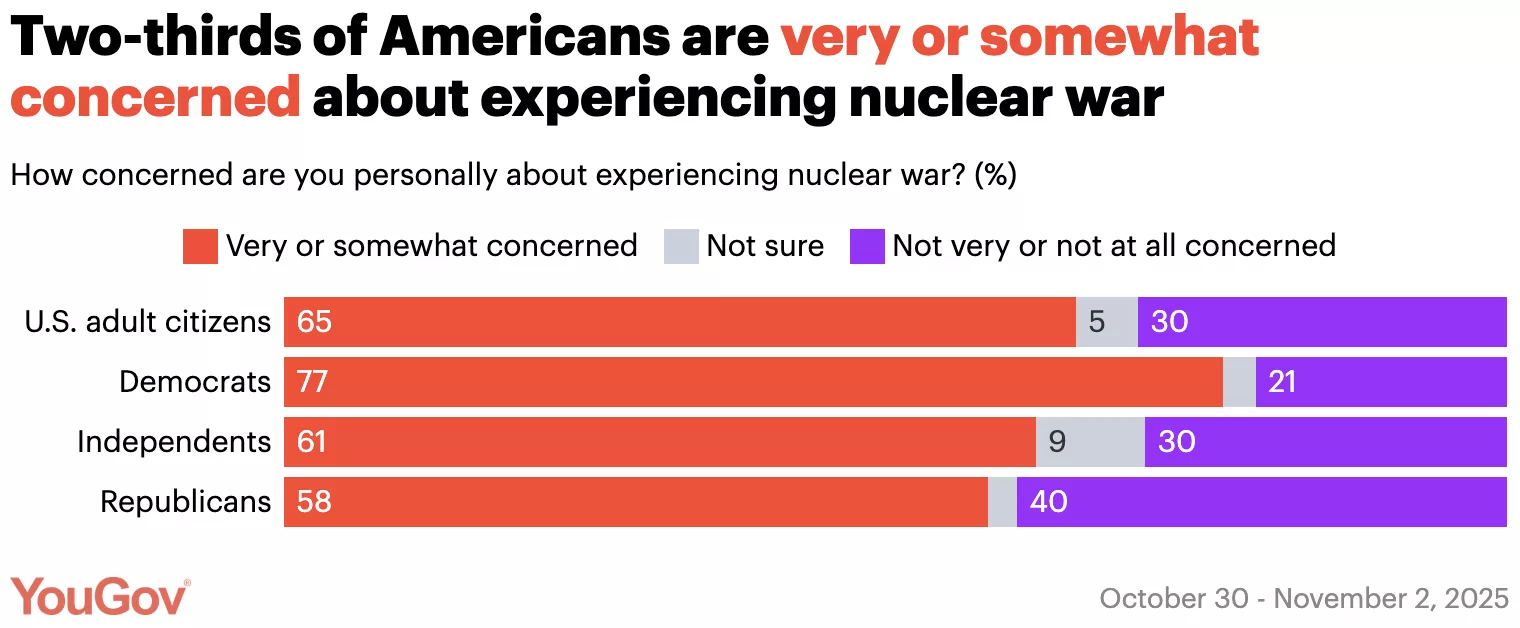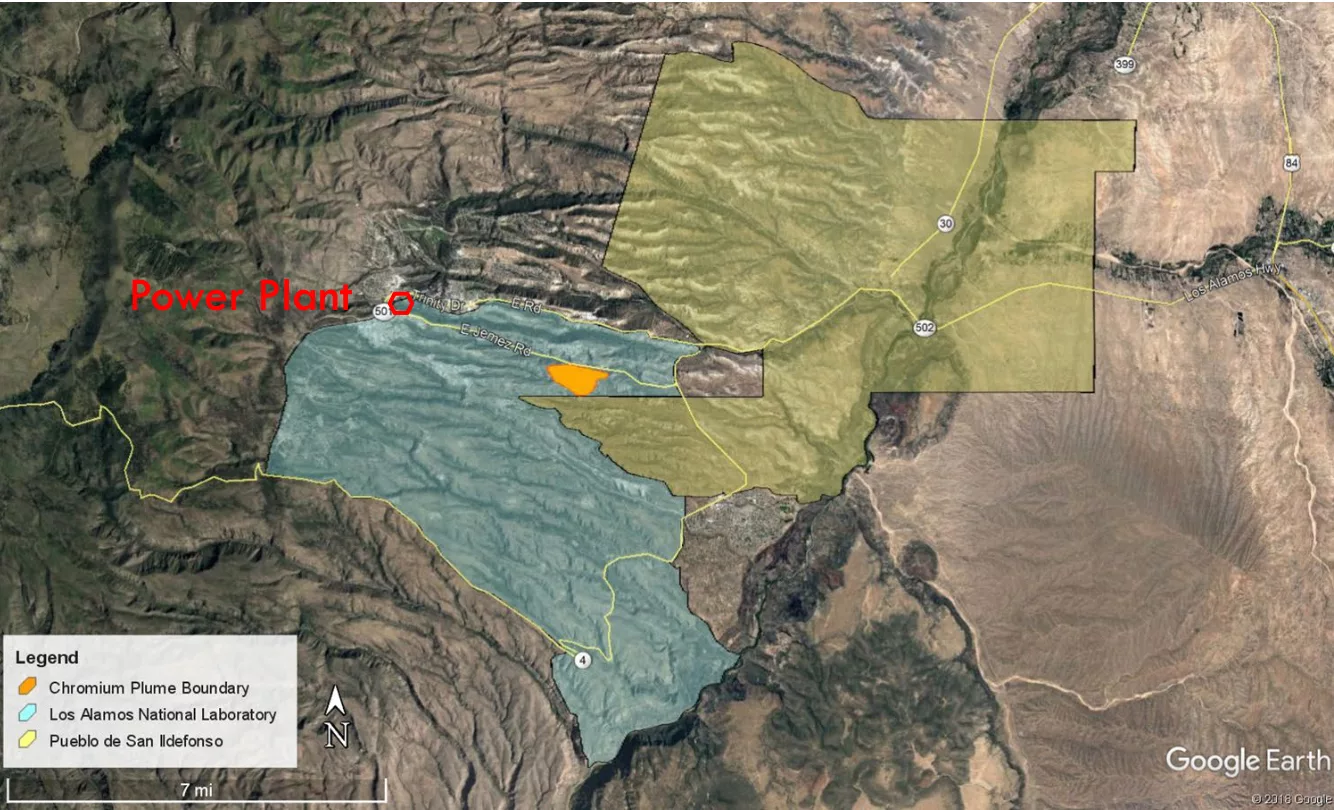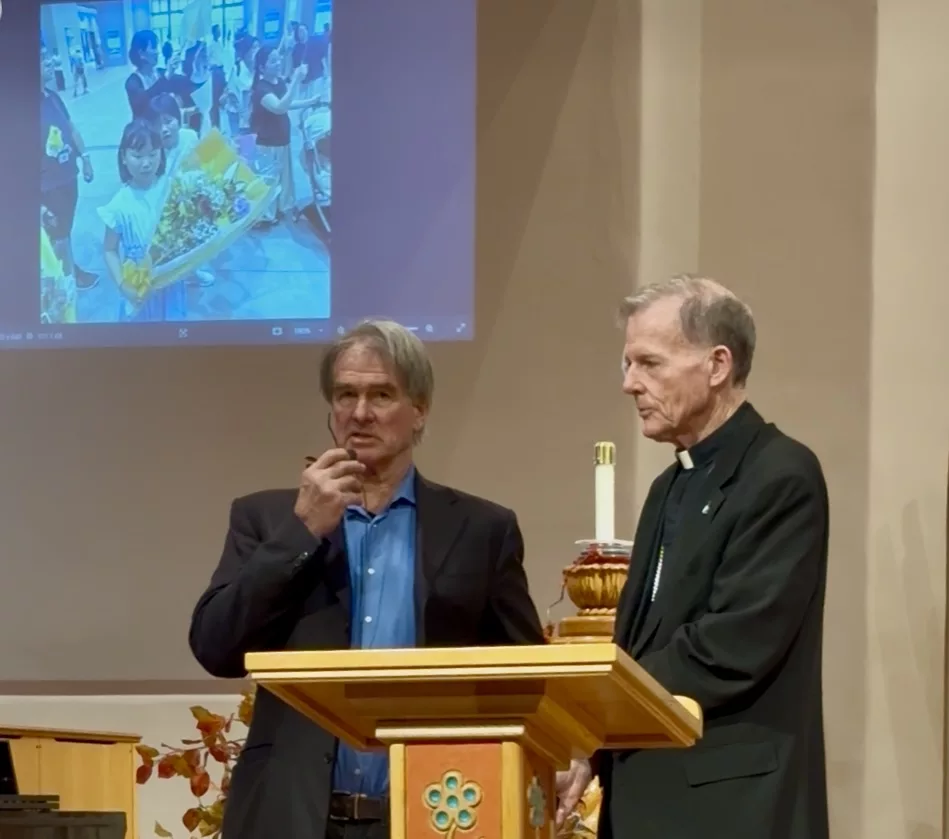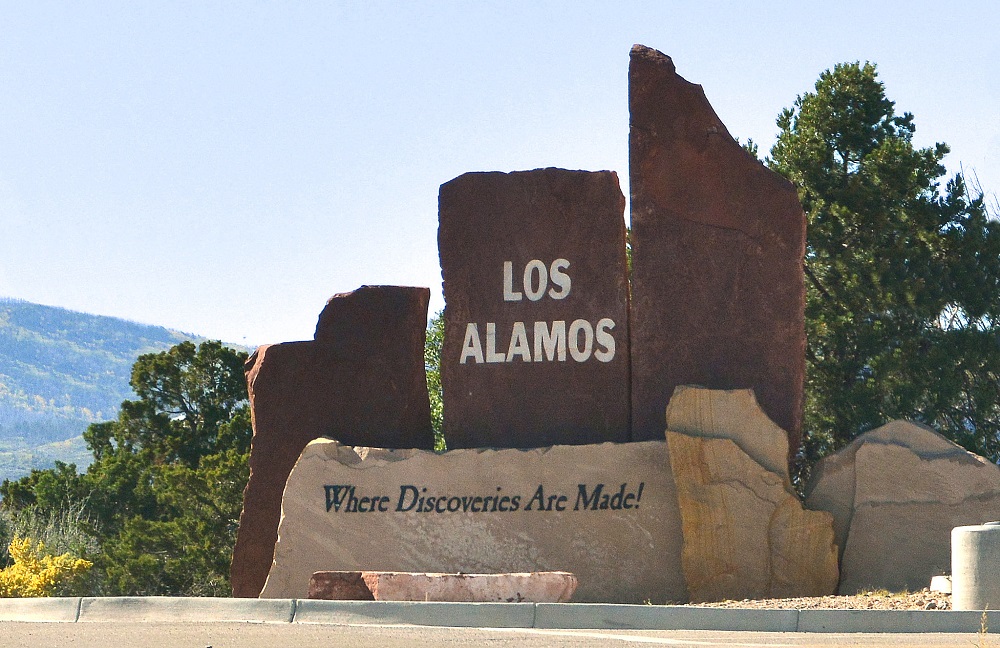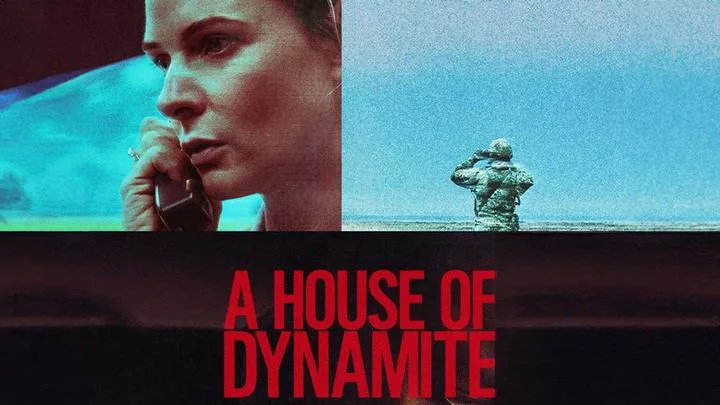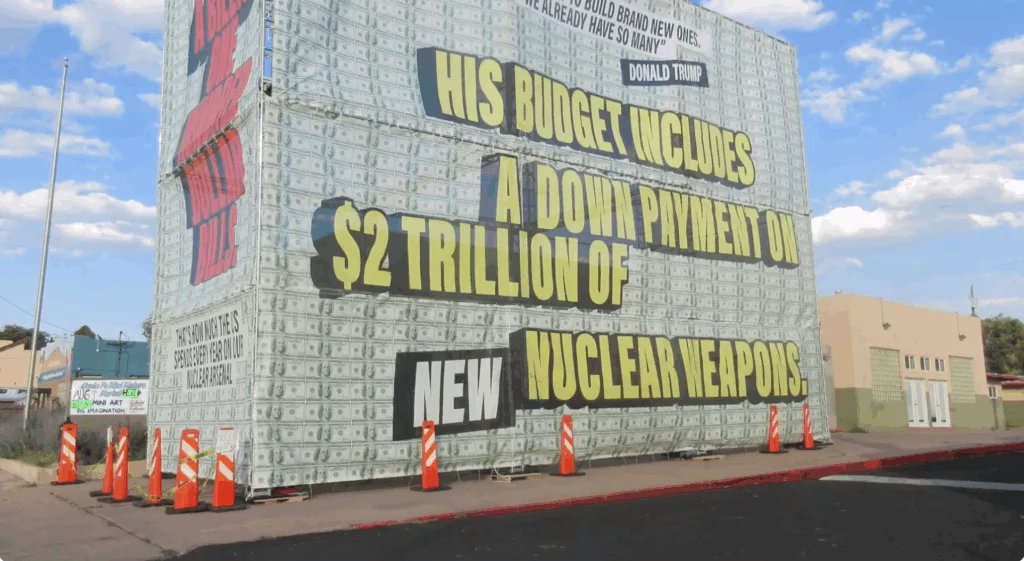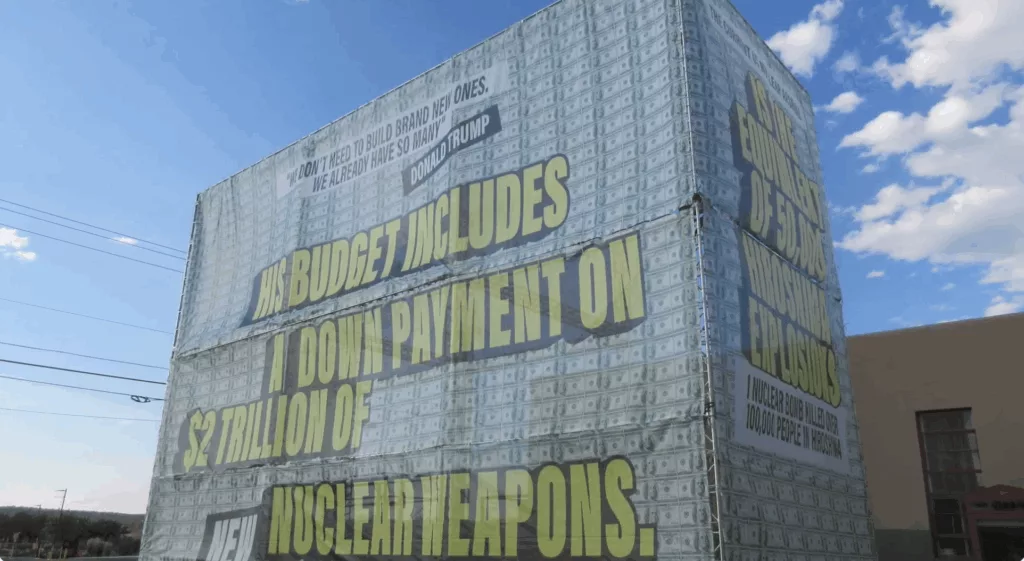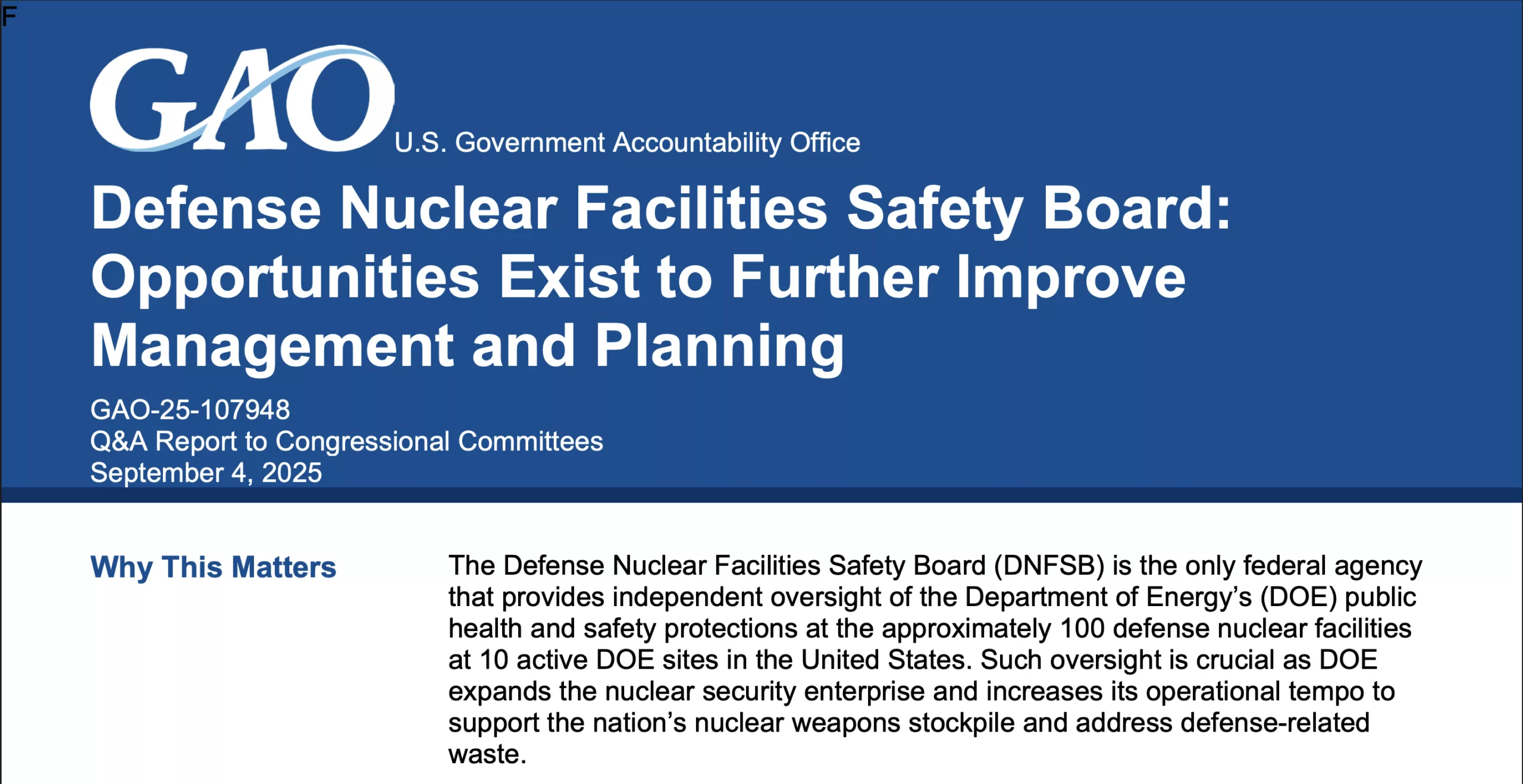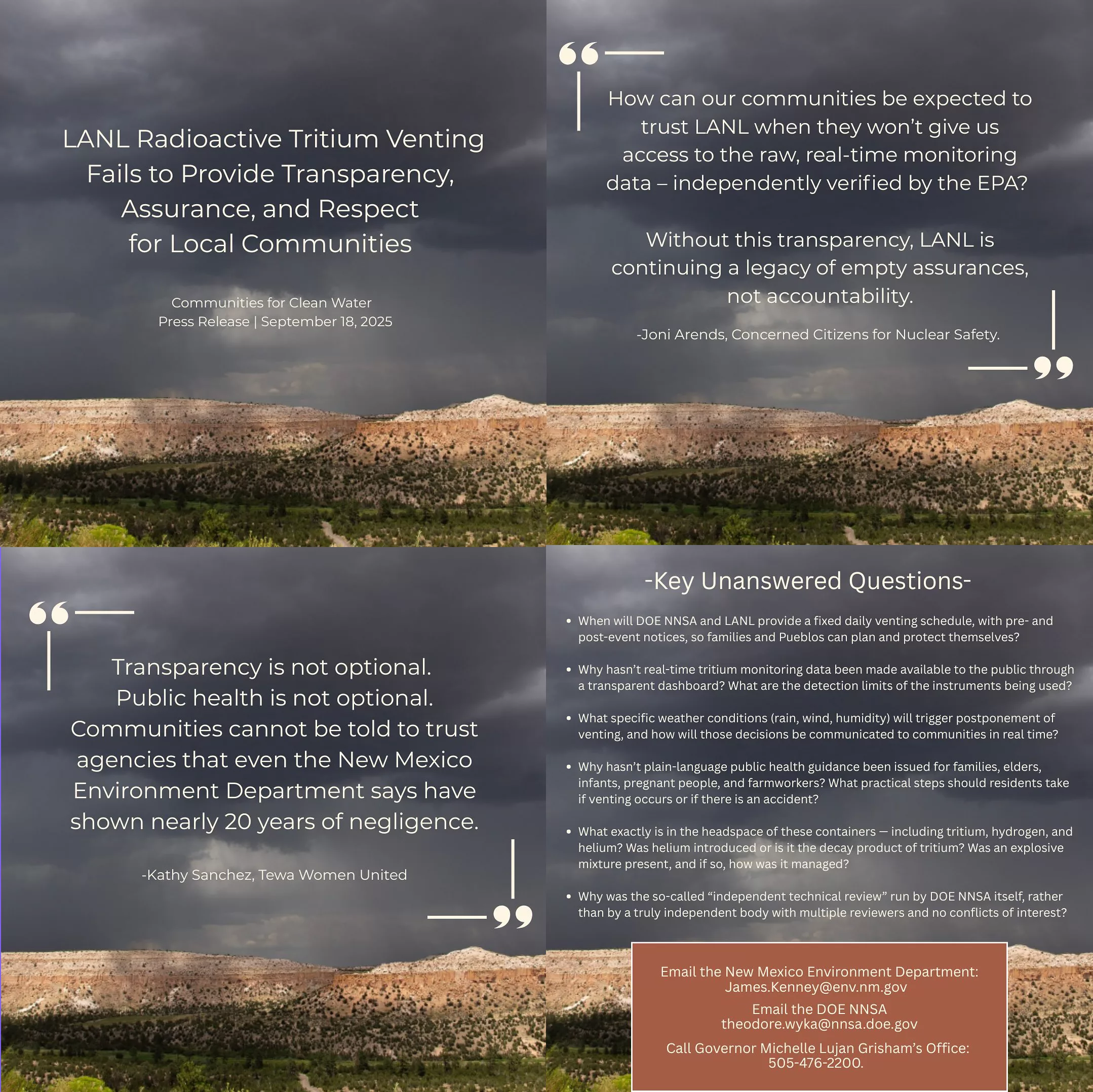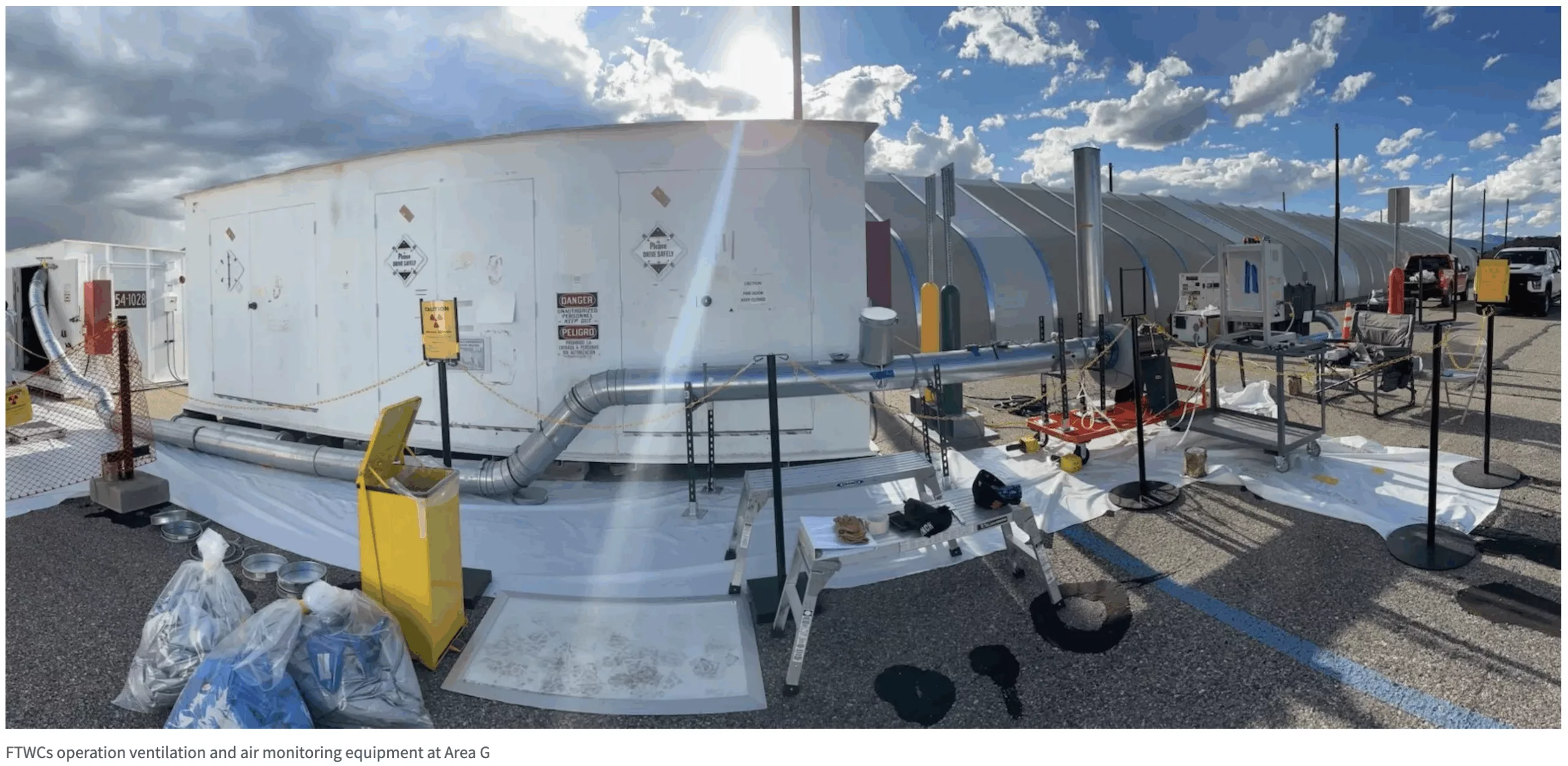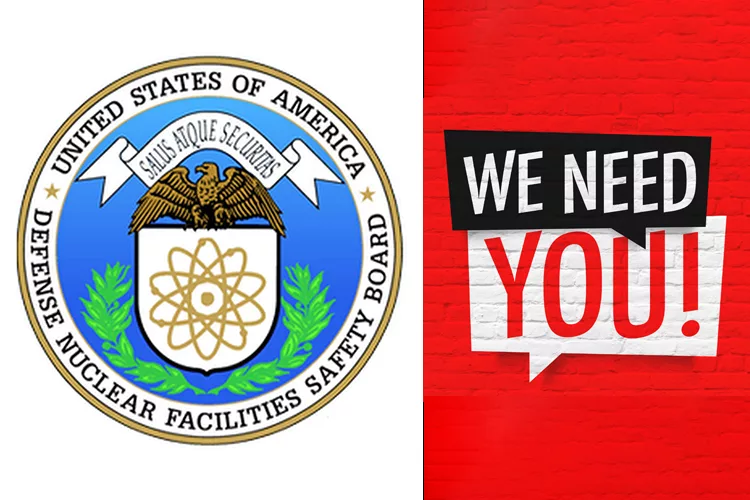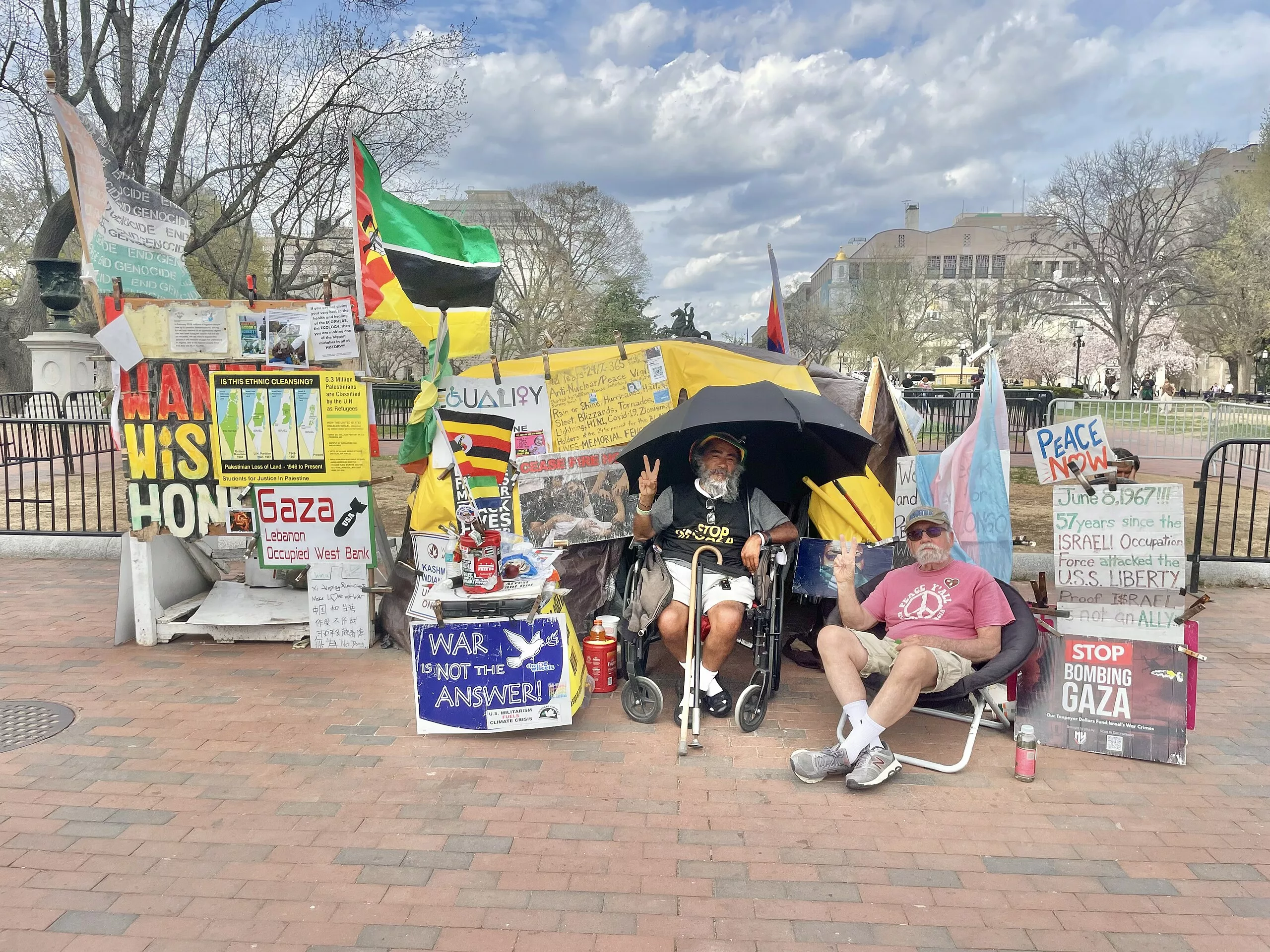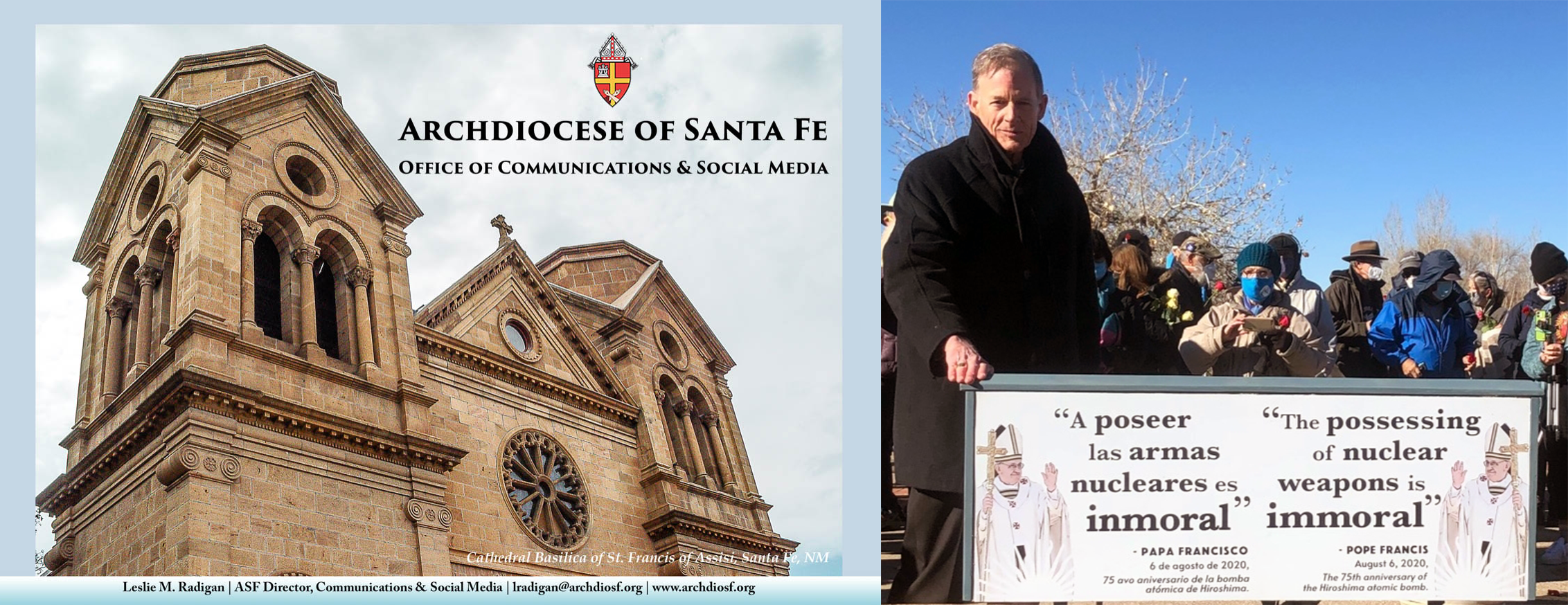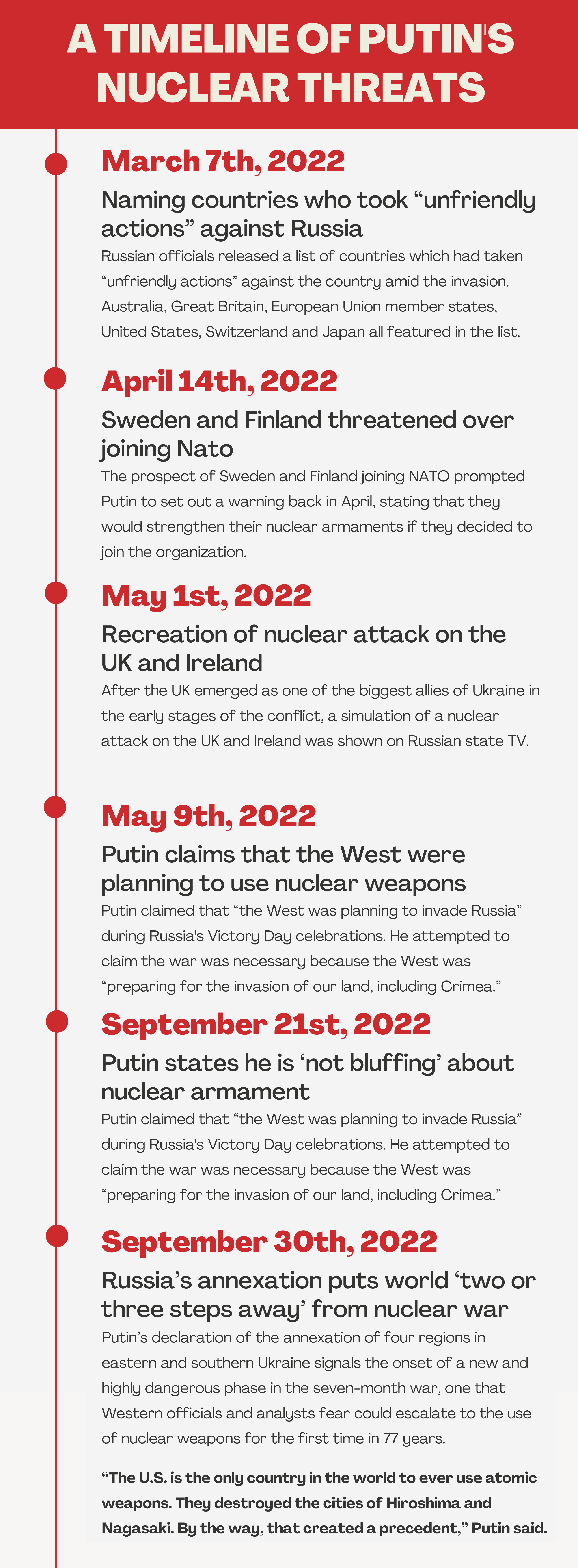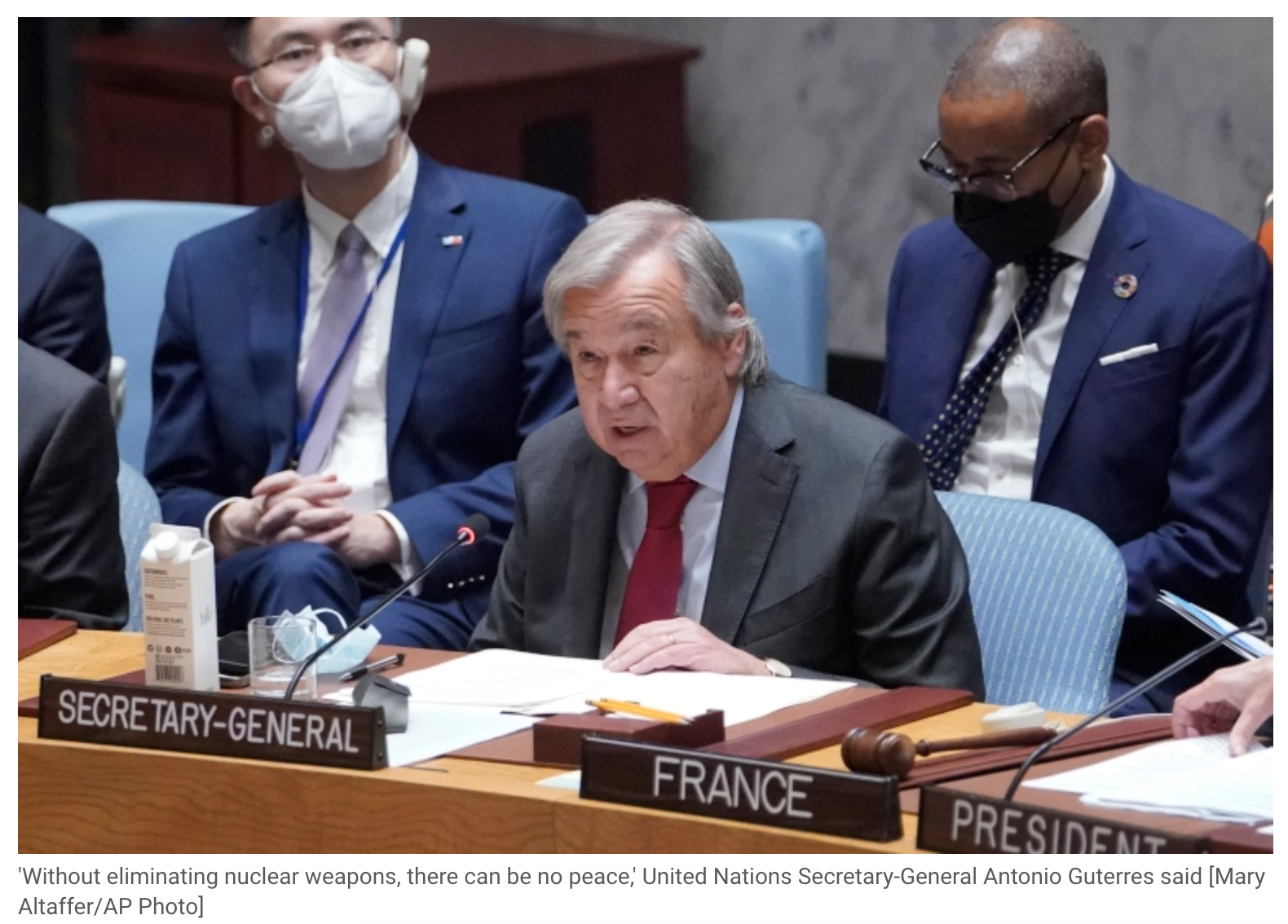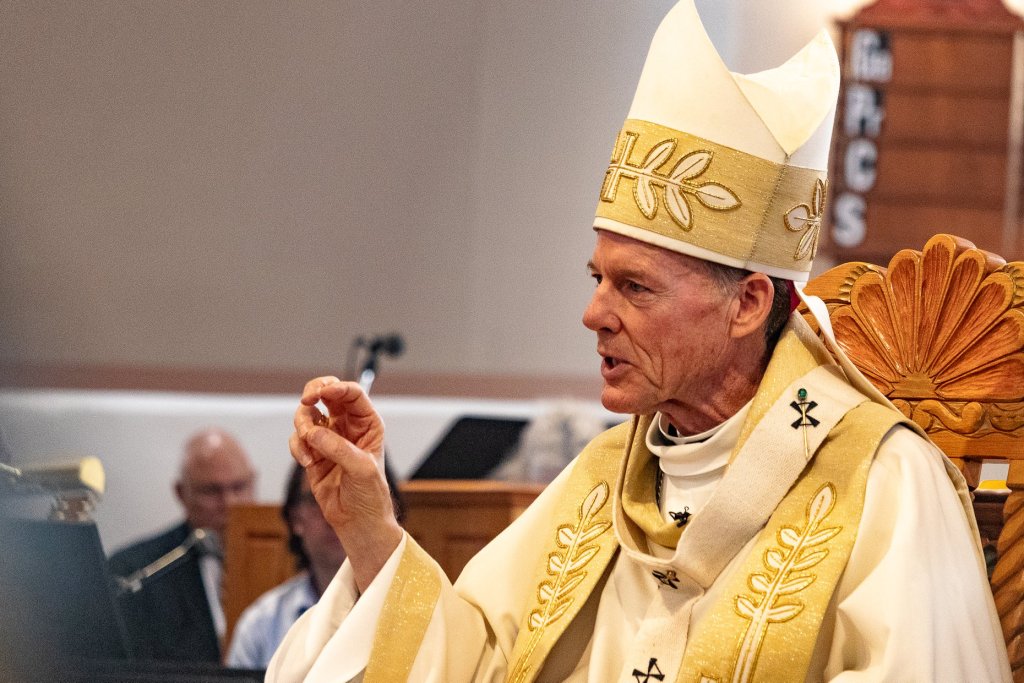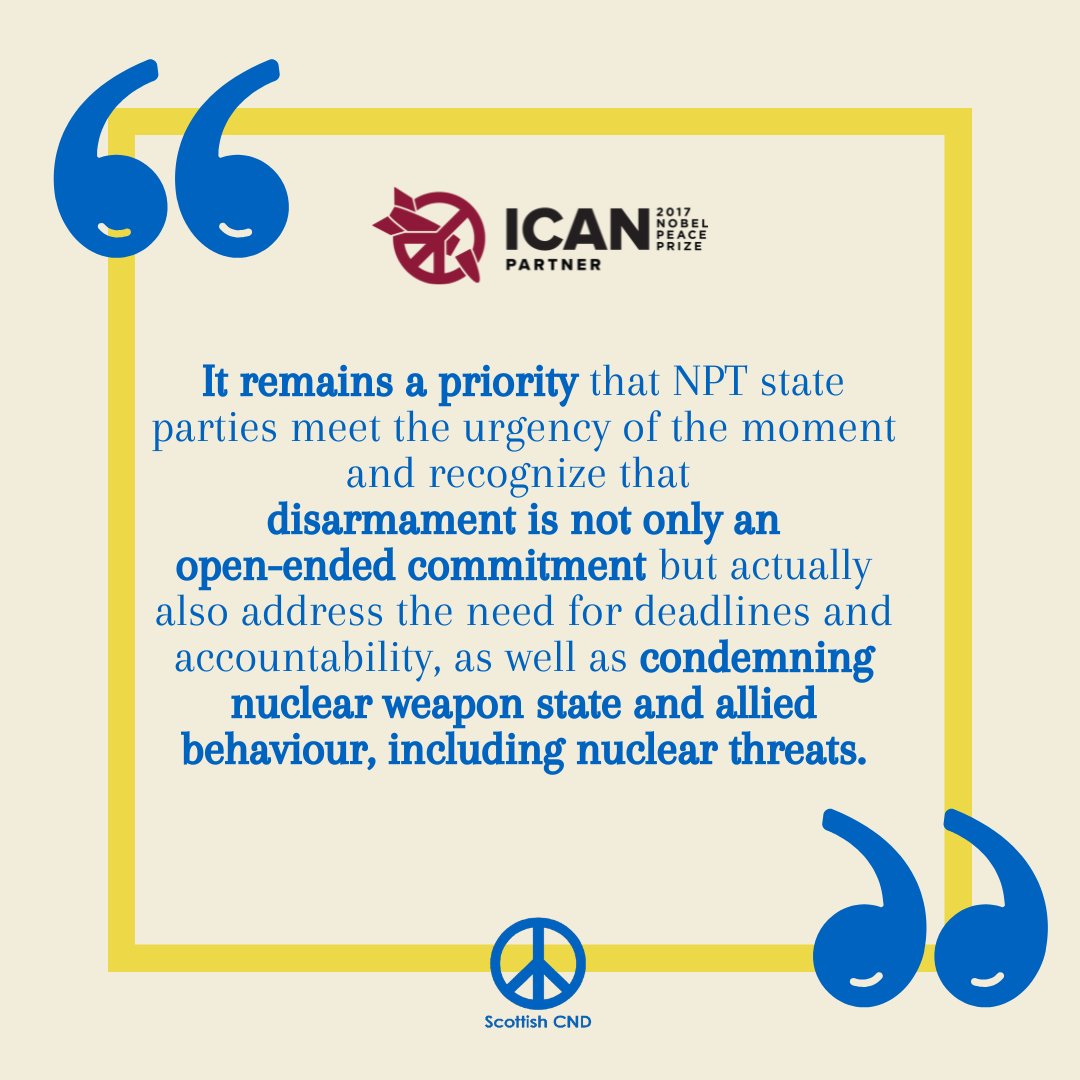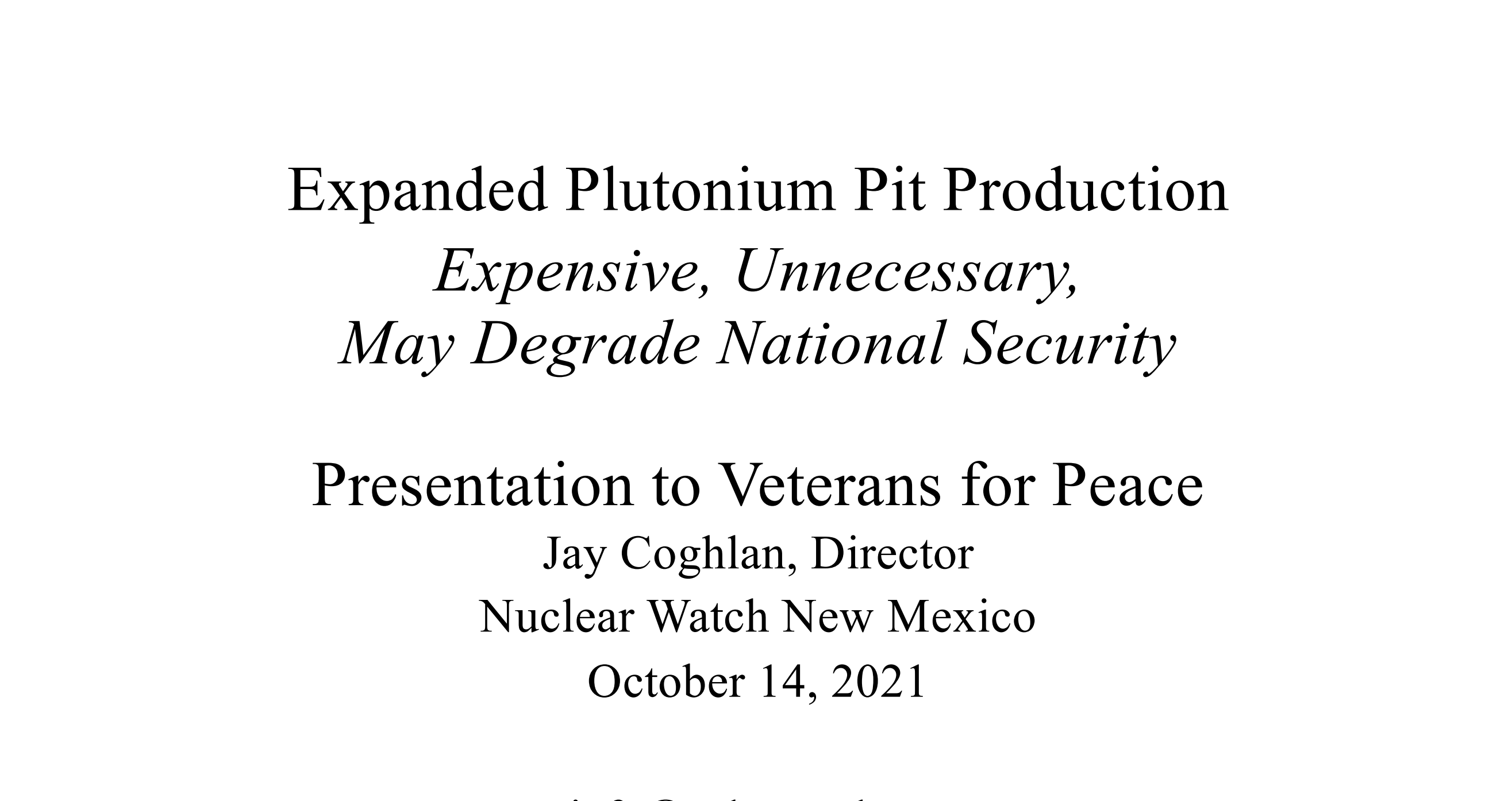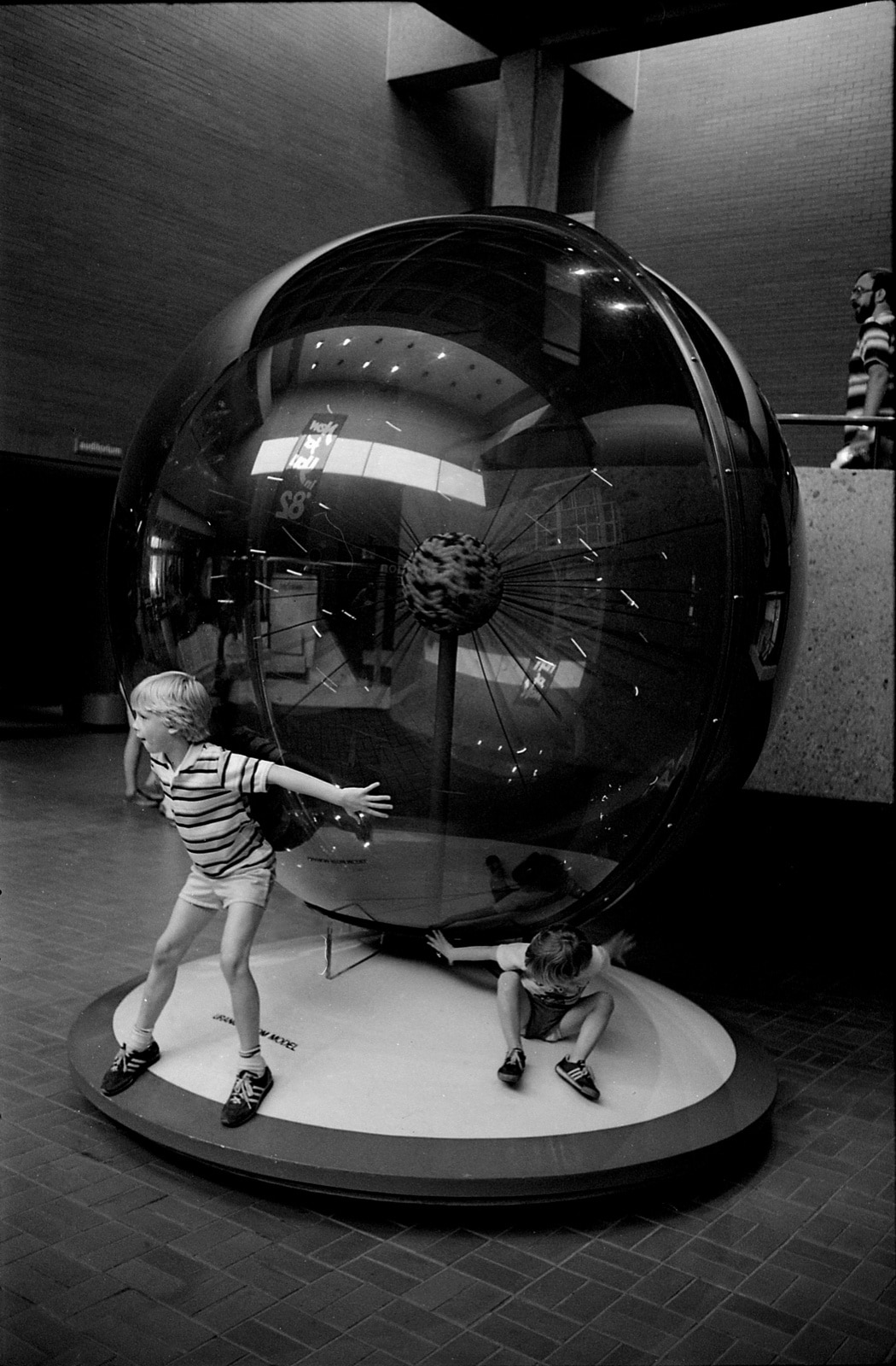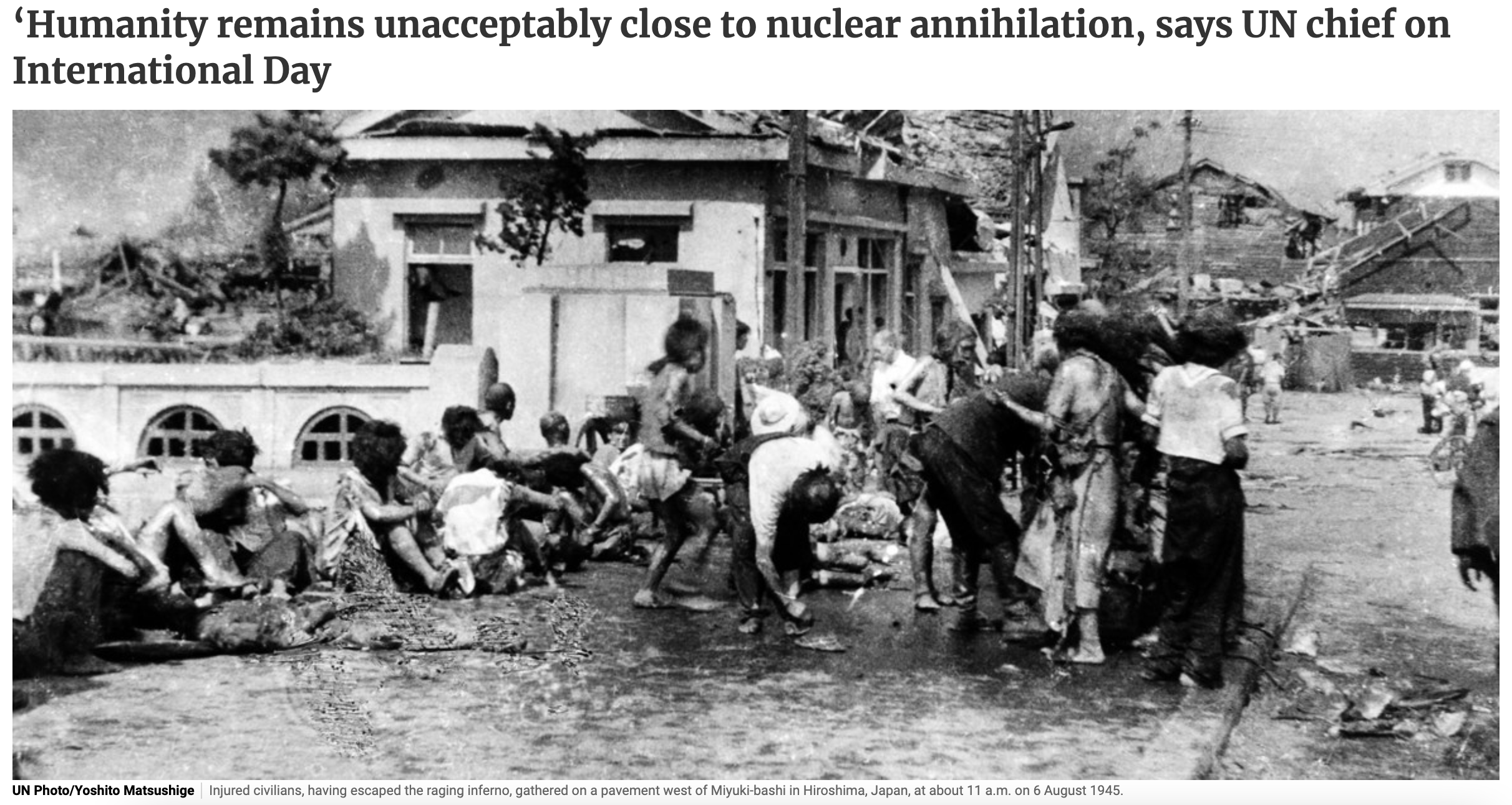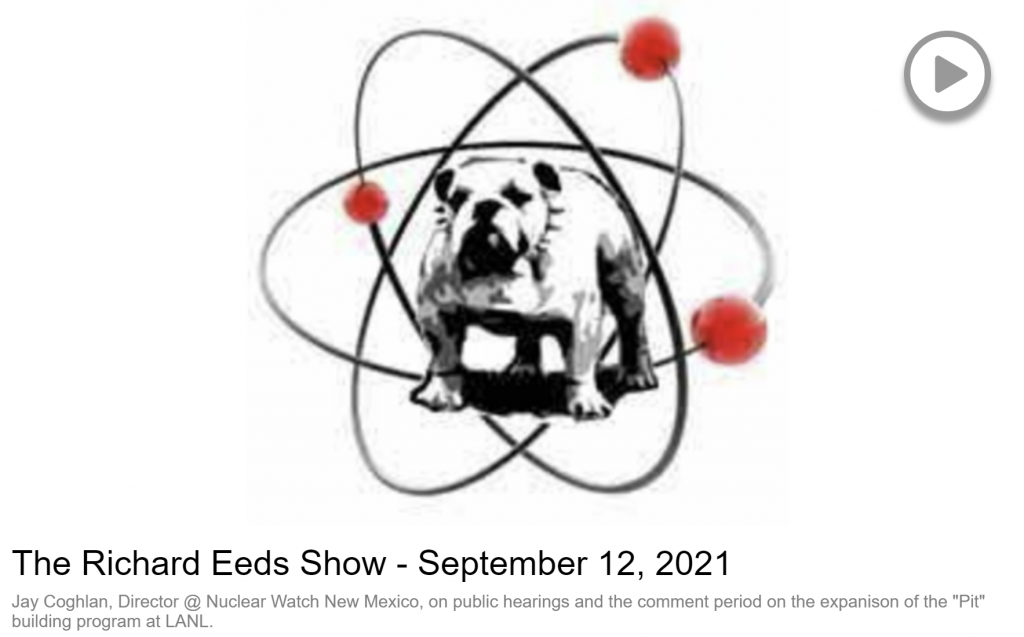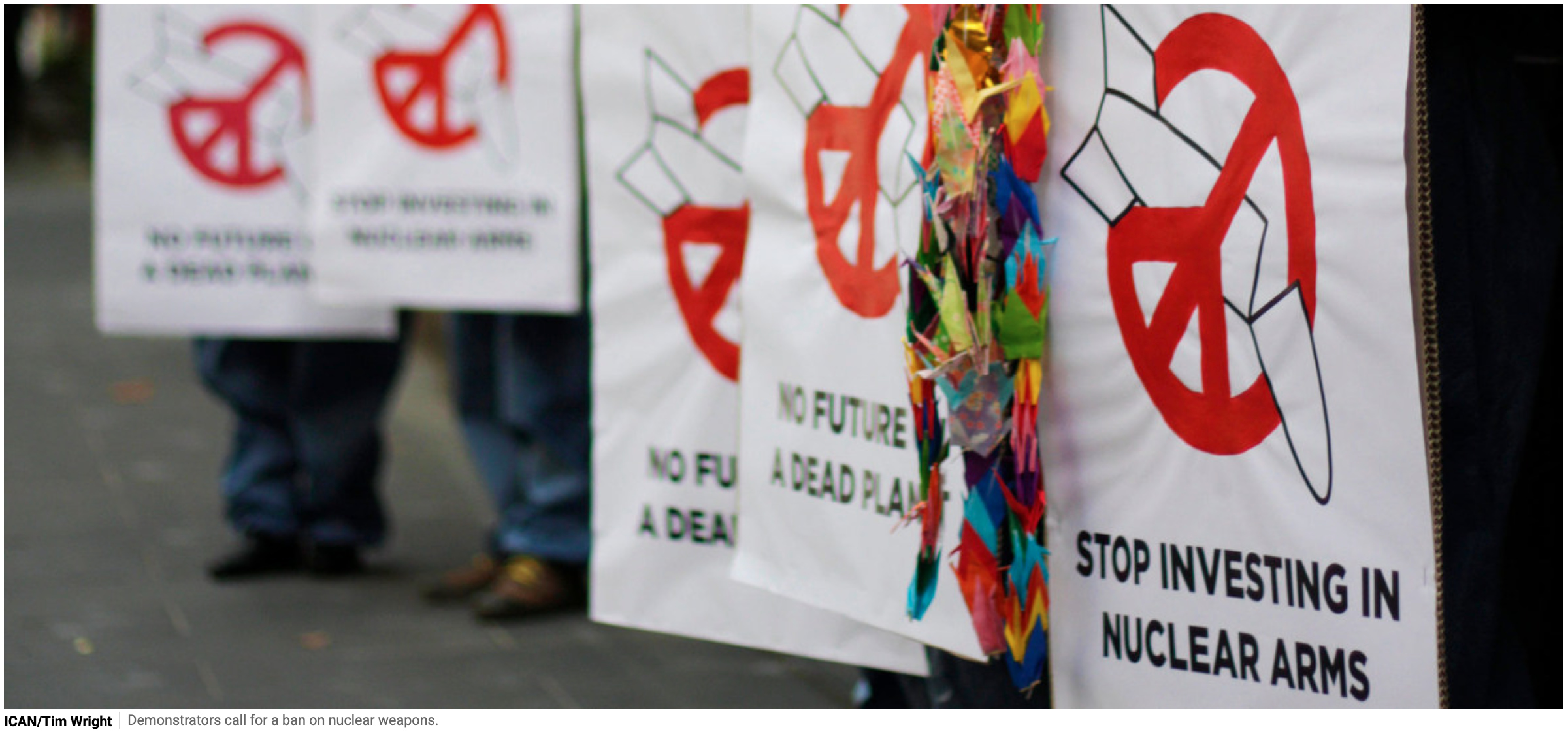Trump talk on nuke testing turns focus to New Mexico’s role in decades of blasts
Jay Coghlan, executive director of the nuclear watchdog group Nuclear Watch New Mexico, said Wright’s comments “somewhat” quelled his initial concerns about a renewed explosive nuclear testing program.
But he said claims Russia and China may be conducting small-scale tests known as hydronuclear tests — banned by the Comprehensive Nuclear Test Ban Treaty, of which the United States, Russia and China are all signatories — continue to give him pause. He fears rumors about the low-yield tests in other nations could be used to justify a domestic return to testing.
“That, in effect, would give permission to the U.S. [to resume testing],” Coghlan said. “But that would be in violation of the norm of the CTBT.”
Three decades removed from the United States’ last nuclear test, a testing regimen would likely be expensive and time-consuming to start up, Coghlan argued, and could prompt other nuclear powers to follow suit.
It seems likely Russia, at least, would: Following Trump’s post, Russian President Vladimir Putin announced if the United States resumed explosive nuclear testing, the Eastern European nation would follow.
“Then everybody else is going to do it, or virtually everybody else will do it, every other nuclear weapons power,” Coghlan said. “I could just see India and Pakistan champing at the bit to test. And then, of course, there’s North Korea and China.”
By Alaina Mencinger amencinger@sfnewmexican.com | November 30, 2025 santafenewmexican.com
It might not have as reverent a name as the Trinity Test or a litany of films made about it. But Project Gnome, a 1961 explosive nuclear test conducted near Carlsbad, is a relic of a bygone era in New Mexico and beyond.
In the 47 years between the Trinity Test and the end of the United States’ explosive nuclear testing in 1992, the nation would perform more than 1,000 such tests — more than any other nuclear nation — with most conducted in Nevada.
New Mexico might not have been the center of the nation’s testing efforts post-Trinity, which marked its 80th anniversary this year, but the state still played a role: Researchers from Sandia National Laboratories and Los Alamos National Laboratory helped design and conduct testing elsewhere, including at the Nevada Test Site and in the Marshall Islands.
Most Democrats and one-third of Republicans think it’s likely the U.S. will get into a nuclear war in the next decade
A new YouGov poll on nuclear weapons finds that nearly half of Americans believe it’s likely the U.S. will get into a nuclear war in the coming decade, and most are worried about personally experiencing a nuclear war. A majority believe nuclear weapons are making the world less safe, but opinions are mixed on whether the U.S. should dismantle all of its nuclear weapons.
By: Jamie Ballard| November 26, 2025 today.yougov.com
46% of Americans think it’s likely the U.S. will get into a nuclear war within the next 10 years; 37% think this is not very or not at all likely. 57% of Democrats and 37% of Republicans think this is likely.
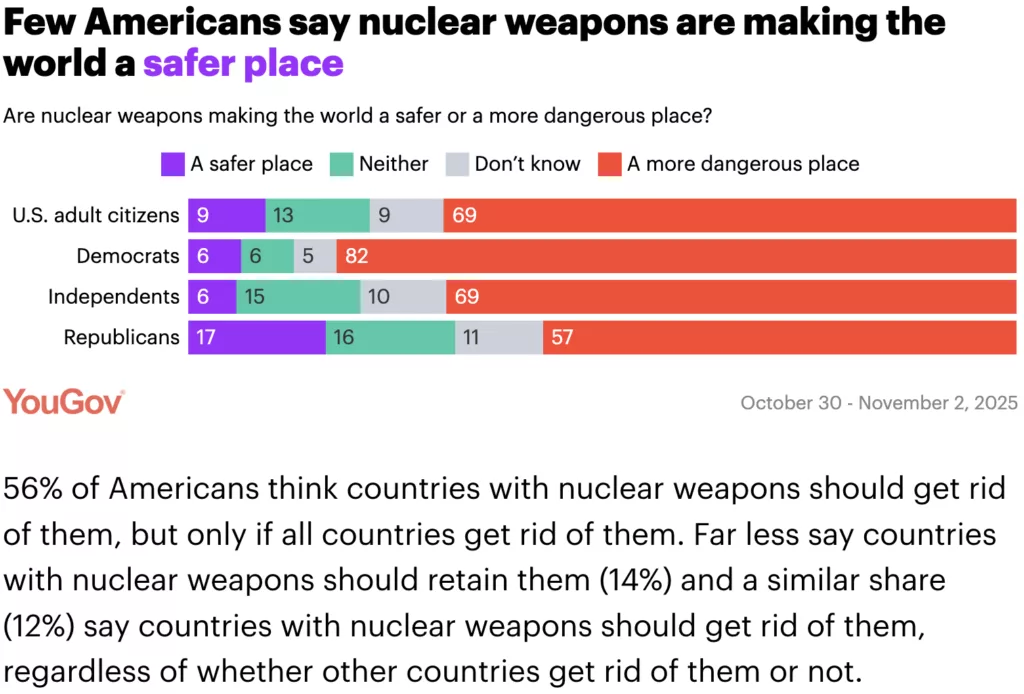
Department of Energy Seeks to Eliminate Radiation Protections Requiring Controls “As Low As Reasonably Achievable”
An internal Department of Energy (DOE) memorandum eliminates worker and public radiation protection rules known “As Low As Reasonably Achievable” (ALARA). This fundamental departure from decades of accepted health physics practices is being promoted by senior DOE political appointees with little background in health or radiation control. It is marked as “URGENCY: High” under the auspices of the DOE Deputy Secretary, the Under Secretary for Science, and the Administrator of the National Nuclear Security Administration. The memorandum awaits the final signature of DOE Secretary Chris Wright.
The memo’s stated goal is to:
“…remove the ALARA principle from all DOE directives and regulations, including DOE Order 458.1, Radiation Protection of the Public and the Environment, NE [Office of Nuclear Energy] Order 458.1, Radiation Protection of the Public, and, upon completion of the rulemaking process, 10 CFR [Code of Federal Regulations] 835, Occupational Radiation Protection.” [1]
It follows the playbook of the Heritage Foundation’s Project 2025, which called for:
“Set[ting] clear radiation exposure and protection standards by eliminating ALARA (“as low as reasonably achievable”) as a regulatory principle and setting clear standards according to radiological risk and dose rather than arbitrary objectives.” [2]
Lab Chromium Contamination Confirmed on San Ildefonso Pueblo Land
Comprehensive Cleanup Needed Instead of More Nuclear Weapons
The New Mexico Environment Department has announced:
“A toxic chromium plume from Los Alamos National Laboratory has spread beyond Lab boundaries onto Pueblo de San Ildefonso land for the first time, with contamination exceeding state groundwater standards… These new results are conclusive evidence that the U.S. Department of Energy’s efforts to contain the chromium plume have been inadequate.”
In reality, chromium groundwater contamination probably migrated beyond the LANL/San Ildefonso Pueblo boundary long ago, with past Lab maps of the plume “magically’ stopping at the border. In the past, tribal leadership has commented that it was fortunate that the contamination stopped there, but that any future indications of groundwater contamination on Pueblo land could have serious consequences. The San Ildefonso Pueblo is a sovereign Native American tribal government.
As late as the late 1990s the Lab was falsely claiming that groundwater contamination was impossible because underlying volcanic tuff is “impermeable.” [1] This ignored the obvious fact that the Parajito Plateau is heavily seismically fractured, providing ready pathways for contaminant migration to deep groundwater. By 2005 even LANL acknowledged that continuing increasing contamination of the regional aquifer is inevitable.[2] Some 300,000 northern New Mexicans rely upon the aquifer for safe drinking water. The potential serious human health effects (including cancer) caused by chromium contamination was the subject of the popular movie Erin Brockovich.
LANL chromium plume spreads onto San Ildefonso Pueblo land, NMED says
Nuclear Watch New Mexico executive direcor Jay Coghlan sees PF-4 as being a bigger scale — and having bigger risks — than the other aging buildings.
“PF-4 is not unique in being old,” Coghlan said. “However, PF-4 is totally unique in currently being the only facility that can process large amounts of plutonium … particularly including plutonium pit production. I think, in part, that’s why the Safety Board focuses more on PF-4 than, to my knowledge, than any other single individual facility.”
By:Patrick Lohmann | November 13, 2025 sourcenm.com
An underground plume of toxic chromium has spread from Los Alamos National Laboratory to Pueblo de San Ildefonso land, state Environment Department officials announced Thursday.
The discovery marks the first time the plume has been detected within the pueblo boundaries, officials said in a news release, though they added the plume’s spread does not pose imminent threats to drinking water in the pueblo or in Los Alamos County. That’s because the plume is not near any known private or public wells, officials said.
Long-term ingestion of hexavalant chromium can cause serious health problems or increase risk of certain cancers.
US Stands Alone Defying UN Vote on Nuclear Test Ban Treaty
Could the LDS Church end an ongoing nuclear weapons project? These veteran activists think so.
By Thalif Deen, Inter Press Sevice | November 12, 2025 ipsnews.net
UNITED NATIONS, Nov 12 2025 (IPS) – The US took another step backward –to break ranks with the United Nations– when it voted against a draft resolution calling for the entry into force of the Comprehensive Nuclear-Test-Ban Treaty (CTBT).
The negative vote followed an announcement by President Trump last month that the US plans to resume nuclear testing after a 33-year hiatus. The US stood alone on the UN vote, which was supported by almost all member States in the General Assembly’s First Committee.
The resolution was adopted by an overwhelming majority: with 168 votes in favor, with one against (United States) and 3 abstentions (India, Mauritius, Syria).
During Trump’s first term, the US abstained on the vote. And in other years they had been voting in favour.
Jackie Cabasso, Executive Director, Western States Legal Foundation, which monitors and analyzes U.S. nuclear weapons programs and policies, told IPS the chaos and uncertainty arose from Trump’s factually-challenged social media post that “because of other countries testing programs, I have instructed the Department of War to start testing our Nuclear Weapons on an equal basis.”
The U.S. government’s first ever “No” vote, on the annual UN resolution in support of the Comprehensive Test Ban Treaty (CTBT), raises further troubling questions about U.S. intentions.
Harking to the MX, Utahns call on LDS Church President Oaks to speak out against nuclear missile being developed in Utah
Could the LDS Church end an ongoing nuclear weapons project? These veteran activists think so.
THE SALT LAKE TRIBUNE | November 9, 2025 sltrib.com
Decades ago, peace activists helped keep a major nuclear weapons system out of Utah with help from key figures, chiefly Spencer W. Kimball, then the president of The Church of Jesus Christ of Latter-day Saints.
Now some of those same individuals are calling on the church’s newly ascended president, Dallin H. Oaks, to follow in his predecessor’s footsteps and speak out against the federal government’s development of a new generation of nuclear missile, known as Sentinel, partly in the Beehive State.
“The arms race continues,” the group of 12 Utahns and one former resident write in a letter mailed to church headquarters in early October, “and a new moral challenge faces” the leaders of the Utah-based faith.
Nuclear Weapons Issues & The Accelerating Arms Race: November 2025
Nuclear weapons:
The government shutdown has impact:
National Nuclear Security Agency confirms 152 furloughed at offices in Albuquerque, Los Alamos
Only 14 employees remain at the two sites By: Danielle Prokop-October 22, 2025
The NNSA confirmed 152 New Mexico employees charged with overseeing national laboratories’ nuclear weapons work were furloughed on Oct. 20, 2025. (Courtesy of NNSA)
The federal government this week sent home more than 150 federal New Mexico employees charged with overseeing national laboratories’ nuclear weapons work, with only 14 employees across two sites remaining at work, the National Nuclear Security Agency confirmed to Source NM.
The furloughs include 71 employees at NNSA’s Los Alamos field office and 81 at the Sandia National Laboratories location, NNSA Deputy Director of Communications Laynee Buckels told Source NM in an email. Seven employees remain at each site, working without pay, she said.
The field offices are responsible for “ensuring compliance with federal contracts to manage and operate the national security assets,” according to the NNSA website
To date there doesn’t appear to be furloughs at LANL, whose employees technically work for a contractor rather than the federal government. Congress is not furloughed, but Speaker Mike Johnson has kept the House out of session. As a result, legislation has come to a screeching halt.
Los Alamos’ plutonium facility safety systems need improvement, oversight board says
Nuclear Watch New Mexico executive direcor Jay Coghlan sees PF-4 as being a bigger scale — and having bigger risks — than the other aging buildings.
“PF-4 is not unique in being old,” Coghlan said. “However, PF-4 is totally unique in currently being the only facility that can process large amounts of plutonium … particularly including plutonium pit production. I think, in part, that’s why the Safety Board focuses more on PF-4 than, to my knowledge, than any other single individual facility.”
By Alaina Mencinger amencinger@sfnewmexican.com | November 7, 2025 santafenewmexican.com
An independent oversight agency wants to see improved safety systems at the facility at the heart of Los Alamos National Laboratory’s plutonium pit mission: PF-4.
The Defense Nuclear Facilities Safety Board reported what it believes to be gaps in a safety analysis drafted for PF-4 and delays in upgrades to safety systems in a letter last month to Energy Secretary Chris Wright.
“Maintaining momentum for these safety infrastructure projects is more important in light of the issues with the safety analysis,” the board wrote in the letter dated Oct. 10. It was signed by former acting chairman Thomas Summers.
LANL Prioritizes Plutonium “Pit” Bomb Core Production Over Safety
The independent Defense Nuclear Facilities Safety Board recently released its Review of the Los Alamos Plutonium Facility Documented Safety Analysis. It concluded that:
“While LANL facility personnel continue to make important upgrades to the Plutonium Facility’s safety systems, many of those projects have encountered delays due to inconsistent funding and other reasons. DOE and LANL should consider prioritizing safety-related infrastructure projects to ensure that the Plutonium Facility safety strategy adequately protects the public, as the facility takes on new and expansive national security missions.” (Page 24)
In early October 2024, the Department of Energy’s semi-autonomous National Nuclear Security Administration (NNSA) announced with great fanfare that the Los Alamos Lab had produced its first “diamond stamped” plutonium pit for the nuclear weapons stockpile. Tens of billions of taxpayers’ dollars have been sunk into LANL’s long delayed and over budget pit production program. Given no further announcements, it is not currently known whether or not the Lab is meeting its congressionally required production goals. Endemic nuclear safety problems have long been an intractable issue, at one point even forcing a three-year halt to plutonium operations at LANL’s Plutonium Facility-4 (“PF-4”).
In its recent Review, the Safety Board reported:
“The [2009] Plutonium Facility safety basis described very large potential [radioactive] dose consequences to the public following seismic events…. DOE committed to upgrade and seismically qualify the ventilation system, with a particular focus on a specific ventilation subsystem…”
“As the only facility in the DOE complex that can process large quantities of plutonium in many forms, [PF-4] represents a unique capability for the nation’s nuclear deterrent. The Board has long advocated for the use of safety-related active confinement systems in nuclear facilities for the purposes of confining radioactive materials…Passive confinement systems are not necessarily capable of containing hazardous materials with confidence because they allow a quantity of unfiltered air contaminated with radioactive material to be released from an operating nuclear facility following certain accident scenarios. Safety related active confinement ventilation systems will continue to function during an accident, thereby ensuring that radioactive material is captured by filters before it can be released into the environment… (Page 2, bolded emphases added)
AP: Trump appears to suggest the US will resume testing nuclear weapons for first time in 30 years
“For Trump, who has cast Russia as a “paper tiger” for failing to swiftly subdue Ukraine, the message is that Russia remains a global military competitor, especially on nuclear weapons, and that Moscow’s overtures on nuclear arms control should be acted on.”
By MICHELLE L. PRICE and CHRIS MEGERIAN | October 30, 2025 apnews.com
BUSAN, South Korea (AP) — President Donald Trump appeared to suggest the U.S. will resume testing nuclear weapons for the first time in three decades, saying it would be on an “equal basis” with Russia and China.
The Kremlin pointed out that a global ban on nuclear tests has remained in place, but warned that if any country resumes nuclear testing Russia would follow suit.
There was no indication the U.S. would start detonating warheads, but Trump offered few details about what seemed to be a significant shift in U.S. policy.
He made the announcement on social media minutes before he met with Chinese leader Xi Jinping on Thursday in South Korea. He offered little clarity when he spoke to reporters later aboard Air Force One as he flew back to Washington.
The U.S. military already regularly tests its missiles that are capable of delivering a nuclear warhead, but it has not detonated the weapons since 1992. The Comprehensive Nuclear Test Ban Treaty, which the U.S. signed but did not ratify, has been observed since its adoption by all countries possessing nuclear weapons, North Korea being the only exception.
REUTERS: Trump tells Pentagon to immediately resume testing US nuclear weapons
“Russia – which tested a new nuclear-powered cruise missile on October 21, held nuclear readiness drills on October 22 and tested a new nuclear-powered autonomous torpedo on October 28 – said it hoped Trump had been properly informed that Moscow had not tested a nuclear weapon itself.”
By Trevor Hunnicutt, Ismail Shakil and Kanishka Singh | October 30, 2025 reuters.com
VIEW THE RECORDING: Santa Fe Ecumenical Conversations Towards Nuclear Disarmament at Santa Maria de la Paz Catholic Community – Monday, October 27
Archbishop John C. Wester and NukeWatch New Mexico presented a special evening at Santa Maria de la Paz Catholic Community on Monday, October 27, from 6:00 to 8:00 p.m. MT. Following a presentation from NukeWatch executive director Jay Coghlan on U.S. nuclear weapons “modernization,” the Archbishop shared reflections from his pastoral letter, Living in the Light of Christ’s Peace, and speak about the importance of dialogue and hope in working toward nuclear disarmament.
View the recording at https://www.youtube.com/watch?v=9LFmQzMoJds&t=1s
Trump Orders Nuclear Weapons Testing for New Nuclear Arms Race
New Plutonium “Pit” Bomb Cores at Los Alamos Lab Could Make It Real
Just minutes before meeting with Chinese President Xi Jinping, Trump posted on his Truth Social media platform that “Because of other countries testing programs, I have instructed the Department of War to start testing our Nuclear Weapons on an equal basis. That process will begin immediately.” House Speaker Mike Johnson soon followed on CNN saying, “I think it is an obvious and logical thing to ensure that our weapons systems work.”
No other countries are currently testing nuclear weapons (the last was by North Korea in 2017). Further, any nuclear weapons tests by the U.S. would be performed by the Department of Energy (whose last test was in 1992), not the Department of War (until recently the Department of Defense). Trump was likely referring to Vladimir Putin’s recent claims of a new nuclear powered cruise missile and a tsunami-causing nuclear-armed torpedo that could threaten America’s coastal cities. In addition, China is dramatically expanding its own fleet of intercontinental ballistic missiles.
But central to all this is the U.S.’ own $2 trillion “modernization” program that will rebuild every nuclear warhead in the planned stockpile with new military capabilities and produce new-design nuclear weapons as well. This so-called modernization program will also build new nuclear weapons production facilities expected to be operational until ~2080, and buy new missiles, subs, and bombers from the usual rich defense contractors, all to keep nuclear weapons forever.
‘Nuclear weapons are blasphemous’: Archbishop Wester continues disarmament push with talk
This event was organized by the “Santa Fe Ecumenical Conversations Towards Nuclear Disarmament” group at the Santa Maria de la Paz parish near the Santa Fe Community College. They kindly invited NukeWatch to speak before Archbishop Wester for what turned out to be a wonderful event. The full recording can be viewed at https://www.youtube.com/@SMDLP/streams
By Cormac Dodd cdodd@sfnewmexican.com | October 28, 2025 santafenewmexican.com
Despite saying he has received a somewhat muted response from the local faithful, Santa Fe’s Catholic archbishop is still pushing nuclear disarmament as vital to humanity’s spiritual well-being and continued existence.
“I think nuclear weapons are blasphemous, because I think nuclear weapons are humanity’s attempt to build a Tower of Babel, an attempt to eat from the apple of the tree of the Garden of Eden, to become like God, to become gods,” Archbishop John C. Wester said in a roughly 30-minute address at Santa Maria de la Paz Catholic Church south of Santa Fe.
“In humility, we must avoid inventing anything that, in a matter of hours, can destroy what God has created,” the leader of the Archdiocese of Santa Fe continued. “The story of Adam and Eve is archetypal, I think: When human beings try to become as God, they lose the Garden of Eden and they must endure the cruel reality of paradise lost.”
The archbishop’s comments followed a journey he undertook to Japan on the 80th anniversary of the U.S. military’s decision to drop atomic bombs on Hiroshima and Nagasaki toward the end of World War II. He spoke in front of an audience of about 50 people — who gave Wester a standing ovation — at Monday’s event
In a Looming Nuclear Arms Race, Aging Los Alamos Faces a Major Test
The lab where Oppenheimer developed the atomic bomb is the linchpin in the United States’ effort to modernize its nuclear weapons. Yet the site has contended with contamination incidents, work disruptions and old infrastructure.
By Alicia Inez Guzmán | October 28, 2025 The New York Times nytimes.com
In a sprawling building atop a mesa in New Mexico, workers labor around the clock to fulfill a vital mission: producing America’s nuclear bomb cores.
The effort is uniquely challenging. Technicians at Los Alamos National Laboratory must handle hazardous plutonium to create the grapefruit-size cores, known as pits. They do so in a nearly 50-year-old building under renovation to address aging infrastructure and equipment breakdowns that have at times disrupted operations or spread radioactive contamination, The New York Times found.
Now, the laboratory is under increasing pressure to meet the federal government’s ambitions to upgrade the nation’s nuclear arsenal. The $1.7 trillion project includes everything from revitalizing missile silos burrowed deep in five states, to producing new warheads that contain the pits, to arming new land-based missiles, bomber jets and submarines.
But the overall modernization effort is years behind schedule, with costs ballooning by the billions, according to the Congressional Budget Office. In 2018, Congress charged Los Alamos with making an annual quota of 30 pits by 2026, but by last year it had produced just one approved for the nuclear stockpile. (Officials have not disclosed whether more have been made since then.)
*The featured image differs from the article photo due to usage rights.
Why Putin’s ‘invincible’ nuclear-powered missile is more likely to become a disastrous ‘flying Chernobyl’ for Russia
The US abandoned efforts to build nuclear-powered missile weapons during the 1950s arms race with the Soviet Union as a nuclear-powered missile would effectively be a huge radiation risk.
Jeffrey Lewis, a nuclear nonproliferation expert at Middlebury College, described it as a “tiny flying Chernobyl,” referencing the Soviet power plant that melted down and covered a 1,600-mile area with toxic radiation…While Lewis believes the Burevestnik is only capable of subsonic speed and easy to intercept, he warned that Russia’s ambition poses a return to the Cold War era.
“NATO aircraft could intercept it. The problem is that Burevestnik is yet another step in an arms race that offers no victory for either side,” he wrote on X.
By Ronny Reyes | October 28, 2025 nypost.com
Russian strongman Vladimir Putin’s latest threats that Moscow is preparing to deploy its new “invincible” nuclear-powered cruise missile has drawn a rebuke from President Trump and a reminder of America’s own nuclear might.
But experts say the Burevestnik missile could end up being more like a disastrous “flying Chernobyl” for Russia — and proves Putin is actually nervous about the possibility of the US giving Tomahawk cruise missiles to Ukraine.
George Barros, of the Washington-based Institute for the Study of War, described Putin’s ominous Sunday announcement as a form of fear mongering from a Kremlin afraid that the US could give Kyiv a much more conventional weapon — the tried and true Tomahawk.
Russia tested new nuclear-powered Burevestnik cruise missile
“For Trump, who has cast Russia as a “paper tiger” for failing to swiftly subdue Ukraine, the message is that Russia remains a global military competitor, especially on nuclear weapons, and that Moscow’s overtures on nuclear arms control should be acted on.”
By Guy Faulconbridge and Lidia Kelly Tim Balk | October 26, 2025 reuters.com
- Russia tests nuclear-capable Burevestnik missile
- Missile flew for 14,000 km, 15 hours
- Putin says it can pierce any missile defences
Trump Administration Providing Weapons Grade Plutonium to Sam Altman
“If there were adults in the room and I could trust the federal government to impose the right standards, it wouldn’t be such a great concern, but it just doesn’t seem feasible.”
By: Joe Wilkins | October 24, 2025 futurism.com
With the economy the way it is these days, it’s nice to have a little walking around money.
Donald Trump certainly thinks so. Since his return to the White House, the president has labeled 440 federal properties for possible sale, leased 13.1 million acres of public land for strip mining, and held a fire sale for satellites developed by NASA’s Jet Propulsion Lab.
In one of his wildest money moves to date, the Financial Times reports that Trump is now offering companies access to plutonium from America’s arsenal of cold war nuclear missiles.
On Tuesday, the US Department of Energy (DOE) launched an application for interested parties to apply for access to a maximum of 19 metric tonnes — a little under 42,000 pounds — of weapons-grade plutonium, which has long been a key resource undergirding the US nuclear arsenal.
One of the companies anticipated to receive shipments of the fissile isotope from the DOE is Oklo, a “nuclear startup” backed — and formerly chaired — by OpenAI CEO Sam Altman. Earlier in October, Oklo was one of four US companies chosen by the DOE to join a new pilot program meant to rush the testing and approval of experimental reactor designs.
As the FT reports, we won’t know for certain until December 31, when the DOE announces the companies selected to purchase the plutonium, but it’s likely Oklo will be among them. That’s stirring up plenty of anxiety throughout the scientific community, who say the relaxed approach to nuclear development is a major cause for alarm.
“If there were adults in the room and I could trust the federal government to impose the right standards, it wouldn’t be such a great concern, but it just doesn’t seem feasible,” Edwin Lyman, a physicist with the Union of Concerned Scientists told the FT.
U.S. Agency That Protects Nuclear Arsenal to Furlough Workers
Jay Coghlan, the executive director of Nuclear Watch New Mexico, a private group that monitors the agency, said it was unclear if the furloughs would have any immediate effect on nuclear safety. “As a baseline, the nuclear safety officers have always been understaffed. There is simply not enough federal oversight as is. And then you’re talking about furloughing more,” he added.
By Tim Balk | October 17, 2025 nytimes.com
![]() The National Nuclear Security Administration said 1,400 workers would be affected by Monday.
The National Nuclear Security Administration said 1,400 workers would be affected by Monday.
Nuclear weapons safety oversight in decline with Trump, Biden inaction
The lone independent federal agency responsible for ensuring safety at U.S. nuclear weapons sites — including Hanford in Washington state — will lose its ability to issue recommendations for safer work by January if the Trump administration doesn’t replenish its board, which this month dwindles to one member.
By Patrick Malone | October 15, 2025 seattletimes.com
The Defense Nuclear Facilities Safety Board ensures adequate public health and worker safety by scrutinizing hazardous work conducted by the U.S. Department of Energy and its contractors that produce and maintain the nuclear arsenal. If the Trump administration and Congress don’t move quickly to populate the board, it will be incapable of issuing formal safety recommendations to the Energy Department, according to a report last month from the Government Accountability Office, Congress’ investigative arm.
If the board is without a quorum of at least three members for a year, “the agency would essentially be able to offer only nonbinding advice to DOE,” according to the report.
“The whole idea of having the board in place is to provide the optics in addition to the substance,” Nathan Anderson, a Washington state-based director in the GAO’s natural resources division, told The Seattle Times.
The board does not have regulatory or enforcement authorities, but its advice carries significant weight and cannot be easily dismissed or disregarded, the GAO report states. The board’s recommendations to the U.S. secretary of energy are published for public comment, and the secretary must respond in writing. The board also reports each year to selected congressional committees on its recommendations to the Energy Department and any outstanding safety problems.
FULL ORIGINAL ARTICLE (SEATTLE TIMES)
YOU CAN HELP SAVE THE DNFSB TODAY:
Continue reading
New Article about “Participatory Democracy in Action” Describes WIPP Permit Negotiations
Thanks to our friends at Concerned Citizens for Nuclear Safety for this article:
In an essay for NYU’s Democracy Project, David F. Levi, a former federal judge and director emeritus of the Bolch Judicial Institute at Duke Law, reflected on the negotiations he facilitated in New Mexico about the renewal of the hazardous waste permit for the Waste Isolation Pilot Plant (WIPP), a deep geologic repository for plutonium-contaminated waste generated in the fabrication of nuclear weapons. Judge Levi’s essay is entitled “Participatory Democracy in Action.” He wrote:
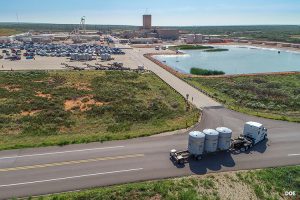 “A couple of years ago, I was asked to mediate a dispute between the U.S. Department of Energy (DOE) and the New Mexico Environment Department (NMED) concerning the renewal of a required state permit for DOE’s Waste Isolation Pilot Plant (WIPP), the nation’s only deep underground nuclear waste storage facility, located outside of Carlsbad, New Mexico. I thought I could help the two government entities but quickly came to realize that under the mediation procedures followed by New Mexico, the mediation would also involve citizen groups whose ultimate concurrence was essential to any complete resolution. This was entirely new to me.
“A couple of years ago, I was asked to mediate a dispute between the U.S. Department of Energy (DOE) and the New Mexico Environment Department (NMED) concerning the renewal of a required state permit for DOE’s Waste Isolation Pilot Plant (WIPP), the nation’s only deep underground nuclear waste storage facility, located outside of Carlsbad, New Mexico. I thought I could help the two government entities but quickly came to realize that under the mediation procedures followed by New Mexico, the mediation would also involve citizen groups whose ultimate concurrence was essential to any complete resolution. This was entirely new to me.
“In this case, there were seven such citizen groups entitled to participate and representing a variety of points of view. There was one group representing some of the government and business leaders of the town of Carlsbad who favored permit renewal on terms ensuring the continued long-term operation of WIPP. There were six groups expressing a variety of concerns about nuclear waste coming to New Mexico. They sought a more restrictive permit.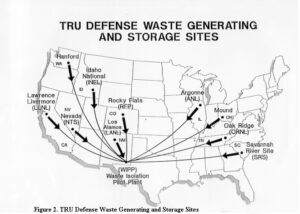
“To my astonishment, over the course of four full days, we worked through the multitude of issues and came to complete agreement. Something magical had happened. Thanks to the goodwill of the DOE and its contractor, the remarkable daily attendance and attentiveness of the NMED Secretary and the measured and well-informed way in which the various citizen groups made their points, we were able to find consensus and craft permit language that was acceptable to everyone.
“For me, as a former judge and mediator, the experience was thrilling. It was an experience of participatory democracy in action that made me proud of our fellow citizens and our government. Three aspects of the experience stand out. First, everyone in the room had taken responsibility for the way in which our nation’s only deep underground nuclear storage facility would be operated for the next 10 years. The citizen participants were not just making suggestions; they were assuming many of the attributes of decision makers. Second, all participants were advocating, compromising, and collaborating on behalf of what they saw as the public interest. These are the essential skills of democracy—the civic virtues so central to the Founders’ vision of what would make democracy work in America—and they require practice. Finally, over four days around a table, the citizens were able to take the measure of the DOE and NMED representatives. They came to realize, as I did, that these public servants, as well as the DOE contractor, were very well-informed, experienced, and intentioned. The government representatives had a similar experience of coming to appreciate the citizen questions and points of view. A government that relies on trust needs this kind of interaction to maintain that trust.
“It seems our democracy would be strengthened if we could extend the benefits of this kind of participatory structure to other areas of our legal and regulatory systems.”
“In Democracy in America, Alexis de Tocqueville made some of these points in reference to the jury trial in civil cases. He emphasized the importance of the civil jury trial as a free “public school” [https://contextus.org/Tocqueville,_Democracy_in_America_(1835),_Book_I,_Chapter_XVI_Causes_Mitigating_Tyranny_In_The_United_States_(Part_II).13?ven=Gutenberg&lang=en]  educating jurors in the democratic virtues and skills and teaching them to assume responsibility. In the same vein, every trial judge I know would attest to the importance of the jury experience for building confidence in the courts. After a trial, judges often hear words of gratitude from jurors who are deeply impressed by the legal process and are honored to have participated despite their initial dismay at being called to jury service. Sadly, the number of jury trials has diminished, particularly in federal court. Reversing that trend is a worthy goal, particularly for a branch of government that depends so heavily on public confidence.
educating jurors in the democratic virtues and skills and teaching them to assume responsibility. In the same vein, every trial judge I know would attest to the importance of the jury experience for building confidence in the courts. After a trial, judges often hear words of gratitude from jurors who are deeply impressed by the legal process and are honored to have participated despite their initial dismay at being called to jury service. Sadly, the number of jury trials has diminished, particularly in federal court. Reversing that trend is a worthy goal, particularly for a branch of government that depends so heavily on public confidence.
“As a final reflection: any persons involved as litigants will have an experience of the legal system. The experience can advance their sense of agency and participation, their ability to disagree civilly, and their trust in the courts. But how can these objectives be obtained when so many Americans cannot afford a lawyer? We can do so much better to provide understanding of and access to our justice system.”
The six New Mexico based non-governmental organizations were Citizens for Alternatives to Radioactive Dumping (CARD), Concerned Citizens for Nuclear Safety (CCNS), Conservation Voters New Mexico (CVNM), Nuclear Watch New Mexico, Southwest Alliance for a Safe Future (SAFE), and Southwest Research and Information Center (SRIC). The individual was Steve Zappe, a grandfather and former NMED WIPP Program Manager.
“A House of Dynamite” New Netflix Nuclear Catastrophe Film: Fiction, for Now
The reviews are rolling in for “A House of Dynamite,” which premiered in Europe earlier this month before coming to the U.S. on October 10th, with a full Netflix release scheduled for the 24th. Here’s the trailer, and see the schedule for Santa Fe theater showings here:
This Week! Santa Fe Theater Screenings for the Film “A House of Dynamite”
I attended one of these screenings last night, and I’ll let the professional critic reviews give the gist:
The Kathryn Bigelow thriller looks at what might happen if a ballistic missile were headed to the U.S. The director hopes the movie will start a conversation. New York Times: At Venice, ‘A House of Dynamite’ Is Scarier Than Most Horror Films
“The Netflix thriller captures from multiple perspectives the White House response to an unattributed missile launch headed for a major U.S. city in the harrowing 20 minutes until projected impact…”An unrelenting chokehold thriller so controlled, kinetic and unsettlingly immersive that you stagger out at the end of it wondering if the world will still be intact.” ‘A House of Dynamite’ Review: Idris Elba and Rebecca Ferguson in Kathryn Bigelow’s Precision-Tooled, Viscerally Unsettling Nail-Biter
“Told from the perspective of soldiers at a remote Alaskan missile base, staffers in the White House situation room, military officials at US Central Command (CENTCOM), and the president of the United States, the film weaves an overlapping timeline to show how the United States would respond to a missile attack…The film doesn’t want viewers to ask themselves how to thwart a nuclear attack on the United States. Rather, it wants the viewer to question the value of having nuclear weapons at all. ‘None of this makes sense,’ the President (Idris Elba) bemoans, ‘Making all these bombs and all these plans.'”
“A House of Dynamite is a terrifying examination of how terribly wrong things can go even with highly competent people in charge…But that’s also not necessarily the world we’re living in…The film shows why the worst can happen, even when competent, well-meaning people are trying to do the right thing.
But what if competence and decency are in short supply?” A House of Dynamite: Bigelow’s latest thriller shows why nuclear bombs are only part of the danger
This film left me reeling with tension and anxiety and exactly as the Times article titles it, is scarier than most horror films. Unlike ‘Oppenheimer,’ which largely glorified the invention of the atomic weapon, ‘A House of Dynamite’ makes it impossible to ignore the threat that nuclear weapons pose to our world. Working backwards from perspectives, and focused on how we can actually improve our odds of keeping this story a fictional one, here is what struck me most about this film:
-
-
Only one person decides what happens. But the real threat isn’t one reckless leader — it’s a reckless system. The final segment of the film features the “nuclear football” heavily, a briefcase containing launch procedures and options. In the United States, the president holds the sole and absolute authority to order the use of nuclear weapons. In the film, there are many voices in the President’s ear, but two primary perspectives quickly emerge after the defense fails and the ICBM remains inbound to its U.S. target: “One side advocates a retaliatory strike; the other, nothing. ‘It’s surrender or suicide,’ one adviser tells the President,” – thebulletin.org. The military aide carrying the nuclear football is tasked with providing the President the list of options if retaliation is chosen. An absolute must-read, Daniel Ellsberg’s book “The Doomsday Machine” breaks down many of the themes in the film with pure and terrifyingly honest account of Cold War-era nuclear strategy. In terms of launch authority, he describes how the inherent instability of the delegated command structure of the nuclear apparatus makes accidental or unwanted war an ever-present danger.
-
LANL tritium containers to head to Texas after last treatment
Four flanged tritium waste containers have been depressurized and transported to Los Alamos National Laboratory’s Weapons Engineering Tritium Facility, where they will be treated further before heading out-of-state for disposal.
By Alaina Mencinger amencinger@sfnewmexican.com | October 15, 2025 santafenewmexican.com
The containers’ final destination is Waste Control Specialists, a West Texas facility that handles the storage and disposal of radioactive waste.
The more than 1,300-acre facility in Andrews County is located on an approximately 14,000 acre property, which is sited on a thick clay formation which the company describes as “nearly impermeable.”
New documents have been added to the Los Alamos Legacy Cleanup Contract Electronic Public Reading Room.
All legacy cleanup documents required to be posted after April 30, 2018, are available on the site linked above.
For legacy cleanup documents that were posted prior to April 30, 2018, please visit the LANL electronic public reading room.
- Review, Notice of Completion of Off-Site Waste Shipments for Final Disposal, Activities 3.1.5, 3.1.8, and 3.3.4, Compliance Plan, Site Treatment Plan, Federal Facility Compliance Order Los Alamos National Laboratory [July 31, Aug. 21, 2025]
https://ext.em-la.doe.gov/GovFTPFiles/api/GetFiles/GetFile?fileName=EMID-703933_NMED_Review_STP_Shpmt_Jul_31_Aug_21_101525.pdf
Strong Political and Public Opposition Means Consolidated Interim Storage Facility (CISF) in NM “Impossible in the Near Future”
NEW UPDATE OCTOBER 10, 2025:
Holtec abandons plan to build New Mexico storage facility for spent nuclear fuel
This is excellent news. The Governor and state legislature (specifically Senator Jeff Steinborn and Representative McQueen) are to be commended for not allowing New Mexico to become the nation’s dumping ground for highly radioactive commercial spent fuel rods, especially when the Land of Enchantment has never had its own nuclear energy plant. Hard work from many New Mexicans made this happen.
So-called “interim” storage would never be interim when the federal government has failed for more than four decades to find a permanent repository for these lethal wastes. This also shows how hollow all the hype is about the claimed renaissance of nuclear power, when on the front end the industry can’t survive without taxpayer handouts, and on the back end can’t solve its radioactive waste problem.
Holtec’s quote that “New Mexico’s acquiescence is necessary” for interim storage to go forward is interesting, implying that we have to surrender as the nuclear colony that we are. Well, guess what, we didn’t surrender, and I predict you’ll see more of this. Moreover, whether you’re pro-nuclear or anti-nuclear, Holtec is an ethically questionable company, which is why the attorneys general of New Jersey and Massachusetts have sued it.
Adiós and good riddance, Holtec!
New York Times: Tax Break Scandal Leads to $5 Million Fine for N.J. Energy Company
SEE MORE:
Nuclear Weapons Issues & The Accelerating Arms Race: September 2025
Nuclear Weapons Update:
Putin has offered Trump a one-year extension of the numerical cap on strategic nuclear weapons in the new Strategic Arms Reduction Treaty which is 1,550 warheads (however, B52s are counted as one warhead while they can carry a dozen). New START expires in February 2026, which will be the first time the world will be without any nuclear arms control treaties since the mid-1970s. Trump has said it sounded like a good idea.
Note: New START ratification in 2010 provided the opportunity for Republicans in the Senate to attach the condition of $88 billion for nuclear weapons “modernization” that has since metastasized to ~$2 trillion. Nuclear disarmament must be prioritized as the ultimate goal over simply continued arms control.
A mere extension of the numerical cap would not involve Congressional ratification. The extension of New START’s numerical cap is in part to allow for a year in which to begin negotiations for a treaty replacement.
Plutonium Pit Production:
A draft plutonium pit production programmatic environmental impact statement is expected to be released next year in early 2026.
Accelerating Arms Race:
Is North Korea set to become world’s ‘fourth ICBM power’ after missile breakthrough? | Park Chan-kyong | South China Morning Post | September 11, 2025
A new era in North Korea’s missile programme may be dawning, as analysts warn of an imminent test launch of an intercontinental ballistic missile capable of carrying multiple warheads to the US mainland. Fresh from his appearance at China’s Victory Day parade in Beijing last week, North Korean leader Kim Jong-un personally oversaw the trial of a lighter, more robust solid-fuel ICBM engine, state media reported on Tuesday, touting the achievement as a “strategic” breakthrough.
Saudi Arabia signs a mutual defense pact with nuclear-armed Pakistan after Israel’s attack on Qatar | MUNIR AHMED & JON GAMBRELL | AP NEWS | September 18, 2025
DUBAI, United Arab Emirates (AP) — Pakistan’s defense minister says his nation’s nuclear program “will be made available” to Saudi Arabia if needed under the countries’ new defense pact, marking the first specific acknowledgment that Islamabad had put the kingdom under its nuclear umbrella.
Defense Minister Khawaja Mohammad Asif’s comments underline the importance of the pact struck this week between Pakistan and Saudi Arabia, which have had military ties for decades.
The move is seen by analysts as a signal to Israel, long believed to be the Middle East’s only nuclear-armed nation. It comes after Israel’s attack targeting Hamas leaders in Qatar last week killed six people and sparked new concerns among Gulf Arab nations about their safety as the Israel-Hamas war devastated the Gaza Strip and set the region on edge.
Russia suspected of helping North Korea build nuclear submarines, Seoul investigating | Park Chan-kyong | South China Morning Post | September 18, 2025
South Korea is investigating reports that Russia has supplied North Korea with nuclear submarine reactor modules, a move analysts see as highly plausible and one that could mark a breakthrough in Pyongyang’s decades-long push for a nuclear-powered navy… At the 8th Party Congress in January 2021, North Korea declared five core defence goals, including the development of nuclear-powered submarines and submarine-launched strategic nuclear weapons.
China Hardens Military Stance Against U.S. With Nuclear Weapons and Tough Talk | Brian Spegele | The Wall Street Journal| September 18, 2025
China played down its rapidly rising military might for years. In the past few weeks, Beijing has broadcast a steady drumbeat of firepower displays and muscular rhetoric, carrying an unmistakable warning for the U.S… Part of China’s confidence stems from the rapid growth of its firepower. The Pentagon estimates that China’s stockpile of nuclear warheads has more than doubled since 2020, alongside a growing array of options to launch those weapons, from mobile ground-launch systems to increasingly stealthy submarines.
Holtec Pulls Out of New Mexico Spent Nuclear Fuel Interim Storage Project
Holtec International has confirmed it is canceling plans to build a consolidated interim storage facility for spent nuclear fuel in southeastern New Mexico.
By Radwaste Solutions | October 9, 2025 ans.org
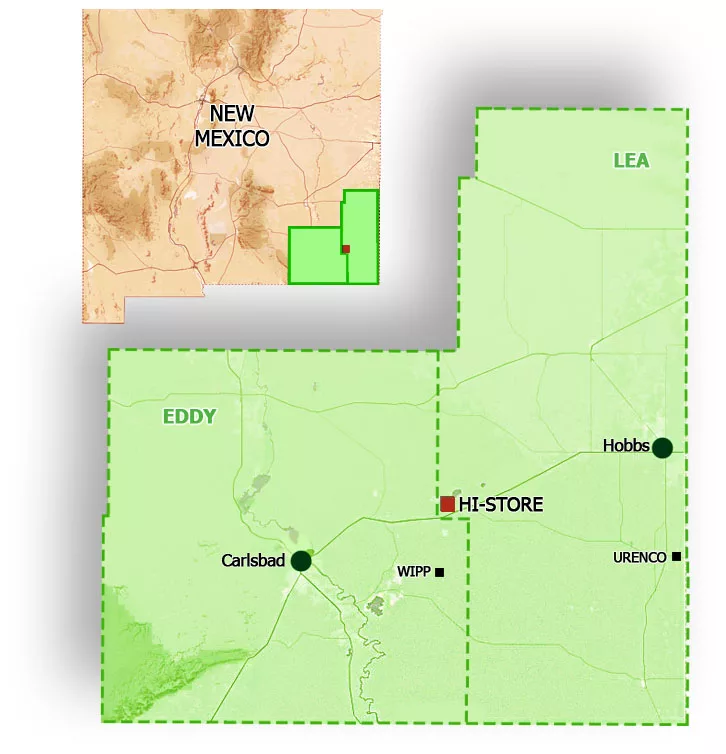
Named the HI-STORE CISF, the facility would have stored up to 10,000 canisters of commercial SNF on land owned by the Eddy-Lea Energy Alliance (ELEA) near the towns of Carlsbad and Hobbs.
“After discussions with our longtime partner in the HI-STORE project, the Eddy-Lea Energy Alliance, and due to the untenable path forward for used fuel storage in New Mexico, we mutually agreed upon canceling the agreement. This allows for ELEA to work to redevelop the property in a manner that fits their needs and allows Holtec to work with other states who are amenable to used fuel storage based on the recent DOE work on public education and outreach,” Holtec said in a statement (emphasis added).
Following the U.S. Supreme Court’s June ruling in NRC v. Texas, which found that petitioners did not have standing to challenge the Nuclear Regulatory Commission’s licensing of Interim Storage Partners’ CISF in Texas, Holtec said it expected to have its HI-STORE CISF license reinstated, allowing the company to move forward with the project. Holtec and ISP’s NRC licenses were vacated by the 5th Circuit Court of Appeals in a 2023 ruling.
Despite the court’s decision, New Mexico Gov. Michelle Lujan Grisham said she remained committed to preventing the HI-STORE CISF from being built. In 2023, New Mexico passed a bill barring the storage and disposal of high-level radioactive waste in New Mexico without the state’s explicit consent.
The AI Doomsday Machine Is Closer to Reality Than You Think
“Most troubling to experts on AI and nuclear weapons is that it’s getting harder and harder to keep decisions about targeting and escalation for nuclear weapons separate from decisions about conventional weapons.”
“There is no standing guidance, as far as we can tell, inside the Pentagon on whether and how AI should or should not be integrated into nuclear command and control and communications,” says Jon Wolfsthal, director of global risk at the Federation of American Scientists.
By Michael Hirsh | September 2, 2025 politico.com
Jacquelyn Schneider saw a disturbing pattern, and she didn’t know what to make of it.
Last year Schneider, director of the Hoover Wargaming and Crisis Simulation Initiative at Stanford University, began experimenting with war games that gave the latest generation of artificial intelligence the role of strategic decision-makers. In the games, five off-the-shelf large language models or LLMs — OpenAI’s GPT-3.5, GPT-4, and GPT-4-Base; Anthropic’s Claude 2; and Meta’s Llama-2 Chat — were confronted with fictional crisis situations that resembled Russia’s invasion of Ukraine or China’s threat to Taiwan.
Director Kathryn Bigelow is Sounding the Nuclear Alarm – Washington Post New Review
“A House of Dynamite” asks: How would the White House respond in the face of a nuclear attack?
By Max Boot | October 2, 2025 washingtonpost.com
VIEW MORE: “A House Of Dynamite” Q&A w/ Director Kathryn Bigelow, Tracy Letts, Jared Harris, And More At New York Film Fest —
80th Commemorations of Ban the Bomb – Trinity, Hiroshima & Nagasaki Remembrances in New Mexico
Exchange Monitor: DNFSB makes agency fixes, but needs members, GAO finds
The Defense Nuclear Facilities Safety Board (DNFSB) has tackled all but a few third-party recommendations to improve its culture over the past decade but suffers from a depleted board, according to a new report.
By ExchangeMonitor | September 5, 2025 santafenewmexican.com
Progress is tough with the five-person board probably…
China Hardens Military Stance Against U.S. With Nuclear Weapons and Tough Talk
Xi positions Beijing as powerful center of new global order as security forum convenes in capital
By Brian Spegele | September 18, 2025 wsj.com
BEIJING—China played down its rapidly rising military might for years. In the past few weeks, Beijing has broadcast a steady drumbeat of firepower displays and muscular rhetoric, carrying an unmistakable warning for the U.S….
Saudi Arabia signs a mutual defense pact with nuclear-armed Pakistan after Israel’s attack on Qatar
While not specifically discussing the bomb, the agreement states “any aggression against either country shall be considered an aggression against both,” according to statements issued by both Pakistan’s Foreign Affairs Ministry and the state-run Saudi Press Agency.
By MUNIR AHMED and JON GAMBRELL | September 18, 2025 apnews.com
ISLAMABAD (AP) — Saudi Arabia and nuclear-armed Pakistan have signed a mutual defense pact that defines any attack on either nation as an attack on both — a key accord in the wake of Israel’s strike on Qatar last week.
The kingdom has long had close economic, religious and security ties to Pakistan, including reportedly providing funding for Islamabad’s nuclear weapons program as it developed. Analysts — and Pakistani diplomats in at least one case — have suggested over the years that Saudi Arabia could be included under Islamabad’s nuclear umbrella, particularly as tensions have risen over Iran’s atomic program.
COMMUNITIES FOR CLEAN WATER: LANL Radioactive Tritium Venting Fails to Provide Transparency, Assurance, and Respect for Local Communities
FOR IMMEDIATE RELEASE: September 18, 2025
Santa Fe, NM — As NNSA and LANL continue operations to depressurize Flanged Tritium Waste Containers, Communities for Clean Water (CCW) calls out federal agencies for issuing vague assurances instead of transparent, verifiable data — and for dismissing community concerns with contradictory and incomplete statements that disregard what independent experts have found, the Department of Energy’s (DOE) own legal obligations, and the New Mexico Environment Department’s (NMED) acknowledgment that LANL has a long record of compliance failures.
“How can our communities be expected to trust LANL when they won’t give us access to the raw, real-time monitoring data – independently verified by the EPA,” asks Joni Arends with Concerned Citizens for Nuclear Safety. “Without this transparency, LANL is continuing a legacy of empty assurances, not accountability.”
Key Concerns:
-
Lack of real-time transparency – Since Friday (Sept. 12), the public has been forced to rely on NMED’s Facebook page for piecemeal updates. While LANL’s website provides very brief daily summaries, no near-real-time monitoring dashboard from DOE, NNSA, or LANL has been made available.
-
Vague assurances, not real information – NNSA’s updates claim “no tritium was released” while simultaneously telling the public to expect “very low levels of tritium” for subsequent venting. Without numbers, monitoring data, or detection thresholds, these phrases do not provide reassurance.
-
Weather risks – LANL has not disclosed thresholds for wind, rain, or humidity that would postpone venting. Communities watch weather shifts in real time but are left in the dark about how safety decisions are being made.
-
Dismissal of public health concerns – When asked for plain-language guidance that NMED stated LANL would provide, LANL responded only with “no offsite impact anticipated.” This is not meaningful and reassuring guidance, it’s a blanket dismissal that disregards independent expert findings and fails to meet DOE’s obligations to protect vulnerable populations.
-
Ignoring daily lifeways – Avoiding Pueblo Feast Days is not enough. This is harvest season, when outdoor cultural events, youth programs, and farming are in full swing. LANL’s scheduling continues to disregard these realities.
Unanswered Questions
Independent experts and community advocates have raised critical unanswered questions:
-
Unclear “depressurization” – LANL said “no internal pressure was found” in a container, but also claimed it was “depressurized.” If no pressure existed, what was released?
-
Unanswered helium questions – NMED stated helium was released, but LANL has not explained its origin. Was it introduced at sealing of the outer container, or a decay product of tritium?
-
Monitoring limits undisclosed – LANL has not disclosed the detection limits of its monitoring equipment. Readings “indistinguishable from zero” could still mask releases.
DOE NNSA Gives Misleading Statements on Native America Calling
On a recent Native America Calling program, DOE NNSA’s Los Alamos Field Office Deputy Director Pat Moss compared LANL venting to global natural tritium stocks. Independent expert Dr. Arjun Makhijani pointed out this comparison as misleading: “The problem is not global background, but local contamination. If venting occurs in rain and calm winds, local rainfall could exceed U.S. drinking water standards by hundreds to thousands of times.”
In their most recent public meeting, LANL admitted that infants could receive three times the radiation dose as adults. During the interview, Dr. Makhijani pressed this point – if adults are modeled at 6 mrem, that means infants could be at 18 mrem, nearly double the EPA’s 10 mrem compliance limit. Instead of addressing this directly, Mr. Moss provided a stock line, “We will be compliant with the regulatorily imposed release threshold and will be doing the calculations per the regulation.”
That is exactly the problem – hiding behind regulatory caps while ignoring clear evidence that infants, our most vulnerable, face exposures above legal limits.
DOE NNSA also pointed to the Defense Nuclear Facilities Safety Board (DNFSB) – an independent federal oversight body created by Congress – as if it had declared the tritium venting operation as “fully protective of the public”. That is misleading. First, the DNFSB has been operating without a quorum for months, limiting its ability to issue independent recommendations. Second, what the Board staff said in its July 2025 presentation was that the overall nuclear safety risk to the public is low if DOE’s proposed controls are followed. The DNFSB has also flagged ongoing safety concerns at LANL including deficiencies in Area G’s safety analysis and risk to workers.
First of four containers of tritium waste at LANL has been vented
The first of four flanged tritium waste containers awaiting removal from Los Alamos National Laboratory has been vented, the New Mexico Environment Department announced Tuesday afternoon.
By Alaina Mencinger amencinger@sfnewmexican.com | September 16, 2025 santafenewmexican.com
The container can now be moved for treatment at LANL and then, eventually, to an off-site disposal area.
No internal pressure was found in the first container, according to the National Nuclear Security Administration, suggesting the inner containers in the flanged tritium waste container hadn’t leaked. Air monitoring did not show an increase of tritium beyond background levels, the federal agency wrote.
No tritium emissions were released, the Environment Department wrote in its Tuesday post on X, formerly Twitter. Both the state agency and the U.S. Environmental Protection Agency are monitoring the process.
The depressurization of the containers is set to continue at 7 a.m. Wednesday, although the NNSA noted the schedule is subject to change due to weather. The four containers will be vented one at a time over an estimated two-week period.
*The featured image differs from the article photo due to usage rights.
New Mexicans Can Save the DNFSB; Contact Our Senators Today
From our friends at Concerned Citizens for Nuclear Safety:
The independent Defense Nuclear Facilities Safety Board has been dwindling from a five-member board to one member and may disappear if we, the People, do not raise our voices to support its essential nuclear safety work. The Safety Board needs at least two new members. And that needs to get done by Saturday, October 18th. https://www.dnfsb.gov/about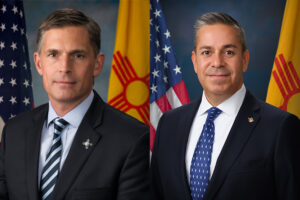
New Mexico U.S. Senators Heinrich and Lujan have key roles to play to ensure the Safety Board’s work continues unimpeded. https://www.heinrich.senate.gov/ and https://www.lujan.senate.gov/ Our voices of support are essential to ensure communities continue to receive the essential services of the Safety Board and its staff.
Right now members of the Safety Board’s staff are monitoring the venting of radioactive tritium from Area G at Los Alamos National Laboratory (LANL). Their expertise in the field of nuclear safety and their demonstrated competence and knowledge relevant to their independent investigative and oversight functions are an essential part of the process. They will be part of the follow-up once the venting of the four flanged tritium waste containers is completed. https://tewawomenunited.org/?s=tritium, https://www.ccwnewmexico.org/tritium, https://nuclearactive.org/
Not only does the Safety Board have staff at LANL, but also at Sandia National Laboratories in Albuquerque and at the Waste Isolation Pilot Plant, the burial site for plutonium contaminated nuclear weapons waste, near Carlsbad. https://ananuclear.org/facilities/
Russia suspected of helping North Korea build nuclear submarines, Seoul investigating
Analysts said such a technology transfer was plausible given Pyongyang’s support for Russia’s ongoing war in Ukraine
By Park Chan-kyong | September 18, 2025 scmp.com
South Korea is investigating reports that Russia has supplied North Korea with nuclear submarine reactor modules, a move analysts see as highly plausible and one that could mark a breakthrough in Pyongyang’s decades-long push for a nuclear powered navy…
Holy See tells nations at UN to end threat of nuclear weapons, even as deterrence
Amid a global arms race, ending the threat of nuclear war — and even the testing of nuclear weapons — is imperative, said the Holy See’s diplomat to the United Nations.
By Gina Christian, OSV News | September 8, 2025 catholicreview.org
Archbishop Gabriele G. Caccia, the Holy See’s U.N. permanent observer, shared his thoughts in a statement he delivered Sept. 4 at U.N. headquarters in New York, during the General Assembly High-level Plenary Meeting to Commemorate and Promote the International Day Against Nuclear Tests, observed that same day.
“The pursuit of a world free of nuclear weapons is not only a matter of strategic and vital necessity, but also a profound moral responsibility,” Archbishop Caccia in his remarks.
He pointed to the introduction of nuclear weapons — first detonated by the U.S. in 1945 over the Japanese cities of Hiroshima and Nagasaki, killing an estimated 110,000 to 210,000 people, during World War II — as unveiling to the world “an unprecedented destructive force.”
Historic peace vigil partially dismantled after Trump orders: ‘Take it down’
Law enforcement officials on Sunday removed parts of the White House Peace Vigil, which has sat just outside the White House for decades.
By Marissa J. Lang, The Washington Post | September 8, 2025 washingtonpost.com
But over the past week, it faced a new threat as Trump turned his attention to the vigil and federal officers picked apart the structure that shields protesters and their signs from the elements. The vigil is maintained by a rotating cast of volunteers who keep the protest going 24 hours a day, seven days a week.
On Friday, Brian Glenn, a correspondent for the conservative network Real America’s Voice, told the president during a gathering with reporters that there was “a blue tent” in front of the White House that was “an eyesore.” Trump initially said he was unaware of it, but he then quickly ordered its removal.
Photo by Sig. Chiocciola, Creative Commons: The White House Peace Vigil on March 30, 2025 staffed by volunteers, Philipos Melaku-Bello (left) and Joe Brown (right).
For 80 years, nuclear weapons have been the unused threat
Amid a global arms race, ending the threat of nuclear war — and even the testing of nuclear weapons — is imperative, said the Holy See’s diplomat to the United Nations.
By Matt Kelly, mkelly@virginia.edu, September 3, 2025 news.virginia.edu
In the 80 years since World War II, which ended with the use of two atomic bombs, the world has maintained a tenuous relationship with nuclear weapons.
Philip Potter, professor of public policy at the University of Virginia’s Frank Batten School of Leadership and Public Policy and director of the National Security Data and Policy Institute, said he worries about the current delicate nuclear balance.
“Eighty years of non-use is the product of both good diplomacy and a recognition of the potential consequences,” Potter said. “The fearsome power of nuclear weapons causes countries pause before they use them, but a great deal of work has also gone into nonproliferation and the management of crises to keep them away from the nuclear brink. In some ways the dynamics of the Cold War made managing the potential for nuclear confrontation easier.”
It’s a very different strategic scenario now, where there are nine nuclear powers and less capacity to manage them.
A House of Dynamite review – Kathryn Bigelow’s nuclear endgame thriller is a terrifying, white-knuckle comeback
★★★★★: Amid a global arms race, ending the threat of nuclear war — and even the testing of nuclear weapons — is imperative, said the Holy See’s diplomat to the United Nations.
By Peter Bradshaw, The Guardian | September 2, 2025 theguardian.com
Kathryn Bigelow has reopened the subject that we all tacitly agree not to discuss or imagine, in the movies or anywhere else: the subject of an actual nuclear strike. It’s the subject which tests narrative forms and thinkability levels.
Maybe this is why we prefer to see it as something for absurdism and satire – a way of not staring into the sun – to remember Kubrick’s (brilliant) black comedy Dr Strangelove, with no fighting in the war room etc, rather than Lumet’s deadly serious Fail Safe.
Nuclear News Archive – 2022
‘Nuclear accident’ warnings amid Russia missile strikes
By Paraic O’Brien | October 6, 2022 channel4news.com
Russia has faced weeks of military defeats in Ukraine, but today brought a reminder its military is still able to cause substantial destruction.
Overnight, and again this morning, the city of Zaporizhzhia suffered a series of missile attacks, including a direct strike on a residential apartment building.
The strikes raised concerns for the nearby nuclear power plant, leading to a warning from the International Atomic Energy Agency that an accident there is “a very clear possibility”.
NY TIMES: I’ve Studied 13 Days of the Cuban Missile Crisis. This Is What I See When I Look at Putin.
By Michael Dobbs, The New York Times | October 5, 2022 nytimes.com
Two nuclear-armed states on a collision course with no obvious exit ramp. An erratic Russian leader using apocalyptic language — “if you want us to all meet in hell, it’s up to you.” Showdowns at the United Nations, with each side accusing the other of essentially gambling with Armageddon. For six …
Los Alamos National Laboratory’s pit production a year behind schedule
“Jay Coghlan, executive director of Nuclear Watch New Mexico, said the lab has a history of delays and cost overruns that predates the pandemic.
“I suspect LANL and [the federal government] are using COVID as a convenient excuse for what’s going to happen anyway,” Coghlan said. “I’m certainly not saying there was no delay for COVID, but I doubt this much.”
Coghlan said the revelation is significant because it’s the first official confirmation the Los Alamos lab is running behind schedule with its planned pit production.”
BY SCOTT WYLAND, THE SANTA FE NEW MEXICAN | October 5, 2022 santafenewmexican.com
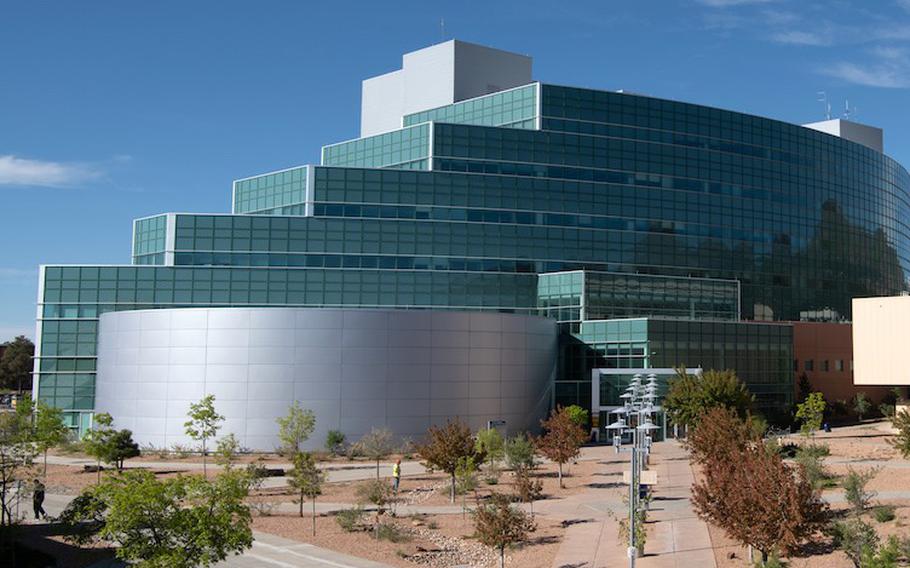
(Tribune News Service) — Los Alamos National Laboratory’s effort to produce 30 nuclear bomb cores a year by 2026 was stalled for 13 months because of the coronavirus pandemic, calling into question whether it can make the much-touted target.
An anti-nuclear activist obtained a redacted management plan for the lab’s plutonium operations through a Freedom of Information Act Request, which describes how the production deadline is more likely to be missed because of preparatory work being delayed during a hard-hitting stretch of the pandemic.
STATEMENT: Archbishop Wester on Feast Day of St. Francis, Pray for Peace in Ukraine, Abolition of Nuclear Weapons
Today, October 4 is the feast day of St. Francis, the tireless promoter of peace and patron saint of the Archdiocese of Santa Fe.
Pope Francis chose his name in honor of St. Francis of Assisi, and three days ago, he declared:
“The course of the war in Ukraine has become so serious, devastating, and threatening as to cause great concern… [W]hat about the fact that humanity is once again faced with the atomic threat? It is absurd… It increases the risk of nuclear escalation, giving rise to fears of uncontrollable and catastrophic consequences worldwide.”
This October is the 60th anniversary of the Cuban Missile Crisis, about which then-Defense Secretary Robert McNamara said humanity survived only by luck. Sixty years later, we are facing the most serious nuclear threats since then.
Pope Francis has called for the abolition of nuclear weapons, declaring they can no longer be justified even by the deterrence strategy of Mutually Assured Destruction.
Biden Thinks Non-Nuclear Threats Will Stop Putin. His Military Doesn’t
“We’re in uncharted territory,” says a senior intelligence officer. “Threatening to respond forcefully and creating catastrophic consequences for Russia [without] suggesting nuclear war: Is that strong enough to deter Putin? And is it really clear? I’m not so sure.”
BY WILLIAM M. ARKIN, NEWSWEEK | September 30, 2022 newsweek.com
The United States would “respond forcefully” to any Russian nuclear strike, President Biden said—but there’s a divide between his administration and some of his military advisers over the role of American nuclear weapons and the most effective way to deter Vladimir Putin, knowledgeable sources tell Newsweek.
“It’s the closest we’ve been to the use of nuclear weapons in over 50 years,” says one civilian working at the Omaha, Nebraska-based Strategic Command. “But I’m not so sure that we are communicating the right thing to deter Putin.”
The Age of Predatory Nuclear-Weapon States Has Arrived
Putin’s nuclear threat marks the start of a new era.
POLITICO | Opinion by Stephen Young, Union of Concerned Scientists | September 30, 2022 politico.com
Russia’s invasion of Ukraine makes at least one thing clear: It’s time for us to update how we think about nuclear weapons. For the first time in the nuclear era, one country used loudly issued nuclear threats — repeated just last week — to deter other countries from intervening in a large-scale conventional war of aggression. We have entered the age of “predatory nuclear-weapon states.”
For political analysts and military officials, this is not an unexpected phenomenon. On the contrary, the concept falls under the so-called stability-instability paradox. Because the threat of nuclear war is so terrifying and the risk of annihilation so real, lower-level conflict actually becomes more feasible. One nuclear-armed country can undertake major conventional military action, expecting that its nuclear capability will prevent outside intervention. That is what’s happening in Ukraine.
BREAKING: Putin illegally annexes 4 occupied regions, escalating war as Ukraine applies to join NATO
“Kyiv has vowed to keep fighting to retake its occupied land, and on Friday appeared on the verge of handing Russia’s military another significant setback.”
NBC NEWS | September 30, 2022 nbcnews.com
The Russian leader repeated his threats of nuclear war to defend his fragile hold over the annexed territory, a dramatic escalation of the seven-month conflict that has seen Moscow respond to heavy losses by calling up hundreds of thousands of reservists and intensifying its confrontation with the West.
The speech was met with an immediate response by Kyiv and its allies.
As well as announcing the annexation, Putin has partially mobilized his military — prompting domestic blowback and an exodus of Russians fleeing the draft — and ramped up his nuclear threats against Ukraine and the West. The moves are seen as a wider escalation after a series of punishing battlefield defeats at the hands of a lightning counteroffensive by Kyiv.
UN chief calls for end to ‘era of nuclear blackmail’
Guterres renews call for the abolition of nuclear weapons as concerns grow over Russia’s threat to use them in Ukraine.
ALJAZEERA | September 26, 2022 aljazeera.com
United Nations Secretary-General Antonio Guterres has renewed his call for the global abolition of nuclear weapons as concerns grow over Russia’s threat to use them in the Ukraine war.
“Decades after the fall of the Berlin Wall, we can hear once again the rattling of nuclear sabres,” Guterres told a special UN General Assembly session on nuclear disarmament on Monday.
Nuke waste managers work to improve safety after incidents at repository near Carlsbad
Crews at Idaho National Laboratory and the Waste Isolation Pilot Plant nuclear waste repository near Carlsbad met last week to improve safety standards shared between the two facilities after a string of problematic waste shipments from the lab triggered a state investigation.
Adrian Hedden, Carlsbad Current-Argus | September 22, 2022 yahoo.com
So far this year, WIPP personnel were alerted to issues with three shipments of transuranic (TRU) nuclear waste from the Idaho lab, leading to suspensions of waste shipments from the biggest shipper of waste to WIPP.
The first incident was reported on April 9, per a letter from the New Mexico Environment Department which regulates the U.S. Department of Energy’s permit to operate WIPP, and involved a liquid substance found on a waste drum that initially tested positive for radioactivity.
This led to an evacuation of the waste handling building, and a temporary halt on shipments of that kind from Idaho National Laboratory while the waste was sent back to Idaho.
Global food insecurity and famine from reduced crop, marine fishery and livestock production due to climate disruption from nuclear war soot injection
“Atmospheric soot loadings from nuclear weapon detonation would cause disruptions to the Earth’s climate, limiting terrestrial and aquatic food production. Here, we use climate, crop and fishery models to estimate the impacts arising from six scenarios of stratospheric soot injection, predicting the total food calories available in each nation post-war after stored food is consumed. In quantifying impacts away from target areas, we demonstrate that soot injections larger than 5 Tg would lead to mass food shortages, and livestock and aquatic food production would be unable to compensate for reduced crop output, in almost all countries. Adaptation measures such as food waste reduction would have limited impact on increasing available calories.
We estimate more than 2 billion people could die from nuclear war between India and Pakistan, and more than 5 billion could die from a war between the United States and Russia—underlining the importance of global cooperation in preventing nuclear war.”
NATURE | August 2022 nature.com

FULL ARTICLE – NATURE
Watchdog sues nuclear agency over LANL evaluations
“Coghlan said an example of why the full assessment is necessary is a note on last year’s report for the Los Alamos lab saying it had struggled with some production activities and experienced several challenges carrying out the plutonium mission, and “mission execution was impacted by lapses in safety performance.”
By Scott Wyland swyland@sfnewmexican.com The Santa Fe New Mexican | September 17, 2022 santafenewmexican.com
A New Mexico watchdog group is suing the federal agency that oversees the nation’s nuclear weapons programs for issuing only summaries of its yearly report cards on national laboratories and withholding what the group contends is vital information on deficiencies.
The lawsuit seeks to compel the National Nuclear Security Administration to post in its public reading room the complete report cards for the eight national laboratories involved in nuclear weapons — ones it has withheld in the past and all future assessments.
Allowing the public to see, in particular, the full report on Los Alamos National Laboratory’s shortcomings is increasingly important as the lab gears up to make 30 plutonium bomb cores a year with an escalating federal budget, Jay Coghlan, executive director of Nuclear Watch New Mexico, said in a statement.
The National Nuclear Security Administration’s yearly report cards assess the performances of contracted lab operators and award bonuses to the organizations based on their grades in a process that is not classified, Coghlan argued.
Continue reading
Exchange Monitor Round-Up: Anti-nukers sue for full performance evals
By Exchange Monitor | September 15, 2022 exchangemonitor.com
In a new lawsuit, the anti-nuclear group Nuclear Watch New Mexico, Santa Fe, demanded that the National Nuclear Security Administration (NNSA) turn over “full and complete Performance Evaluation Reports” for the contractors managing the agency’s nuclear-weapon…
‘Scoping’ The New LANL Site-Wide Environmental Impact Statement
![]() BY JAY COGHLAN
BY JAY COGHLAN
Executive Director, Nuclear Watch New Mexico
‘Scoping’ The New LANL Site-Wide Environmental Impact Statement
“Scoping” means determining the issues that should be included in public analyses required by the National Environmental Policy Act (NEPA) of proposed major actions by the federal government. According to the Department of Energy ‘s own NEPA implementation regulations, DOE must prepare a new or supplemental site-wide environmental impact statement (SWEIS) for its major sites when there are “significant new circumstances or information relevant to environmental concerns.” The last site-wide EIS for the Los Alamos National Laboratory (LANL) was completed in 2008 and is badly outdated. Moreover, since 2018 the National Nuclear Security Administration (NNSA), DOE’s semi-autonomous nuclear weapons agency, has been aggressively expanding the production of plutonium “pit” bomb cores for nuclear weapons at the Lab.
Lawmakers demand reparations for New Mexicans imperiled by nuclear bomb testing
“It’s very emotional to reflect on all we’ve lost as a result of being exposed to radiation,” said consortium founder Tina Cordova, herself a survivor of thyroid cancer who said members of her family also suffered from myriad forms of the disease.
By Adrian Hedden Carlsbad Current-Argus | September 10, 2022 currentargus.com
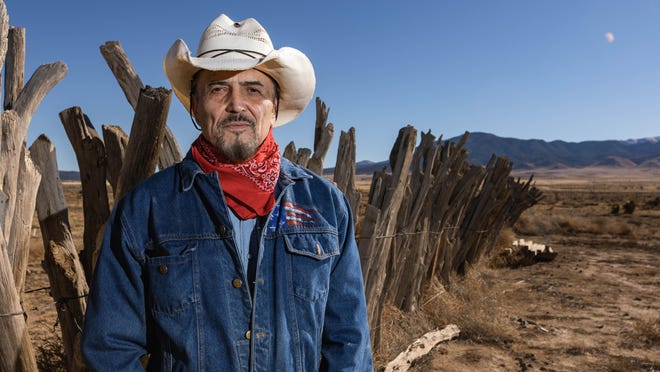
When the U.S.’ first nuclear bomb was detonated in south-central New Mexico, it was believed to set off a chain of cancers and health problems suffered by the surrounding communities for generations.
People who grew up near the Trinity Test Site, near the remote communities of Carrizozo or Tularosa, were denied federal relief dollars afforded to other “downwinders” impacted by nuclear testing around the country.
Both towns were within 50 miles of the blast site, and advocates say they were exposed to radiation from the bomb testing.
Agency to hold public comment on Los Alamos National Lab sitewide review
“Los Alamos lab’s plutonium modernization funding would climb to $1.56 billion from this year’s $1 billion, a more than 50 percent increase.
Jay Coghlan, executive director of Nuclear Watch New Mexico, expressed concerns about the agency indicating it saw no need to assess expanded pit production itself in the review.
“NNSA’s dubious argument is that it performed the legally required NEPA analysis for expanded plutonium pit production” in past assessments, Coghlan wrote.”
By Scott Wyland, The Santa Fe New Mexican | September 12, 2022 santafenewmexican.com
The federal agency that oversees nuclear weapons will hold two hearings this week to give the public a chance to comment about the first full sitewide environmental review of Los Alamos National Laboratory since 2008.
The National Nuclear Security Administration is conducting the sitewide review of the lab under the National Environmental Protection Act — breaking from its past resistance to doing fresh analysis of possible impacts as the lab gears up to annually produce 30 plutonium bomb pits by 2026.
Fighting rages near Russian-held nuclear plant in Ukraine
An official says the besieged Zaporizhzhia nuclear facility may be closed as residents near the plant are urged to evacuate for their own safety.
ALJAZEERA | September 9, 2022 aljazeera.com
 Heavy fighting erupted in areas near the Russian-occupied Zaporizhzhia nuclear power station in Ukraine after Kyiv warned it might have to shut down the plant to avoid a radiation disaster.
Heavy fighting erupted in areas near the Russian-occupied Zaporizhzhia nuclear power station in Ukraine after Kyiv warned it might have to shut down the plant to avoid a radiation disaster.
The General Staff of the Ukrainian Armed Forces said in its daily update on Thursday that some villages near the plant were bombed over the past 24 hours by “tanks, mortars, barrel and jet artillery”.
Overnight, Russian forces fired rockets and heavy artillery into the nearby town of Nikopol four times, the area’s regional governor, Valentyn Reznichenko, wrote on Telegram, damaging at least 11 houses and other buildings.
On Wednesday, an official said the nuclear plant may have to be shut down and called on residents in areas near the embattled facility to evacuate for their own safety.
SANTA FE NEW MEXICAN, MY VIEW JAY COGHLAN: LANL growth fueling new nuclear arms race
“Locally, while the lab grabs tens of billions of taxpayers’ dollars for new, counterproductive nuclear weapons production, it plans to “cap and cover” and leave buried some 200,000 cubic yards of toxic and radioactive wastes that will permanently threaten our precious water resources.”
My View Jay Coghlan – The Santa Fe New Mexican | September 10, 2022 santafenewmexican.com
The New Mexican‘s recent editorial on Los Alamos National Laboratory noted “LANL’s astounding growth” (“LANL’s growth creates pressure on safety,” Our View, Aug. 31). Cancer is defined as uncontrollable cellular growth invading other parts of the body. That is fitting here as the lab metastasizes into the city of Santa Fe (in English, “Holy Faith”). The potentially terminal disease is a second nuclear arms race. Ex-Defense Secretary Robert McNamara said we survived the first arms race only by luck.
Where is the leadership, where is the vision? While busy legislating short-term nuclear pork benefiting the already privileged, our congressional delegation leads us toward Armageddon. This second arms race is more dangerous than the first because of multiple nuclear adversaries, new cyber and hypersonic weapons, and artificial intelligence. All of this destabilizes the old Cold War architecture of mutually assured destruction (which never really went away). But “MAD” is truly insane to begin with, involving total, civilization-destroying war.
“Details of foreign country’s nuclear capabilities among documents FBI seized from Mar-a-Lago: report” “Nuclear secrets reportedly found at Mar-a-Lago are ‘gamechanger’, experts say – as it happened”
THE GUARDIAN: Report appears to confirm security officials’ worst fears about the nature of the material Trump refused to hand back
THE GUARDIAN, FOX NEWS | September 7, 2022 theguardian.com, foxnews.com
Federal agents seized the document during their search of Mar-a-Lago, the former president’s Palm Beach mansion in Florida, last month, the Washington Post reported. It appears to confirm officials’ worst fears about the nature of the intelligence he should have returned to the National Archives.
Shelling at Ukrainian nuclear plant highlights danger ahead of UN report – Reuters
U.N. seeks security zone near damaged Zaporozhzhia nuclear plant
By Pavel Polityuk and Francois Murphy, Reuters | September 6, 2022 reuters.com
Federal agents seized the document during their search of Mar-a-Lago, the former president’s Palm Beach mansion in Florida, last
KYIV/VIENNA, Sept 6 (Reuters) – Ukrainian forces shot down five Russian cruise missiles on Tuesday, most of them in the south, President Volodymyr Zelenskiy said, but he made no mention of a new military success in the east hinted at by officials earlier.
“This morning alone, five of six Russian X-101 missiles were downed,” Zelenskiy said in an evening address. “This is a costly loss for Russia, and it saves many Ukrainian lives. Four of these missiles were downed by the “South” district of the air command.”
Reuters was not able to independently verify Zelenskiy’s statement and there was no immediate response from Russia.
Though Ukrainian officials did not give specific details, several posts on social media from military bloggers and witnesses reported fighting around Balakliia, an eastern town of 27,000 people that lies between Kharkiv and Russian-held Izyum, a city with a major railway hub used by Moscow to supply its forces. One tweet by a Zelenskiy adviser spoke of “great news” coming from the president on the operation in Kharkiv region.
One Hundred and Fifteen NGOs and Individuals Ask for LANL SWEIS Comment Extension; LANL Virtual Scoping Meetings on September 13th and 14
August 31, 2022
This week 63 non-governmental organizations and 52 individuals requested that the U.S. Department of Energy (DOE) grant a two-month extension of time to provide informed public comments about the scope of the Site-Wide Environmental Impact Statement for Continued Operations of Los Alamos National Laboratory (LANL SWEIS). On August 19th, DOE announced in its Notice of Intent to Prepare a Site-Wide Environmental Impact Statement for the Los Alamos National Laboratory a 45-day comment period. Currently, comments are due on Monday, October 3rd, 2022. https://www.energy.gov/nnsa/nnsa-nepa-reading-room
 In their August 30th letter, the groups and individuals asked that the DOE Secretary Granholm and her staff extend the comment period to Monday, December 5, 2022. No response has yet been received. LANL SWEIS 2022 Scoping Extension Request 8-25-22
In their August 30th letter, the groups and individuals asked that the DOE Secretary Granholm and her staff extend the comment period to Monday, December 5, 2022. No response has yet been received. LANL SWEIS 2022 Scoping Extension Request 8-25-22
The NGOs and individuals justified their extension request by noting, among other items, that the last LANL SWEIS was finalized in 2008 – 14 years ago. Generally DOE conducts a SWEIS every 10 years. DOE proposes that this LANL SWEIS will cover “approximately the next 15 years” of operations, or to approximately 2038 and beyond.
Extension Requested For Scoping Comments Deadline For LANL Site-Wide Environmental Impact Statement
Dozens of environmental groups, non-government organizations and individuals have signed a request to the Department of Energy for a two-month extension of the Oct. 3 comment deadline for scoping comments on a Site-Wide Environmental Impact Statement for continued operations of Los Alamos National Laboratory.
BY MAIRE O’NEILL, Los Alamos Reporter | August 31, 2022 losalamosreporter.com
A letter sent Tuesday states that the current comment period is simply not enough time for the public to make meaningful comments on the scope of a proposal as large, complex and technical as the LANL SWEIS. It is addressed to Sec. of Energy Jennifer Granholm, Under Secretary for Nuclear Security Jill Hruby, DOE/NNSA Los Alamos Field Office Manager Ted Wyka and NNSA’s NEPA Compliance Officer at LANL Kristen Dors. The top two signatories are Joni Arends of Concerned Citizens for Nuclear Safety and Scott Kovac of Nuclear Watch New Mexico.
“The scope of the LANL SWEIS is of great national importance because it examines the environmental impacts associated with expanded plutonium pit production and cleanup at LANL,” the letter reads. “The 2008 LANL SWEIS is a formidable document, with 1942 pages, not counting the 144-page Summary and the 1207-page Comment Response Document. That’s a total of 3293 pages. This gives an idea of the amount of information analyses that are involved in preparing informed public scoping comments and why more time is needed.”
Former Soviet leader Mikhail Gorbachev, who helped end the Cold War, has died
Former Soviet leader Mikhail Gorbachev, who played a pivotal role in the end of the Cold War, has died at the age of 91 in Moscow.
August 30, 2022
Mr. Gorbachev's first five years in power were marked by significant, even extraordinary, accomplishments:
- He presided over an arms agreement with the United States that eliminated for the first time an entire class of nuclear weapons, and began the withdrawal of most Soviet tactical nuclear weapons from Eastern Europe.
- He withdrew Soviet forces from Afghanistan, a tacit admission that the invasion in 1979 and the nine-year occupation had been a failure.
- While he equivocated at first, he eventually exposed the nuclear power-plant disaster at Chernobyl to public scrutiny, a display of candor unheard-of in the Soviet Union.
- He sanctioned multiparty elections in Soviet cities, a democratic reform that in many places drove stunned Communist leaders out of office.
- He oversaw an attack on corruption in the upper reaches of the Communist Party, a purge that removed hundreds of bureaucrats from their posts.
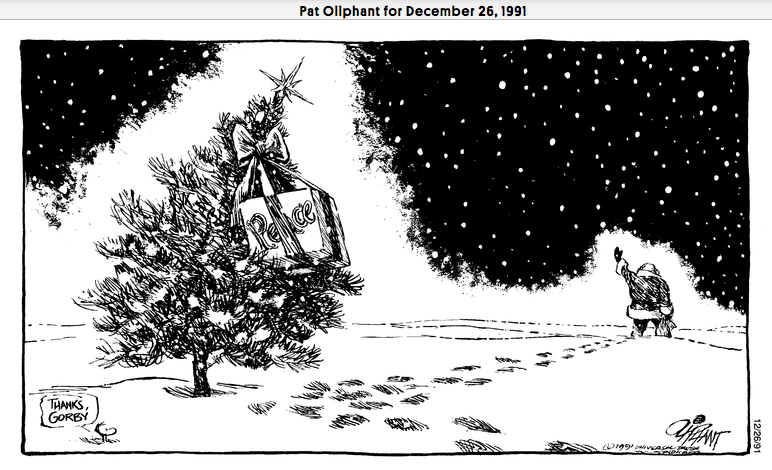
Mikhail Gorbachev, who has died aged 91, was the most important world figure of the last quarter of the 20th century. Almost singlehandedly he brought an end to 40 years of east-west confrontation in Europe and liberated the world from the danger of nuclear conflagration.
The man who oversaw the end of the Cold War and then the end of the Soviet Union has died.
‘We’re losing our people’: COVID ravaged Indigenous tribes in New Mexico. Did uranium mining set the stage?
Today, hundreds of mines lie abandoned across New Mexico’s Indigenous lands. So do scores of eroding radioactive landfills meant to bury uranium mine waste.
By Eli Cahan, Capital & Main | August 26, 2022 usatoday.com
As a young girl, Arlene Juanico would rush to gather the laundry before the explosions started.
When the alarms sounded, Juanico would hustle to grab the clean garments off the clothesline before she was enveloped by dust clouds. But Juanico’s little legs usually couldn’t get her back to shelter in time.
That’s when the yellow-flecked dust – emerging from detonations in the sacred mesa the Laguna tribe knows as Squirrel Mountain – would catch up to her. That’s when it would enter Juanico’s throat, burrowing deep into her lungs.
It’s the same dust she would confront when, as an adult, she worked for the Anaconda Copper Co.
And it’s the dust that would persist in her lungs, kidneys and bones. There, hidden in the dark recesses of her chest, the particles lay until one day decades later a CT scan would show Juanico and people like her why they hadn’t been able to take a full breath in decades. They’d get a similar diagnosis – idiopathic pulmonary fibrosis – one mangled lung at a time.
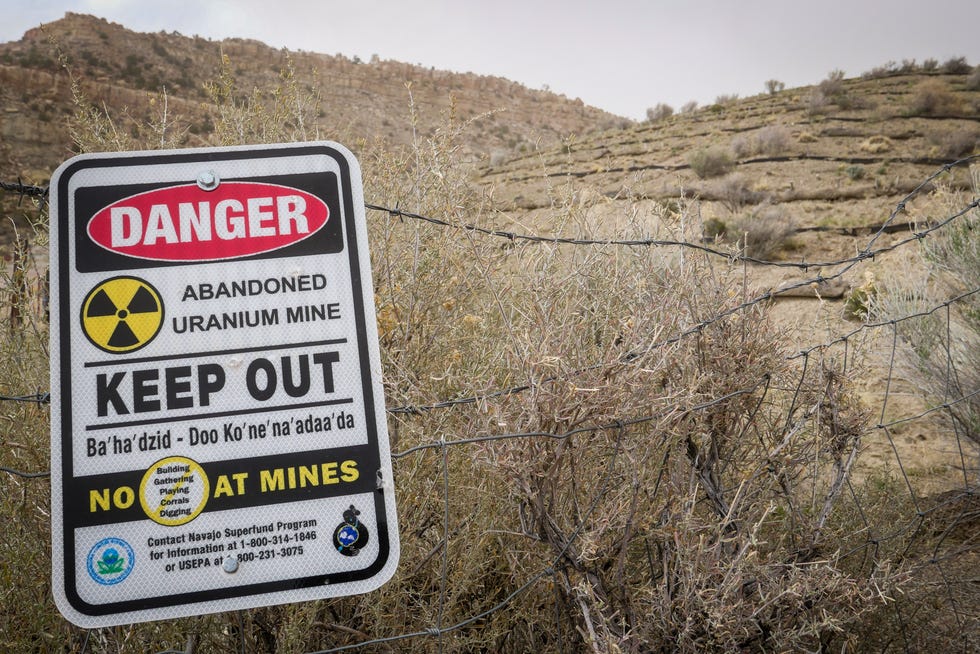
As such, the dangers of one of the largest uranium mines in American history didn’t abate when the dust clouds dissipated.
NPT Review Conference fails to address current security environment
“In a year when a nuclear-armed state invaded a non-nuclear armed state, a meeting of nearly all countries in the world failed to condemn Russia’s threats to use nuclear weapons in the context of its invasion, and failed to take any steps that would advance nuclear disarmament.”
After four weeks of meetings, the 10th Nuclear Non-Proliferation Treaty Review Conference has failed. Despite the final draft outcome document being significantly weakened throughout the negotiations, Russia refused to accept the final version and the conference ended without an agreement.
ICAN (The International Campaign to Abolish Nuclear Weapons) | August 27, 2022 icanw.org
The Bizarre Mystery of the Only Armed Nuke America Ever Lost
The lost nuke has never been found—only the pilot’s helmet was recovered, and the government kept it secret for years.
BY MATTHEW GAULT | VICE NEWS | August 29, 2022 vice.com

…On December 5, 1965, U.S. Navy Lt. Douglas Webster was supposed take an A-4E Skyhawk loaded with a nuclear bomb into the sky. On the USS Ticonderoga aircraft carrier, stationed in the Philippine Sea about 70 miles from Okinawa, Japan, the crew loaded the weapon onto the vehicle and Webster got into the cockpit. The crew then pushed the plane to an elevator that would bring it up to the flight deck.
The plan was for Webster to fly around, then land back on the aircraft carrier where the crew would unload the weapon. Webster never made it into the air. The Skyhawk rolled out of the elevator and the crew began to frantically wave at Webster, calling on him to hit the breaks. “According to testimony during the post-incident Board of Inquiry investigation, the pilot seemed oblivious to the whistles and was looking down,” Chief Petty Officer Delbert Mitchell, who was on the crew that loaded the bomb onto the Skyhawk, told the U.S. Naval Institute in 2019.
Navy crew desperately tried to stop the Skyhawk, but they only managed to pivot it in place as it rolled inevitably to the side of the carrier. It hit the netting on the side of the elevator, broke through it, and fell into the ocean. The nuke was armed. “We never saw Lieutenant Webster after he climbed into the cockpit or knew what efforts he might have attempted to get out of the Skyhawk, but we were stunned to witness a plane, pilot, and nuclear weapon fall into the ocean,” Mitchell said.
Mitchell and the rest of the ship looked into the ocean and watched as the Skyhawk sank into the ocean, its landing gear sticking straight up into the air. Efforts to save Webster and recover the nuclear bomb started immediately. The Navy called in other ships to aid with the search but discovered no sign of the missing nuke or plane—they only ever found Webster’s helmet.
The Navy did not talk about the incident for decades. It reported the incident to Congress a year later when the Joint Committee on Atomic Energy was studying the shocking number of Broken Arrows, but the general public wouldn’t learn that America had lost an active nuke off the coast of Japan until 1989.
The US military is still missing 6 nuclear weapons that were lost decades ago
“After Robert McNamara took the post of Secretary of Defense later that year, he pointed to that incident and another nuke loss over Texas as evidence of how close the U.S. has come to accidental detonations, despite “spending millions of dollars to reduce this problem to a minimum.”
“By the slightest margin of chance, literally the failure of two wires to cross, a nuclear explosion was averted,” McNamara was quoted as saying in an article by The Guardian.”
The U.S. military had 32 nuclear accidents during the Cold War, and several nuclear weapons remain unaccounted for.
BY DAVID ROZA | TASK AND PURPOSE | August 25, 2022 taskandpurpose.com
From car keys to glasses to rifles, everyone misplaces something important from time to time. But when you’re the U.S. government, sometimes that important thing is a superweapon that is designed to destroy cities and kill millions of people.
Over the decades, the U.S. military has had 32 nuclear accidents, also called “Broken Arrow” incidents. These incidents include accidental launches, radioactive contamination, loss of a nuclear weapon or other unexpected events involving nuclear weapons. Luckily, of those 32 accidents, there were only six U.S. nuclear weapons that could not be located or recovered, and of those six weapons, only one was capable of a nuclear detonation when it was lost.
While even one missing nuclear weapon sounds scary, it’s worth noting that the Soviet Union lost far more during the Cold War, often due to submarines sinking with a dozen or more nuclear missiles on board.
“Compared to the Soviet Union, the U.S. record is pretty impressive, given how many nuclear weapons it has operated and transported everywhere over the years,” Hans Kristensen, director of the Nuclear Information Project for the Federation of American Scientists, told Task & Purpose.
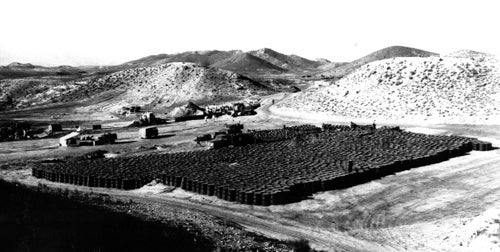
In fact, U.S. government agencies often go to great lengths to secure lost weapons. One such incident occurred on Jan. 17, 1966, when a B-52 and a KC-135 refueling tanker collided over southern Spain and scattered four B-28 thermonuclear bombs around the fishing village of Palomares. The conventional explosives for two of the bombs exploded, but the nuclear components did not detonate because they were not armed. The U.S. military sent troops to pick up the undetonated one that fell on land, clean up the radioactive pieces scattered by the two which detonated, and find the fourth which landed in the sea. The U.S. government even dispatched a submarine to find the one in the Mediterranean Sea. Called ‘Alvin,’ the small deep-ocean sub was high-tech for its time, but the crew nearly died when the sub was almost entangled in the parachute that was still attached to the bomb on the ocean floor. Meanwhile, the service members who helped find the landward bombs and clean up the wreckage also developed cancers which they say are linked to that mission 56 years ago.
Considering the extent to which the U.S. looks for lost nukes like it did in Palomares, the stories behind the five instances where recovery crews could not locate or recover weapons are extraordinary. Below is a list of those five accidents, one of which resulted in two missing nuclear weapons. Keep in mind that in all but one, the lost nuclear weapons did not include the pit or capsule that contains the components for triggering a nuclear detonation. That means we can all sleep a little easier knowing those weapons cannot blow up a city. However, the U.S. government still classifies those pit-less devices as nuclear weapons: sophisticated, expensive machines that at the time were closely-guarded tools of mass destruction. And there are many more out there from other governments like the Soviet Union which may never be found.
Nuclear waste shipments to repository near Carlsbad lagging behind goals for 2022
“So far in FY 2022, most of WIPP’s shipments came from Idaho National Laboratory to fulfill statutory agreements between the DOE and the State of Idaho.”
By Adrian Hedden, Carlsbad Current-Argus | August 26, 2022 currentargus.com
Nuclear waste managers in New Mexico are about 90 shipments of waste short of their goal at the Waste Isolation Pilot Plant for fiscal year 2022 which ends in about a month.
Records show WIPP accepted 206 shipments so far for FY 2022, which runs from Oct. 1, 2021 to Sept. 30, 2022.
During an Aug. 4 meeting before lawmakers, WIPP officials said the facility was targeting 299 shipments this year.
Transuranic (TRU) waste is shipped to WIPP near Carlsbad for permanent disposal in an underground salt deposit about 2,000 feet below the surface.
It comes from U.S. Department of Energy facilities throughout the nation, and is made up of clothing materials and equipment irradiated during nuclear activities.
Watchdog groups call review at US nuclear lab ‘sham’ process
“This is too little too late, a sham process designed to circumvent citizen enforcement of the National Environmental Policy Act,” said Jay Coghlan, executive director of Nuclear Watch New Mexico. “The key sentence in NNSA’s announcement is that absent any new decisions in the site-wide environmental impact statement, the agency will continue to implement decisions it previously made behind closed doors.”
By SUSAN MONTOYA BRYAN | August 19, 2022 apnews.com
ALBUQUERQUE, N.M. (AP) — The U.S. government is planning to review the environmental effects of operations at one of the nation’s prominent nuclear weapons laboratories, but its notice issued Friday leaves out federal goals to ramp up production of plutonium cores used in the nation’s nuclear arsenal.
The National Nuclear Security Administration said the review — being done to comply with the National Environmental Policy Act — will look at the potential environmental effects of alternatives for operations at Los Alamos National Laboratory for the next 15 years.
That work includes preventing the spread and use of nuclear weapons worldwide and other projects related to national security and global stability, the notice said.
Watchdog groups contend that regardless of the review, the NNSA will march ahead with its production plans for plutonium cores at Los Alamos.
Federal agency to conduct sitewide review of Los Alamos National Laboratory
“This is in direct contradiction to the National Environmental Policy Act’s requirement that federal agencies take a ‘hard look’ at proposed actions before implementation,” Jay Coghlan, executive director of Nuclear Watch New Mexico, said in a statement.
So much happened after 2008 that called for a new, thorough impact study years ago, including the plutonium facility’s “checkered nuclear safety history” that led to its major operations shutting down for more than three years, Coghlan said.
A new sitewide analysis now, Coghlan said, will merely “rubber stamp the billions of taxpayers’ dollars being sunk into a predetermined decision to expand plutonium pit production at LANL.”
By Scott Wyland swyland@sfnewmexican.com The Santa Fe New Mexican | August 19, 2022 santafenewmexican.com
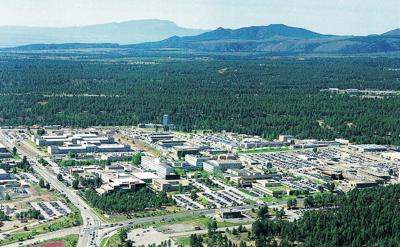
The federal agency that oversees nuclear weapons will conduct a sitewide environmental review at Los Alamos National Laboratory, breaking from its past resistance to performing fresh analysis of potential impacts as the lab gears up to make 30 nuclear warhead triggers a year.
The National Nuclear Security Administration announced in the Federal Register on Friday it would do a sitewide analysis of the lab under the National Environmental Protection Act and would take public comment until Oct. 3.
It’s the first time the agency, a branch of the U.S. Department of Energy, has done a new sitewide environmental impact statement in 14 years.
ATOMIC MASS In Santa Fe, an Archbishop calls for nuclear disarmament through faith alone.
“Jay [Coghlan] of Nukewatch, invited by Wester to answer an audience question about Ukraine having lost deterrence when it returned Soviet nuclear weapons to Moscow, emphasized that Ukraine never had the controls to actually detonate nuclear weapons stored on its territory. Coughlin then echoed Beamont’s statement, saying ‘we can flip the argument, say that Russia is shielded from consequences because it has nuclear weapons. Deterrence has been flipped on its head.’”
BY: KELSEY D. ATHERTON, INK STICK MEDIA | August 10, 2022 inkstickmedia.com
At least 100 parishioners must have been in attendance at the special mass at the Cathedral Basilica of Saint Francis of Assisi on Aug. 9, 2022. The Tuesday afternoon service at the historically significant church did not fall under the usual schedule. Following an afternoon rich in monsoon thunderstorms, the clouds cleared, allowing regulars and visitors alike to file in to hear what, exactly, the Archbishop of the Santa Fe Archdiocese had to say about the work of peace.
“In the way that 109 East Palace was the gateway to nuclear oblivion, I hope that the Basilica of St. Francis can be the gateway to global nuclear disarmament,” John C. Wester, Archbishop of Santa Fe, told the assembled crowd.
The address is instantly familiar to those fluent in nuclear history and opaque outside of it. During the Manhattan Project, the US effort to develop and build an Atomic Bomb in Los Alamos, 109 East Palace was the place to arrive before being covertly whisked away to the lab.
WHEN IT COMES TO SALVATION FROM NUCLEAR OBLIVION, FAITH IN THE RIGHTEOUSNESS OF THE TASK ALONE IS NOT ENOUGH. THERE MUST BE WORK THAT MAKES IT REAL.
It was the work of Los Alamos that made Aug. 9 the occasion for a mass dedicated to nuclear disarmament. On Aug. 9, 1945, the US dropped Fat Man, the second and so far last nuclear weapon used in war. The bomb fell on Nagasaki, a Japanese city hastily added to the targeting list. While the bombardier claims the clouds parted for visual confirmation of the target, it is at least equally plausible the crew decided to drop the bomb by radar targeting and fly back to base, instead of ditching it in the ocean or crashing on the way back.
Archbishop Wester apologizes for harms caused by nuclear weapons industry
“I challenge us at the most personal level to ask ourselves, ‘How do we live each day? Do we live each day consistent with the core values of faith, love and compassion … for one another?” – Archbishop Wester
Catholic News Service | August 10, 2022 catholicnews.com
New Mexico archbishop whose archdiocese is home to two major federal nuclear weapons research facilities and an Air Force base apologized for the atomic bombings of Japan and to Indigenous New Mexicans, uranium miners and scientists suffering from ill health related to the nuclear weapons industry.
Archbishop John C. Wester of Santa Fe said the time has come for the world to fervently work to undertake the long process to achieve nuclear disarmament.
He made the comments in a homily during a Mass Aug. 9 marking the 77th anniversary of the bombing of Nagasaki, Japan.Continue reading
On this solemn anniversary, another look at a nuclear future
“Continuing to develop weapons that don’t just kill but have the potential to decimate the planet is a seemingly accepted part of modern life.
Yet on this anniversary of the bombing of Nagasaki, it is useful to consider whether humanity can find a different path forward.”
OUR VIEW | The Santa Fe New Mexican | August 8, 2022 santafenewmexican.com
August is a particularly dark month in human history.
On Aug. 6 and Aug. 9, 1945, humanity revealed it had the ability to destroy itself; the United States chose to drop atomic bombs first on Hiroshima and then on Nagasaki to force Japan to surrender and end World War II. The destruction was horrific, with tens of thousands of people killed, buildings leveled and thousands more dying of lingering radiation sickness in the years that followed.
New Mexico played an outsized role in the bomb’s deployment. It was developed by the Manhattan Project scientists in the then-secret city of Los Alamos and tested at White Sands. Today, Los Alamos National Laboratory continues its mission of solving national security challenges, with the current emphasis gearing up to manufacture the plutonium pits at the core of nuclear weapons.
By 2026, LANL is supposed to be ready to make 30 pits a year, with another 50 pits annually coming from the Savannah River Site in South Carolina by 2030.
The weight of a butterfly
“Of the 64 kilograms of uranium in the Hiroshima bomb, less than one kilogram underwent fission, and the entire energy of the explosion came from just over half a gram of matter that was converted to energy.
That is about the weight of a butterfly.”
By Emily Strasser, Bulletin of the Atomic Scientists | August 6, 2022 thebulletin.org
The design for the first atomic bomb was frighteningly simple: One lump of a special kind of uranium, the projectile, was fired at a very high speed into another lump of that same rare uranium, the target. When the two collided, they began a nuclear chain reaction, and it was only a tiny fraction of a second before the bomb exploded, forever splitting history between the time before the atomic bomb and the time after.
At 17 seconds past 8:15 a.m. on August 6, 1945, the Enola Gay released the bomb from a height of 31,600 feet above the target, a T-shaped bridge in the center of Hiroshima, Japan.
The morning was cloudless, as the weather plane sent to scout for the Enola Gay had reported in the hour before. If the weather had been poor, the plane would have set its course to one of the two alternate targets. As the bomb fell, a schoolboy closed his eyes and began to count as his friends hid along the way to school.
Nuclear threat higher now than in Cold War, British official warns
“’We are entering a dangerous new age,’ [Lovegrove] added, citing the spread of advanced weapons and cyberwarfare.”
BY Ellen Francis © WASHINGTON POST | July 28, 2022 washingtonpost.com
Britain’s national security adviser has warned that a breakdown in dialogue among rival powers is raising the risk of nuclear war, with fewer safeguards now than during the Cold War.
As such, he said, Britain strongly supports President Biden’s talking with Beijing.
The Economist on “The NPT at 50+”: Will the Ukraine war ring the knell for nuclear arms control?
“America offers to resume nuclear talks with Russia, and calls for China to join. But the outlook is dark”
© THE ECONOMIST | July 31, 2022 economist.com
Editor’s note (August 1st 2022): President Joe Biden today offered to “expeditiously negotiate” a new nuclear arms-control deal with Russia to replace the New START treaty, which expires in 2026. Mr Biden also put pressure on China to discuss limits on its growing nuclear arsenal. It is not clear whether either power will take up his call, but it allows America to cast itself as a responsible power at the start of a big nuclear conference in New York.
Russian Defense Ministry officials show off the 9M729 cruise missile at the military Patriot Park outside Moscow on January 23, 2019.CreditVasily Maximov/Agence France-Presse — Getty ImagesIn the sea of hostility between America and Russia, an island of co-operation endures: the rival powers routinely share information about their long-range nuclear weapons, from the movement of warheads in and out of maintenance to telemetry from ballistic-missile launches. This is both striking and reassuring in the sixth month of war in Ukraine, as Russia periodically threatens to use nuclear weapons and America warns of “severe consequences” if it does.
Environment Department Unhappy With Pace Of DOE Characterization, Cleanup Of LANL Chromium Plume
“’We felt that the cleanup was not moving as quickly as it should be moving and then we entered into litigation with DOE. It was moved from state court to federal court. The current LANL cleanup end date for DOE is 2036, which is in the Consent Order, and we don’t feel that they’re going to be able to make that timeline based on the progress they’re making at this time,’ Catechis said.”
BY MAIRE O’NEILL | July 27, 2022 losalamosreporter.com
New Mexico Environment Department Resource Protection Division Director Chris Catechis is not mincing his words when he discusses NMED’s position on the hexavalent chromium plume discovered in 2005 which is part of the legacy waste clean-up mission at Los Alamos National Laboratory.
At a recent meeting of the Legislative Interim Committee on Radioactive & Hazardous Waste, both Catechis and Rep. Christine Chandler of Los Alamos raised concerns that Department of Energy Environmental Management program at LANL is not taking an aggressive enough approach to characterization of the chromium plume.
Catechis explained the 2016 Consent Order between DOE and NMED dealing with legacy waste from LANL left since the Manhattan Project era. The 2016 Consent Order, which is an update from the original 2005 Consent Order, NMED and DOE officials meet each year to set up a series of milestones, campaigns and targets for the coming federal fiscal year that starts Oct. 1. Catechis said an example of those is the Chromium Interim Measure that deals with the characterization of the chromium plume.
From Russia to Ohio…to the Cancer Ward
“According to the Departments of State and Energy, there was a deliberate decision by the U.S. government that U.S. interests would be served by allowing a portion of the highly enriched uranium to be blended into low enriched uranium and to be rapidly removed from Russia while the details of the transparency measures were being worked out,” the GAO report states.”
BY Ken Silva | July 12, 2022 libertarianinstitute.com
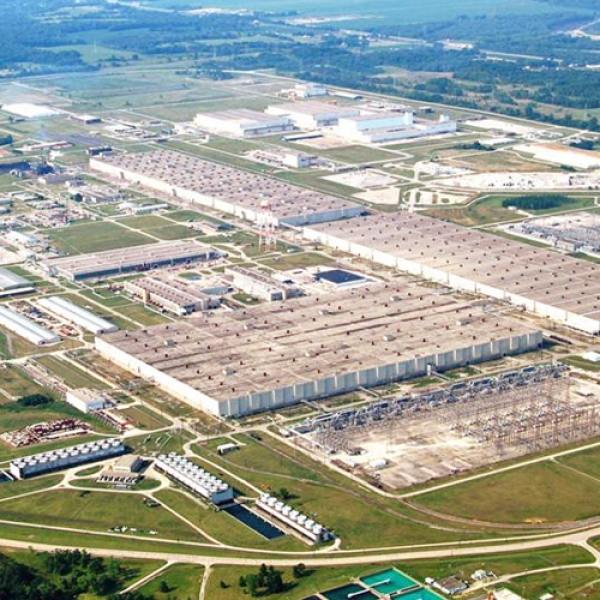
Residents of Piketon, Ohio have long suspected that the area’s sky-high cancer rate stems from the nearby Portsmouth Gaseous Diffusion Plant (PORTS), which served as a uranium enrichment facility for nuclear bombs throughout the Cold War.
Recent reporting from Local 12 WKRC-TV anchor Duane Pohlman sheds light on why the area’s cancer epidemic—more than 500 cases per 100,000, or about 10 percent above state average, according to the Ohio Cancer Atlas—has persisted decades after PORTS stopped helping Uncle Sam build nukes.
Pohlman revealed in May that the PORTS may have been the recipient of polluted uranium from Russia in the 1990s due to a Bill Clinton-era program called “Swords to Ploughshares,” which entailed the United States converting Soviet Union nuclear warheads to uranium that could be used to power U.S. nuclear reactors. Pohlman’s reporting suggests that some of that material was laced with plutonium.
MORE LAB EXPANSION: MAKING WAY FOR NEW PLUTONIUM PIT PRODUCTION ACTIVITY? NNSA/DOE Update: “Los Alamos Field Office Clears Way to Lease Warehouse, Storage Space within 150 miles of Laboratory”
“Multiple properties could be needed to meet LANL needs…Items that would be warehoused or stored include items that are needed for LANL operations,”
BY Carol A. Clark , Los Alamos Daily Post | July 22, 2022 ladailypost.com
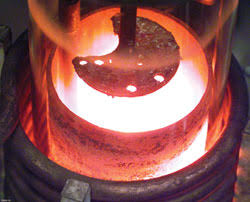
The Department of Energy National Nuclear Security Administration’s Los Alamos Field Office (DOE/NNSA) has issued a Categorical Exclusion to lease properties to provide warehouse and storage space for Los Alamos National Laboratory (LANL) equipment within a 150-mile radius of LANL, which could include properties in several locations of northern New Mexico and southern portions of Colorado.
Nuclear strategy and ending the war in Ukraine
“Removing U.S. nuclear weapons from Europe and Turkey would not weaken NATO militarily, since nuclear weapons have little or no actual usefulness on the battlefield. If they are truly weapons of last resort, there is no need to deploy them so close to Russia’s border. ”
A bold idea: NATO offers to withdraw nukes from Europe (militarily useless, ineffective deterrents as we’ve just seen, & recklessly dangerous) in return for ending the invasion. Putin gets a “win” which costs us nothing worth having. https://t.co/P5txyLEcMs
— Steven Pinker (@sapinker) July 25, 2022
BY OSCAR ARIAS AND JONATHAN GRANOFF, The Hill | July 25, 2022 thehill.com
It is time for bolder efforts to make peace in Ukraine.
War, like fire, can spread out of control, and as President Putin keeps reminding us, this particular conflagration has the potential to start a nuclear war.
At a recent joint news conference with the President of Belarus, Putin announced that Russia would transfer Iskander M missiles to Belarus. Those missiles can carry nuclear warheads, and the move is apparently intended to mirror nuclear sharing arrangements the United States has with five NATO allies — Belgium, the Netherlands, Germany, Italy, and Turkey.
U.S. nuclear weapons were introduced into Europe in the 1950s as a stopgap measure to defend NATO democracies whose conventional forces were weak. The number of nuclear weapons in those five countries peaked around 7,300 warheads in the 1960s, then dwindled to about 150 today, reflecting NATO’s growing conventional strength and its diminishing estimation of the military usefulness of nuclear weapons. But even 150 nuclear weapons could be more than sufficient to touch off a dangerous confrontation with Russia.
Nuclear News Archives – 2021
To Avoid Armageddon, Don’t Modernize Missiles—Eliminate Them
Land-based nuclear weapons are world-ending accident waiting to happen, and completely superfluous to a reliable deterrent.
“Getting trapped in an argument about the cheapest way to keep ICBMs operational in their silos is ultimately no-win. The history of nuclear weapons in this country tells us that people will spare no expense if they believe that spending the money will really make them and their loved ones safer—we must show them that ICBMs actually do the opposite.“
By Daniel Ellsberg and Norman Solomon thenation.com October 22, 2021
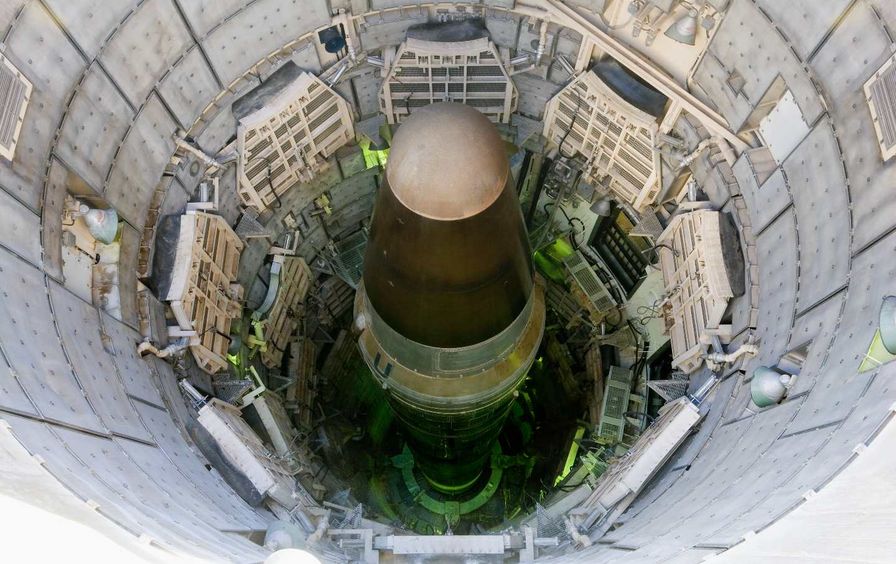
The single best option for reducing the risk of nuclear war is hidden in plain sight. News outlets don’t mention it. Pundits ignore it. Even progressive and peace-oriented members of Congress tiptoe around it. And yet, for many years, experts have been calling for this act of sanity that could save humanity: Shutting down all of the nation’s intercontinental ballistic missiles.
Four hundred ICBMs dot the rural landscapes of Colorado, Montana, Nebraska, North Dakota, and Wyoming. Loaded in silos, these missiles are uniquely—and dangerously—on hair-trigger alert. Unlike the nuclear weapons on submarines or bombers, the land-based missiles are vulnerable to attack and could present the commander in chief with a sudden use-them-or-lose-them choice. “If our sensors indicate that enemy missiles are en route to the United States, the president would have to consider launching ICBMs before the enemy missiles could destroy them. Once they are launched, they cannot be recalled,” former Defense Secretary William Perry warns. “The president would have less than 30 minutes to make that terrible decision.”
The danger that a false alarm on either side—of the sort that has occurred repeatedly on both sides—would lead to a preemptive attack derives almost entirely from the existence on both sides of land-based missile forces, each vulnerable to attack by the other; each, therefore, is kept on a high state of alert, ready to launch within minutes of warning. The easiest and fastest way for the US to reduce that risk—and, indeed, the overall danger of nuclear war—is to dismantle entirely its Minuteman III missile force. Gen.
James E. Cartwright, a former vice chair of the Joint Chiefs of Staff, who had been commander of the Strategic Command, teamed up with former Minuteman launch officer Bruce G. Blair to write in a 2016 op-ed piece: “By scrapping the vulnerable land-based missile force, any need for launching on warning disappears.”
Continue reading
Activists in Santa Fe concerned about plutonium shipping plan
“Santa Fe residents would see shipments of plutonium trucked through the city’s southern edge if federal agencies carry out plans announced nearly a year ago.”
By Scott Wyland • The Santa Fe New Mexican santafenewmexican.com
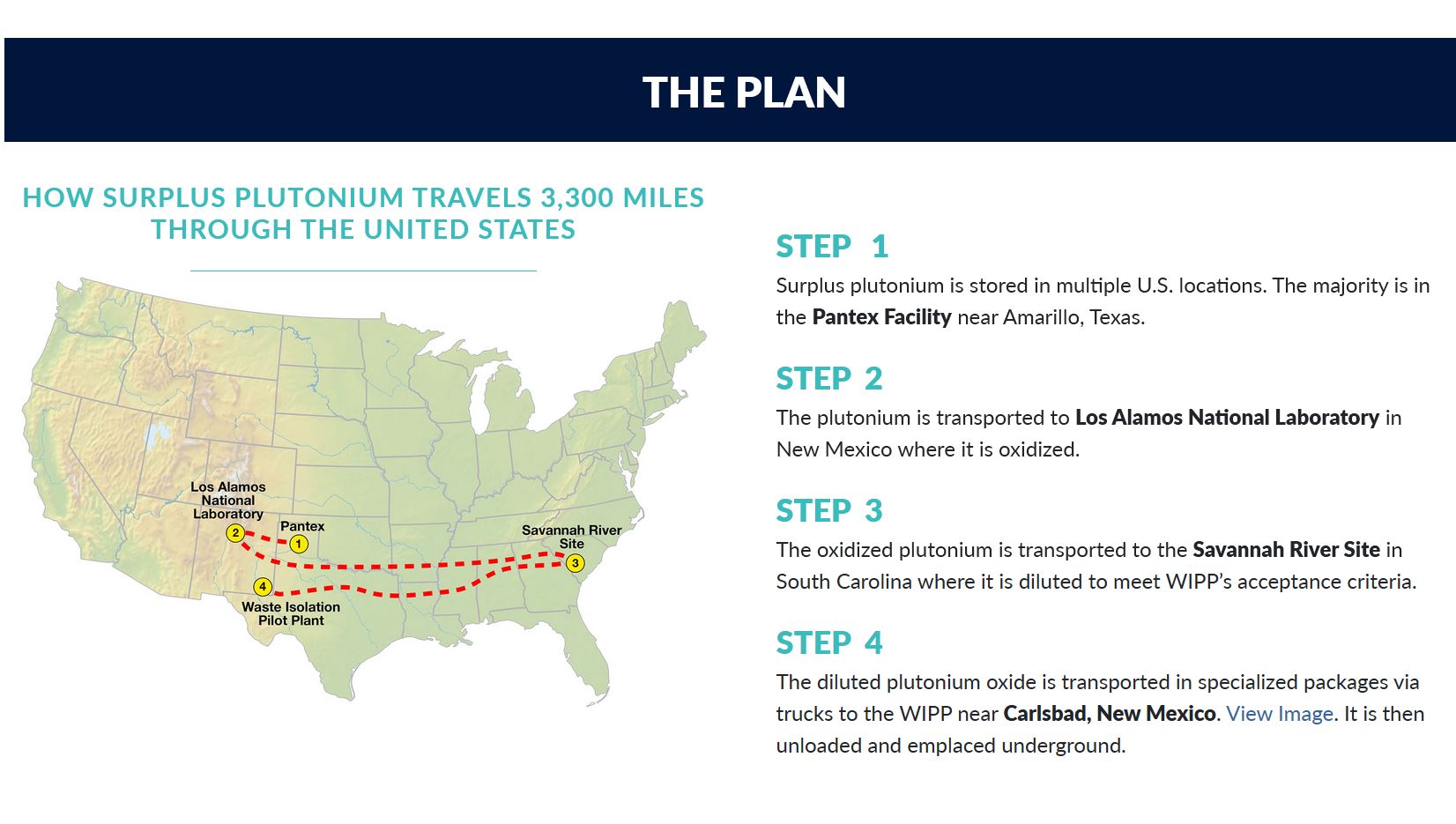 Santa Fe residents would see shipments of plutonium trucked through the city’s southern edge if federal agencies carry out plans announced nearly a year ago.
Santa Fe residents would see shipments of plutonium trucked through the city’s southern edge if federal agencies carry out plans announced nearly a year ago.
The prospect worries activists, local officials and some residents because plutonium is far more radioactive than the waste — contaminated gloves, equipment, clothing, soil and other materials — shipped from Los Alamos National Laboratory to the Waste Isolation Pilot Plant, an underground disposal site near Carlsbad.
The U.S. Department of Energy issued a notice of intent in December to begin the process for an environmental impact statement as one of the first steps toward diluting and disposing of plutonium left from the Cold War.
The notice hints that “downblending” the plutonium would be necessary to reduce radioactivity enough for the waste to be accepted at WIPP, which only takes low-level nuclear waste.
When the US Air Force Accidentally Dropped an Atomic Bomb on South Carolina
On March 11, 1958, the Gregg family was going about their business when a malfunction in a B-47 flying overhead caused the atomic bomb on board to drop on to their S.C. backyard.
By Allison McNearney | thedailybeast.com
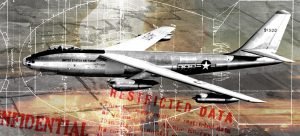 Given the history of nuclear proliferation throughout the 20th century, it seems like a miracle that only two atomic bombs were ever deployed against the human population. And, it turns out, it really was a very lucky break.
Given the history of nuclear proliferation throughout the 20th century, it seems like a miracle that only two atomic bombs were ever deployed against the human population. And, it turns out, it really was a very lucky break.
There is one part of atomic history that hasn’t made the history books. Throughout the Cold War, the U.S. dropped several atomic bombs on unsuspecting people below, bombs that were multiple times more powerful than those dropped on Hiroshima and Nagasaki at the end of World War II. Rather than being acts of extreme aggression, these “broken arrows” as they became known, were pure accidents, explosive “oopsies” committed by the U.S. military against mostly U.S. citizens. In what has been hailed as either luck or very proficient engineering of safety devices, none of the nuclear components on the falling bombs actually detonated.
Santa Fe County Nuclear Waste Emergency Response Town Hall October 19th
In response to community concerns about the proposed increased shipments of more dangerous forms of plutonium along New Mexico State Road 599, Santa Fe County District 2 Commissioner Anna Hansen will host a Nuclear Waste Emergency Response Town Hall on Tuesday, October 19th from 6 to 7:30 pm. Town Hall Nuclear Waste Flyer 10-19-21 The Department of Energy (DOE) has made elaborate plans to transport plutonium nuclear weapons triggers to Los Alamos National Laboratory (LANL) for processing. 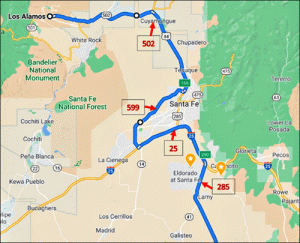 The triggers are currently stored at the Pantex facility, north of Amarillo, Texas. Questions and comments from the public are encouraged during the Town Hall. Town Hall Nuclear Waste Meeting Agenda 10-19-21
The triggers are currently stored at the Pantex facility, north of Amarillo, Texas. Questions and comments from the public are encouraged during the Town Hall. Town Hall Nuclear Waste Meeting Agenda 10-19-21
The proposed route is approximately 3,300 miles. Interstate 40 at Clines Corners would be the primary route to U.S. Route 285. The shipments would then head north to Interstate 25, past the Eldorado communities, before connecting with the 599 Bypass around Santa Fe. Much of the bypass is located within Commissioner Hansen’s district. From the bypass, the shipments would travel north on 285 to Pojoaque, then west on 502 to LANL. After processing, the shipments would follow the reverse route to Interstate 40 and east to the Savannah River Site in South Carolina for further processing. The shipments would once more head west to the Waste Isolation Pilot Plant (WIPP), near Carlsbad, New Mexico. Up to 47 metric tons of what is called “surplus” plutonium could be shipped, processed and disposed at WIPP.
 In response to constituent concerns, Santa Fe County Commissioners Hank Hughes and Anna Hamilton held a similar Town Hall at the Arroyo Hondo Fire Station in August. https://www.sfreporter.com/news/2021/08/10/waste-on-wheels/
In response to constituent concerns, Santa Fe County Commissioners Hank Hughes and Anna Hamilton held a similar Town Hall at the Arroyo Hondo Fire Station in August. https://www.sfreporter.com/news/2021/08/10/waste-on-wheels/
During the October 19th Town Hall, Cynthia Weehler, citizen activist and former chemistry teacher, will present highlights of the DOE’s proposal to expand the WIPP repository, including the transportation of additional weapons-grade plutonium throughout Santa Fe County. www.kob.com/new-mexico-news , www.santafenewmexican.com/opinion/my_view/speak-out-on-the-future-of-wipp/
Santa Fe County Fire Chief Jackie L. Lindsey will give a presentation about Santa Fe County’s emergency preparedness and response in the unlikely event of a toxic and radioactive waste incident. https://www.santafecountynm.gov/fire/fire_chief_and_command_staff
New Mexico State Representative Tara Lujan will also be in attendance. https://nmlegis.gov/Members/Legislator?SponCode=HLUTA
The Town Hall is being held at the Nancy Rodriguez Community Center, at One Prairie Dog Loop, in Santa Fe, which is off County Road 62 between the Agua Fria Fire Station and La Familia Medical Center.
For more information, please contact Anna Hansen, Santa Fe County Commissioner, at 505-986-6329, or ahansen@santafecountynm.gov. https://www.santafecountynm.gov/county_commissioners/anna_hansen
Radioactive Waste Fell On Some LA-Area Neighborhoods During 2018 Woolsey Fire, New Study Shows
The majority of samples found just “background” or normally occurring levels of radioactivity. But 11 samples showed significantly elevated levels of radioactive materials.
By Joel Grover and Josh Davis • abclosangeles.com
High levels of radioactive particles landed in neighborhoods from Thousand Oaks to Simi Valley during the massive 2018 Woolsey fire, which started at the contaminated Santa Susana Field Lab, according to a peer-reviewed study just published by a team of scientists known for studying environmental disasters.
What’s stunning about the findings is that they run contrary to what California’s Department of Toxic Substances Control (DTSC) said to calm public fears in the hours after the Woolsey Fire, “We do not believe the fire has caused any releases of hazardous materials… associated with contamination at the [SSFL] site.”
“The DTSC lied. They said that contamination from hadn’t migrated away from Santa Susana and the study proves that it has,” said Jeni Knack, part of a group of volunteers who helped collect samples analyzed in the study.
Knack participated in the sample collection because she had a background doing data collection on archaeological sites, and because she’s the mom of a 6-year old who lives in Simi Valley, just five miles from Santa Susana.
“I was afraid that radioactive and chemical contamination were being carried by wind and smoke during the fire,” Knack told NBC4.
Radioactive Waste Could Be Killing Residents in Missouri Community, Say Federal Scientists
For decades, North St. Louis residents have lived in fallout from the Manhattan Project. Now, federal scientists are finally linking today’s cancers to the nation’s nuclear warfare legacy.
By AUSTIN PRICE • earthisland.org
n Bridgeton, on the northern edge of St. Louis County, Missouri, a fire burns underground in a vast landfill, creeping closer and closer to a pile of radioactive waste from the World War II era that was dumped there back in the 1970s. This “subsurface smoldering event,” as these odorous, high-temperature chemical reactions are called, at the West Lake Landfill has burned continuously for almost a decade now, keeping nearby residents all too aware of the Superfund site in their backyard.

For years, many of these residents have filed lawsuits against Cotter Corporation and Mallinckrodt, the companies responsible for dumping the radioactive nuclear waste in the unlined landfill (a former limestone quarry) as well as in open piles on a field near what’s now the Lambert-St. Louis International Airport. These residents say that this waste has contaminated their homes. Many have sparred in open forums with officials from the Environmental Protection Agency. Others have met personally with EPA Administrator Andrew Wheeler. All want answers to an unending list of questions.
As Dawn Chapman, co-founder of the grassroots advocacy group Just Moms STL and a mother of three who lives 2 miles from landfill, told me, “The battles at this site never end.”
Meanwhile, the fire burns. Closer and closer to the radioactive waste, like a ticking time bomb. But for many North County residents, that bomb has already gone off, and it’s fallen to members of the community to pressure local and federal officials to help pick up the pieces. Now, federal scientists at the Agency for Toxic Substances and Disease Registry are finally starting to admit the mistakes of the nation’s toxic past.
Navy nuclear engineer and his wife charged with trying to share submarine secrets with a foreign country
By Devlin Barrett and Martin Weil | washingtonpost.com
The court papers say that in December 2020, an FBI official received a package that had been sent to the foreign country containing U.S. Navy documents, a letter and instructions for how to conduct encrypted communications with the person offering the information.
Abdul Qadeer Khan, Father of Pakistan’s Nuclear Program, Dies at 85
Starting from scratch in 1976, he acquired the technology and knowledge that allowed Pakistan to detonate its first nuclear device in 1998.
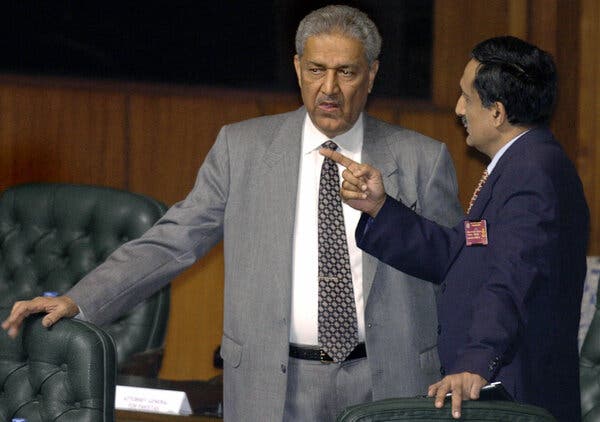
Abdul Qadeer Khan, a metallurgist who became known to Western intelligence services as the father of Pakistan’s nuclear bomb and a worldwide dealer in weapons technology, died Sunday at a hospital in Islamabad, Pakistan. He was believed to be 85 years old.
Dr. Khan’s death was reported by Pakistan’s interior minister, Sheikh Rasheed Ahmad. The apparent cause was complications from Covid-19, he said.
Dr. Khan was the man who made Pakistan a nuclear power. For at least 25 years, starting from scratch in 1976, he built, bought, bartered and stole the makings of weapons of mass destruction.
To millions of Pakistanis, he was a national hero, the man who developed a nuclear program to match the country’s rival, India. To the C.I.A., he was one of the more dangerous men on earth.
Pakistan’s prime minister, Imran Khan, on Sunday said that he was “deeply saddened” by Dr. Khan’s death, praising him for “his critical contribution in making us a nuclear weapon state.”
“This has provided us security against an aggressive, much larger nuclear neighbor,” Mr. Khan tweeted, referring to India. “For the people of Pakistan he was a national icon.”
International Day for the Total Elimination of Nuclear Weapons at Ghedi Base in Italy
View photos below of the initiative near the Italian base of Ghedi, which hosts US nuclear warheads, on the occasion of the International Day for the Total Elimination of Nuclear Weapons.



How do humans make sense of the bomb?
This stunning photo essay by Robert Del Tredici details the history of the atomic bomb through portraits of monuments, culture, and humans who co-exist with the bomb, from survivors to activists to nuclear scientists in At Work in the Fields of the Bomb.
Photography and introduction by Robert Del Tredici. Captions by Robert Del Tredici and Gordon Edwards. | October 9, 2021 | The Bulletin thebulletin.org
From the moment the atomic bomb was invented, humanity has struggled to make sense of it. It is a weapon of war, an enforcer of peace, a talisman of sovereignty, a fountainhead of undying radioactivity, and a fateful burden for humans into the far future. Yet the bomb’s physical presence—its deep grit and material magnitude of its mass production—has remained culturally invisible.
I wanted to take on this invisibility. I found out that the American bomb’s home ground had 12 factories, each making different materials and parts. I learned that each factory had a public relations officer. And I found out that the airspace above each plant was unrestricted.
But before engaging with the US nuclear weapons complex, I went to Hiroshima. I needed to find the human meaning of the bomb. One Hiroshima survivor told me, “If you weren’t there when it happened, you can have no idea what it was like.” Another told me, “Nuclear weapons and human beings cannot coexist.” I told them I wanted to photograph all of the American bomb-factories. An elderly survivor came over to me, put her hand on my arm and said, “Yes, you must do this.” Five years later, I completed my book of photographs and field notes, At Work in the Fields of the Bomb.

Model of the Uranium Atom
American Museum of Science and Energy, Los Alamos, New Mexico
June 11, 1982
Of all the naturally occurring materials found on Earth, uranium is the only element whose atoms can be split in a process that releases energy and neutrons in a chain reaction. The neutrons go on to split more atoms, which release more energy and more neutrons, until an exponential increase in energy ignites an atomic fireball. In the photo, two boys play at shouldering the model of the atom, which is too big for them to handle.
The atomic bomb was conceived within living memory, and unless abolition ends it, the bomb will be passed on to our grandchildren’s grandchildren—a burden weightier than Atlas could have imagined.
Nuclear talks with US to resume ‘soon,’ Iranian foreign minister says
The US left the JCPOA in 2018, citing continued malign behavior by Iran in the region, and implementing a “maximum pressure” sanctions regime, but Biden seeks a return to the policy.
“Until Iran returns to the negotiating table, the other parties must also make new decisions and show their will and intention for the success of the talks and fulfilling their commitments,” he added.
Ex-CEO who oversaw doomed nuclear project sentenced
An executive who lied to regulators about two South Carolina nuclear plants that never generated a watt of power has been sentenced to two years in prison
By JEFFREY COLLINS Associated Press abcnews.go.com October 7, 2021
COLUMBIA, S.C. — A utility executive who repeatedly lied to keep investors pumping money into South Carolina’s $9 billion nuclear reactor debacle will spend two years in prison for fraud, a federal judge decided on Thursday.
Former SCANA Corp. CEO Kevin Marsh agreed with prosecutors that he should serve the sentence and the judge approved the deal, making him the first executive put behind bars for misleading the public on the project, which failed without ever generating a watt of power.
Biden administration reveals number of nuclear weapons in US stockpile
“The Biden administration’s decision to declassify updated information on the number of nuclear warheads in the U.S. nuclear weapons arsenal is a welcome step that reverses an unwise decision by the Trump administration to classify this information,” the Arms Control Association said in a statement Wednesday.
“It also puts pressure on other nuclear armed states that maintain excessive secrecy about their arsenals.”
By Chandelis Duster and Nicole Gaouette, CNN, benningtonbanner.com October 7, 2021
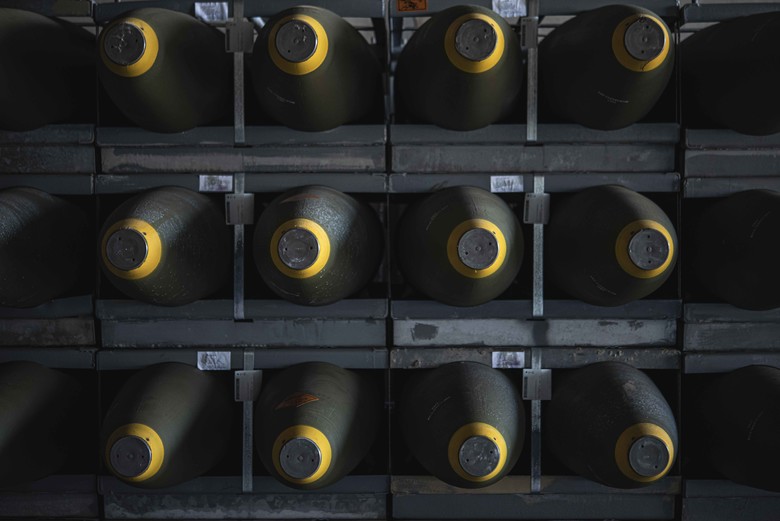
(CNN) In a reversal from the Trump administration, the State Department revealed the number of nuclear weapons in the US stockpile for the first time in four years on Tuesday.
“Increasing the transparency of states’ nuclear stockpiles is important to nonproliferation and disarmament efforts, including commitments under the Nuclear Non-Proliferation Treaty, and efforts to address all types of nuclear weapons, including deployed and non-deployed, and strategic and non-strategic,” the State Department said.
Nuclear submarines will not deter China from conflict with Taiwan, but Australia has an alternative arsenal
As a committed supporter of international institutions and the world’s 13th largest economy, Australia has real clout
“As the gap between China’s military and Australia’s widens, it is unlikely that Australia’s capability – even with a fleet of nuclear submarines, supplied by its Aukus partners – will determine the balance of military power in the Indo-Pacific.”
By Jonathan Pearlman October 6, 2021 The Guardian theguardian.com
For an emerging superpower prone to petulant outbursts and coercive retaliation, China’s initial response to the recent announcement of the new three-way security pact between Australia, the United States and Britain seemed surprisingly tepid.
Hours after the trio unveiled their “forever partnership”, known as Aukus, China formally requested that it be allowed to join an 11-member Asia-Pacific trade grouping, the Comprehensive and Progressive Agreement for Trans-Pacific Partnership (CPTPP).
This was an odd move by China, whose application requires the consent of the grouping’s members, which include Australia. In recent years, China has responded to previous perceived slights from Canberra by imposing economic sanctions worth $20bn and freezing ministerial contacts.
Nuclear-Weapon-Free States Demand Immediate End to Deterrence Policies, Start of Dismantling Atomic Arsenals, as First Committee Continues General Debate
Calling for swift remedies to mend a fractured non-proliferation landscape, nuclear-weapon-free States demanded an immediate end to deterrence policies and the start of dismantling atomic arsenals, as the First Committee (Disarmament and International Security) moved into the third day of its general debate.
UNITED NATIONS MEETINGS COVERAGE GENERAL ASSEMBLY FIRST COMMITTEE SEVENTY-SIXTH SESSION, 4TH MEETING (PM)
As thousands of atomic bombs located around the world pose grave risks to humanity, delegates implored nuclear-weapon States to steer the planet onto a path of peace. Some suggested such ways to do so, with delegates agreeing that dismantling nuclear arsenals must start now, in line with the Treaty on the Non-Proliferation of Nuclear Weapons and under safeguards established by the International Atomic Energy Agency (IAEA). Many urged all nations with atomic arsenals to sign, ratify and fully implement existing conventions, including the Treaty on the Prohibition of Nuclear Weapons, which entered into force in January, and some decried the quarter of a century delay in entering into force the Comprehensive Nuclear-Test-Ban Treaty. To rectify this, many called for nuclear-weapon States to sign and ratify it so that atomic bomb testing can become part of the past.
One Man Shouldn’t Control the Nuclear Button
Congress should require consultation, so generals wouldn’t have to break the rules to save the world.
The critics are missing the point. The overriding issue is not whether Gen. Milley was correct in his assessment, or whether he was authorized to take the reported actions, but what the consequences could have been if his concern had been warranted. It is not hyperbole to say that the consequences could have been a profound tragedy and, in the worst case, the end of civilization.
The Stealthy F-35 Fighter Jet Is One Step Closer to Carrying Nuclear Weapons
“A pair of F-35s from Nellis Air Force Base in Nevada released dummy nuclear bombs at a nearby test range this month, moving the advanced stealth fighter closer to carrying the world’s most powerful weapons into combat, the Air Force said.”
By Stephen Losey • military.com
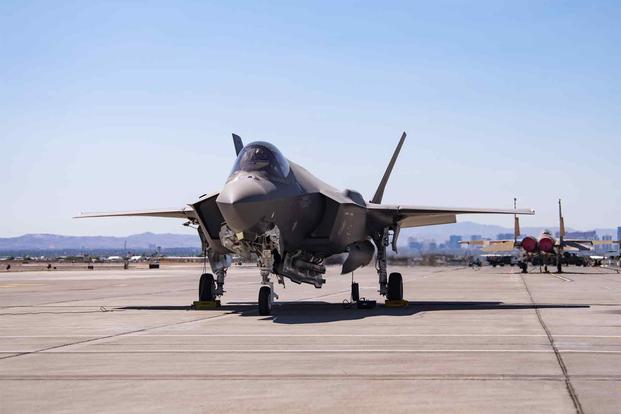
The flights on Sept. 21 marked the “graduation” test exercise necessary for the Air Force variant of the F-35 to move ahead with what’s called the nuclear design certification process, according to the service’s press release.
It’s still not clear when the F-35A will receive its full nuclear certification allowing it to move from training ranges and dummy bombs to real-world battlefields. But when that happens, the Air Force will have a second stealth aircraft in its fleet that can carry nukes.
“The B-2 [Spirit] bomber was the prominent nuclear-capable stealth aircraft,” Lt. Col. Daniel Jackson, division chief for strategic deterrence and nuclear integration at Air Combat Command, said in the press release.
F-15E Strike Eagle and F-16C and D Fighting Falcon fighters do not have stealth capability but can carry nuclear weapons. The B-21 Raider heavy bomber will also have the capability and is expected to join the Air Force’s fleet in the mid-2020s, according to the latest estimates.
Opinion: Too many ‘downwinders’ are still suffering
“We are sponsoring a bill that would make sure the government’s responsibility to those who were harmed by nuclear testing does not get swept under the rug.”
By Burgess Owens and Chris Stewart deseret.com
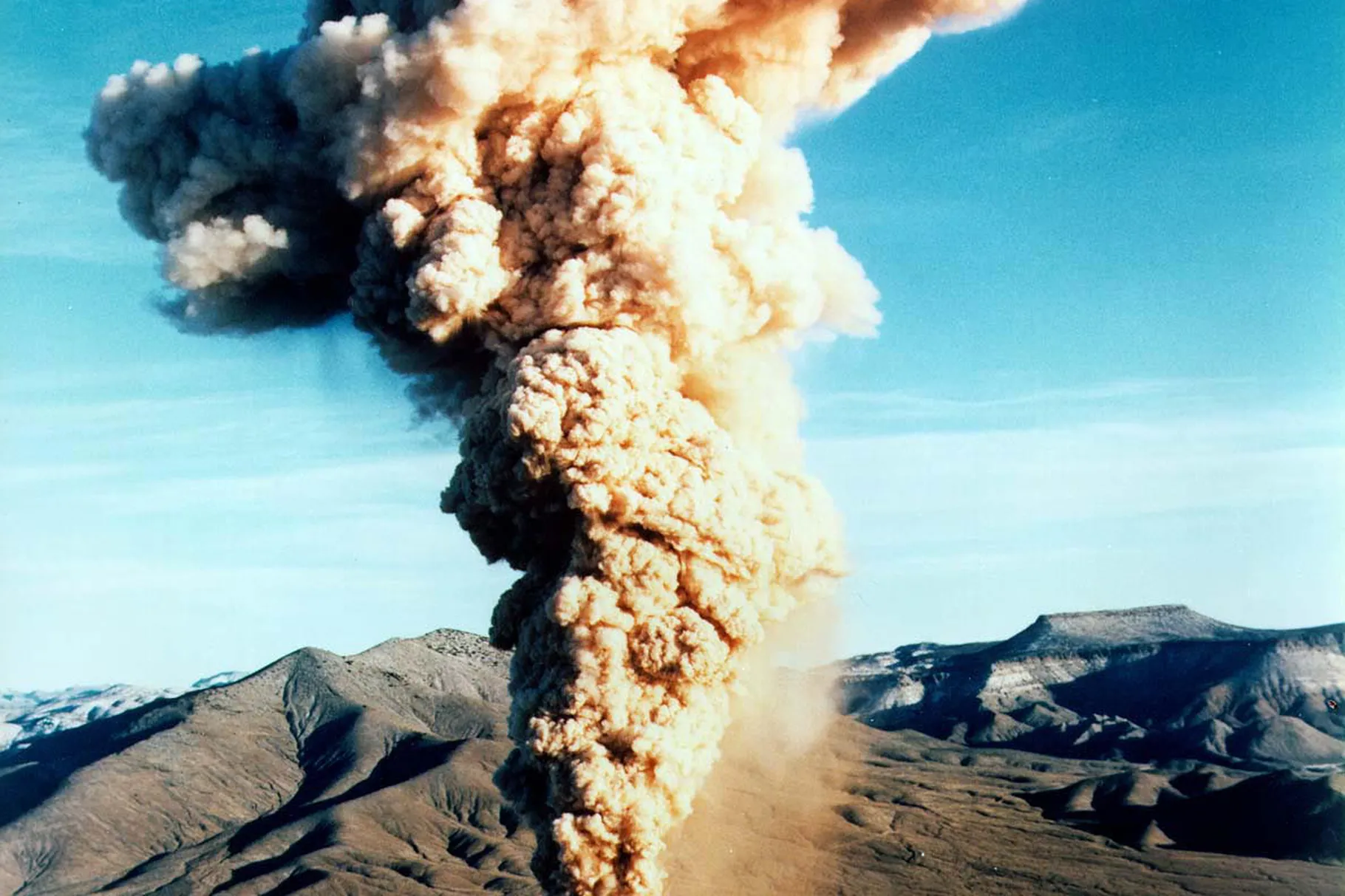
Any objective study of American history brings us to the realization that there are many Americans who quietly made, and continue to make, great sacrifices for our national security. Many of these women and men willingly give of themselves to ensure that our country remains free.
Tragically, under the banner of national security the United States government exposed Americans to radioactive uranium ore and radioactive dust — subjecting them to lung cancer and other respiratory illnesses.
On July 16, we marked the 76th anniversary of the detonation of the first nuclear weapon — code-named Trinity — in the desert of New Mexico’s Tularosa Basin. Three weeks after the Trinity detonation, the United States exploded the Little Boy bomb over Hiroshima and, three days later, the Fat Man bomb over Nagasaki. Six days later, Japan surrendered. In the aftermath of World War II, a nuclear arms race began that reached its zenith with over 60,000 nuclear weapons worldwide in 1986.
Many lives were lost or severely altered by the nuclear weapons program. Thankfully, the world stockpile of nuclear weapons has steadily declined since 1986 and will, hopefully, continue to do so in the future. Yet, the effects of detonating over 1,100 nuclear weapons since the Trinity test in 1945 continue to mar the lives of Americans to this day.
Through atmospheric weapons tests, as well as mining, transporting and milling of uranium ore, many Americans have been slowly killed by radiation exposure. Thousands of Utahns were infected by radiation exposure simply by living “downwind” of the federal government’s nuclear weapons testing sites. Additional Utahn miners were affected as they worked the uranium necessary for these weapons. These “downwinders” and miners and their families friends, and communities often suffered excruciating illness, loss and devastation.
In response to this malfeasance, Congress rightly enacted (and later amended in 2000) the Radiation Exposure Compensation Act (RECA) in 1990. This legislation was a good first step in making recompense to those who mined and hauled uranium ore and those who processed the ore at a mill. The RECA legislation also addresses those exposed to radiation downwind from nuclear test sites.
It has been more than 20 years since any meaningful reform to RECA has been made for those whose lives have been taken or irreversibly altered by our foray into the arms race. Several classifications of workers such as core drillers and ground workers have been denied justice by being excluded completely from the process.
Some diseases that should have been compensable have been excluded. Numerous geographical locations exposed to downwind radiation have been left out. Uranium miners continued to mine after the United States stopped buying uranium for its nuclear weapons programs in 1971. These so-called post-1971 workers were excluded from accessing benefits since the original RECA legislation had an arbitrary cutoff date of Dec. 31, 1971 — even though the federal government continued to regulate uranium mines long after 1971. To make matters worse, RECA is scheduled to sunset in July 2022 — potentially leaving all classifications of exposure victims without redress.
We are honored to represent some of these “downwinders” and their family members and want them to know their suffering — and the sacrifices they made for our nation — are not forgotten.
That is why we are pleased to be the lead Republican members of the House of Representatives on the “RECA Amendments Act of 2021,” legislation that will reauthorize RECA for those still suffering the consequences of nuclear testing.
The tragic consequences of the nuclear arms race cannot be swept under the rug of history. We urge our colleagues in Congress to support the “RECA Amendments Act of 2021.” Our country must act now to address the injustices of those who have been forgotten by their own government.
Rep. Burgess Owens represents Utah’s 4th Congressional District. Rep. Chris Stewart represents Utah’s 2nd Congressional District.
Four Takeaways from the 2021 World Nuclear Industry Status Report
“Although net nuclear capacity rose last year, the 0.4-gigawatt increase was minuscule in comparison with the gains made by renewable energy. ‘Nuclear is irrelevant in today’s electricity capacity newbuild market,’ the industry report concludes.”
By Dawn Stover | October 1, 2021 The Bulletin thebulletin.org
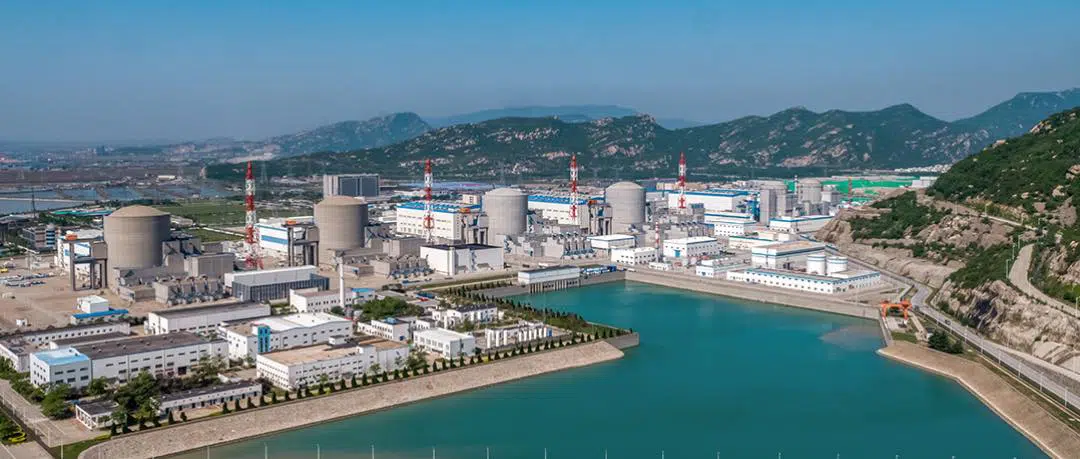
Although there are 23 fewer nuclear reactors in the world today than at the 2002 peak of 438, the past year saw a small uptick in the number of reactors operating worldwide and a corresponding increase in the global fleet’s net operating capacity.
That’s one data point in the World Nuclear Industry Status Report 2021, the latest in a series of annual industry reports compiled by an international team of independent experts led by Mycle Schneider, a consultant based in Paris. The 409-page report, released this week, is packed with information about global and country-specific trends, but several findings stand out, and they don’t bode well for the nuclear energy industry.
First, although nuclear capacity is up, nuclear electricity production is down.
As of mid-2021, there were 415 nuclear reactors operating in 33 countries, seven reactors more than a year earlier. Their total capacity was 1.9 percent higher than a year earlier. But in 2020, the worldwide nuclear fleet generated 3.9 percent less electricity than in the previous year. That was the first decrease in output since 2012, when many reactors remained shut down in the wake of the Fukushima nuclear disaster.
Without China, where most of the new construction is happening, the decrease in production would look even bigger. In 2020, China for the first time produced more nuclear electricity than France, which relies heavily on nuclear energy. Only the United States produced more.
NRDC: Legislation Offers Path Forward on Nuclear Waste
“This legislation could end years of debate and acrimony and help determine a path forward for disposing of nuclear waste. Placing nuclear waste under bedrock environmental laws could ensure strong repository standards, while giving states the power to approve what is sequestered within their borders.”
– Kit Kennedy, managing director for the Climate and Clean Energy program at NRDC (Natural Resources Defense Council)
WASHINGTON – Sen. Ed Markey (D-Mass.) and Rep. Mike Levin (D-Calif.) introduced legislation today that could end a 60-year impasse over our nation’s nuclear waste.
The bill would establish a task force to consider removing exemptions for radioactive waste and spent nuclear fuel from our bedrock environmental laws. Doing so would allow for geologic repositories for nuclear waste that have strong environmental protections and the consent of state leaders and local residents.
Senator Markey and Rep Levin Introduce Legislation to Determine a Viable Consent Based Path Forward for Nuclear Waste
Currently, the United States has no permanent geologic repository for disposal of high-level nuclear waste
“The current system of spent nuclear fuel storage is not sustainable, particularly for sites that no longer have operating reactors and could be redeveloped for other beneficial uses, such as the San Onofre Nuclear Generating Station,” said Representative Levin.
PRESS RELEASE September 28, 2021 markey.senate.gov
Washington (September 28, 2021) – Senator Edward J. Markey (D-Mass.), Chair of the Clean Air, Climate, and Nuclear Safety Subcommittee of the Senate Environment and Public Works Committee, and Congressman Mike Levin (CA-49) today introduced the Nuclear Waste Task Force Act, legislation to establish a new task force to consider the implications of amending the Atomic Energy Act of 1954 to remove exemptions from environmental laws for nuclear waste. Eliminating this loophole could help enable consent-based siting of long-term storage solutions for nuclear waste. The task force would also be responsible for providing a clear explanation of what constitutes “consent-based siting.”
“Enabling consent-based storage is the key to developing real, practical solutions for the long-term storage of nuclear waste. This nuclear waste task force will play a critical role in determining how to make that happen.”
Survivors Of The Trinity Nuclear Test Weren’t Warned — Then Were Lied To After
NPR’s Leila Fadel talks with Lesley Blume about the struggle of the survivors of the Trinity nuclear test in 1945 — one locals didn’t know was coming and caused serious health issues.
“The compensation act – RECA as it’s called – is about to expire next July…What’s happening right now is that several members of Congress from New Mexico and from other Western states are trying to extend RECA, and they’re making a bid to have the Trinity downwinders included under this legislation at last, among other exposed communities.”
NPR News Heard on All Things Considered
An aerial view of the aftermath of the first atomic explosion at the Trinity test site in New Mexico in 1945. The device exploded with a power equivalent to 21,000 tons of TNT. Credit Associated PressLEILA FADEL, HOST:
This was most of America’s introduction to nuclear power.
(SOUNDBITE OF ARCHIVED RECORDING)
HARRY TRUMAN: A short time ago, an American airplane dropped one bomb on Hiroshima and destroyed its usefulness to the enemy.
FADEL: President Harry Truman’s announcement in August of 1945 heralded a terrifying new weapon.
(SOUNDBITE OF ARCHIVED RECORDING)
TRUMAN: It is an atomic bomb. It is a harnessing of the basic power of the universe. The force from which the sun draws its power has been loosed against those who brought war to the Far East.
FADEL: But the Atomic Age actually began the month before At the Alamogordo Bombing and Gunnery Range in New Mexico. The first nuclear test, codenamed Trinity, was a closely guarded secret. Locals, some as close as 12 miles away, had no idea it was coming. Lesley Blume wrote about them for National Geographic.
Welcome back.
LESLEY BLUME: Thank you so much.
FADEL: So, first, tell us what happened during that first test, codenamed Trinity.
BLUME: It was a huge success, but it also – the bomb was a lot more powerful than they had expected, three to five times as powerful. And, you know, initially they thought that the cloud was only going to go up about 12,000 or 13,000 feet. Well, guess what. It went up between 50,000 and 70,000 feet. It created sort of an estimated fallout zone about 100 miles long and 30 miles wide…
“Now is the time to eliminate nuclear weapons from our world, and usher in a new era of dialogue, trust and peace”, declared UN Secretary-General António Guterres on Sunday, marking the International Day for the Total Elimination of Nuclear Weapons.
Addressing the threat of nuclear weapons, said Mr, Guterres, has been central to the work of the United Nations since its inception; the first General Assembly resolution in 1946 sought “the elimination from national armaments of atomic weapons and of all other major weapons adaptable to mass destruction.”
The UN chief pointed out that, although the total number of nuclear weapons has been decreasing for decades, some 14,000 are stockpiled around the world, which is facing the highest level of nuclear risk in almost four decades: “States are qualitatively improving their arsenals, and we are seeing worrying signs of a new arms race.” Humanity, continued the UN chief, remains unacceptably close to nuclear annihilation.
Veterans Group Urges President Biden to Adopt No First Use Policy
To mark the International Day for the Total Elimination of Nuclear Weapons, September 26, Veterans For Peace is publishing an Open Letter to President Biden: Just Say NO to Nuclear War!
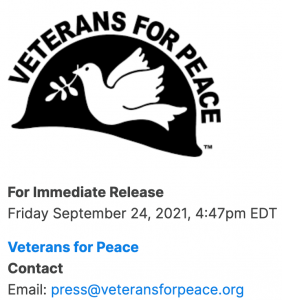
ST. LOUIS, MO –
Veterans For Peace, with over 140 chapters in the United States and affiliates abroad, is calling on President Biden to step back from the brink of nuclear war by declaring and implementing a policy of No First Use and by taking nuclear weapons off hair-trigger alert. The full letter will be published on the VFP website and offered to mainstream newspapers and alternative news sites: Click here to view.
While timed to coincide with the UN-declared International Day for the Total Elimination of Nuclear Weapons, a major motivation for the letter is the Nuclear Posture Review, currently underway.
The letter therefore states, “As veterans who have fought in multiple U.S. wars, we are concerned about the very real danger of a nuclear war that would kill millions of people and could possibly even destroy human civilization. Therefore we are asking to have input into the Nuclear Posture Review that your administration has recently initiated.”
A Little Radiation Is Not Good For You
“…between 1977 and 1990, scientists tripled their estimate of the damage inflicted by a given dose of radiation. A 1992 study published in the American Journal of Industrial Medicine found that nuclear weapons production workers exposed to small doses were four to eight times more likely to contract cancer than previously estimated…even the very lowest background levels of radiation exposure are harmful to health and have statistically significant negative effects on DNA.”

In a rare pushback against the radioactive pollution industry, the Nuclear Regulatory Commission — well known as a rubber stamp for the nuclear lobby — has flatly rejected an attempt to further weaken the agency’s radiation exposure regulations.
After six years of deliberation, the NRC’s three commissioners, two Democrats and one Republican, voted unanimously to reject formal petitions submitted in February 2015 urging the agency to adopt a cost-cutting scheme known as “hormesis” which claims that “a little radiation is good for you.” The September 16 decision by the NRC says this “threshold theory posits that “there is some threshold dose below which there is either no radiation-related health detriment or a radiation-related health benefit that outweighs any detriment.”
The order then rebukes this concept, finding the petitioners “fail to present an adequate basis supporting the request,” and “Convincing evidence has not yet demonstrated the existence of a threshold below which there would be no … effects from exposure to low radiation doses.”
The basis for hormesis had been explicitly rejected ten years earlier, the NRC pointed out, by the National Academy of Sciences in its 2005 report “Biologic Effects of Ionizing Radiation, 7th Ed” or BEIR-VII. The National Research Council summed up its book-length BEIR-7 report saying, “the smallest dose has the potential to cause a small increase in risk to humans.”
Biden’s nuclear agenda in trouble as Pentagon hawks attack
“The decision to fire Leonor suggests to me that the first draft of NPR is going to be a continuation of the line of thinking we saw in the Trump administration’s NPR…They have put themselves on the course that is a first draft that is 180 degrees to what Biden said on the campaign trail.” – Jeffrey Lewis, a professor and nuclear weapons expert at the Middlebury Institute for International Studies and host of the podcast Arms Control Wonk.
By BRYAN BENDER and LARA SELIGMAN | September 23, 2021 politico.com
One of President Joe Biden’s leading allies in his decadeslong attempt to reduce nuclear weapons has lost a battle with the Pentagon’s hawks.
The ouster of Leonor Tomero, who questioned the status quo on nuclear weapons, signals the Biden administration’s ambitious agenda to overhaul America’s nuclear policy might be in trouble.
Early in his administration, Biden installed national security officials intent on negotiating new arms control treaties and curtailing nuclear weapons spending. One of them was Tomero, a leading voice for nuclear restraint on Capitol Hill and in the think tank community, who was appointed to oversee the Nuclear Posture Review that will set the administration’s atomic weapons policy and strategy.
But officials with more traditional views on nuclear weapons, who promote a status quo agenda to include modernizing the land, sea and airborne legs of America’s nuclear arsenal, did not take kindly to Tomero’s progressive ideology, according to 11 current and former defense officials, as well as others with insight into the debate.
New push on to expand nuclear radiation compensation in US
“There is always money when there’s political will. This is a social, environmental and restorative justice issue that we, as a nation, can no longer look away from.” — Tina Cordova, a cancer survivor and co-founder of the Tularosa Basin Downwinders Consortium
By SUSAN MONTOYA BRYAN | AP apnews.com September 22, 2021
Corbin Harney, an elder with the Western Shoshone Tribe, beats a drum during a May 2002 tribal protest near the planned Yucca Mountain national nuclear waste dump.ALBUQUERQUE, N.M. (AP) — A bipartisan group of lawmakers is renewing a push to expand a U.S. compensation program for people who were exposed to radiation following uranium mining and nuclear testing carried out during the Cold War.
Advocates have been trying for years to bring awareness to the lingering effects of nuclear fallout surrounding the Trinity Site in southern New Mexico, where the U.S. military detonated the first atomic bomb, and on the Navajo Nation, where more than 30 million tons of uranium ore were extracted over decades to support U.S. nuclear activities.
Under legislation introduced Wednesday by U.S. Sens. Ben Ray Luján, a Democrat from New Mexico, and Mike Crapo, a Republican from Idaho, other sites across the American West would be added to the list of places affected by fallout and radiation exposure. Eligibility also would be expanded to include certain workers in the industry after 1971, such as miners.
The legislation also would increase the amount of compensation someone can receive to $150,000 and provide coverage for additional forms of cancer.
Op-Ed: Gen. Milley did the wrong thing for honorable reasons. We need new rules for starting nuclear war
“But let’s be clear about where the problem lies: It’s with the existing U.S. system for controlling the use of nuclear weapons… If the United States is intent on maintaining at the ready a large nuclear strike force, as is apparently the case, the nation needs comprehensive safeguards to prevent reckless and ill-considered decisions regarding their use.”
By Andrew Bacevich | LA Times latimes.com September 16, 2021
A new book by journalists Bob Woodward and Robert Costa contains a singularly startling allegation. In the waning weeks of the Trump administration, Gen. Mark Milley, chairman of the Joint Chiefs of Staff, twice called his counterpart, Gen. Li Zuocheng, of the People’s Liberation Army, offering assurances that the United States was not about to launch an attack against China.
“If we’re going to attack,” Milley told Li, according to Woodward and Costa, “I’m going to call you ahead of time. It’s not going to be a surprise.”
The surprise turns out to be the revelation of Milley’s actions. Some in the Defense Department may have known about the calls, but one thing seems clear: President Trump, the U.S. commander in chief, did not. Milley acted of his own volition, without prior presidential approval. On that point, Christopher Miller, then serving as acting Defense secretary, is emphatic, describing Milley’s actions to Fox News as a “disgraceful and unprecedented act of insubordination.”
Providing adversaries with advance notice of U.S. military actions does not number among the prescribed duties of the chairman of the joint chiefs. Arguably, the Woodward-Costa allegations, if accurately reported, qualify as treasonous. At the very least, they raise serious doubts about Milley’s respect for the bedrock principle of civilian control of the military. To state the matter bluntly, when adherence to that principle raised the possibility of an outcome not to Milley’s liking, he seemingly granted himself an exemption.
Of course, all of this happened in a specific context: Woodward and Costa’s chilling account is only the latest to depict the unraveling Trump presidency following the November election. Unwilling to accept defeat, the incumbent all but ceased to govern and instead devoted himself to overturning the election’s results by any means necessary, violating the rule of law and waiving the Constitution.
Kildee Introduces Bipartisan Resolution Opposing Proposed Canadian Permanent Nuclear Storage Site Near Great Lakes
By Devlin Barrett and Martin Weil | September 16, 2021 Press Release dankildee.house.gov
Woodward/Costa book: Worried Trump could ‘go rogue,’ Milley took secret action to protect nuclear weapons
“Woodward and Costa write that after January 6, Milley ‘felt no absolute certainty that the military could control or trust Trump and believed it was his job as the senior military officer to think the unthinkable and take any and all necessary precautions.’
Milley called it the ‘absolute darkest moment of theoretical possibility,‘ the authors write.”
By Jamie Gangel, Jeremy Herb and Elizabeth Stuart, CNN September 14, 2021
Washington (CNN) Two days after the January 6 attack on the US Capitol, President Donald Trump’s top military adviser, Joint Chiefs Chairman Gen. Mark Milley, single-handedly took secret action to limit Trump from potentially ordering a dangerous military strike or launching nuclear weapons, according to “Peril,” a new book by legendary journalist Bob Woodward and veteran Washington Post reporter Robert Costa.
Woodward and Costa write that Milley, deeply shaken by the assault, ‘was certain that Trump had gone into a serious mental decline in the aftermath of the election, with Trump now all but manic, screaming at officials and constructing his own alternate reality about endless election conspiracies.’
“You never know what a president’s trigger point is,” Milley told his senior staff, according to the book.

A private company got federal approval to store nuclear waste in Texas. The state is fighting back.
“The Nuclear Regulatory Commission’s approval of the planned facility opens a new front in a decades-long battle to find a home for the country’s nuclear waste.”
By: Douglas MacMillan and Aaron Gregg | THE WASHINGTON POST September 12, 2021 washingtonpost.com
A private company has won federal approval to build an expansive nuclear waste site in Texas, even as residents, state lawmakers, environmentalists and Texas Gov. Greg Abbott (R) rail against it.
The Nuclear Regulatory Commission (NRC) on Monday issued a license for Andrews, Tex.-based Interim Storage Partners to store as much as 5,000 metric tons of radioactive waste. It’s one of two proposed storage sites — the other is in southeastern New Mexico — that has been under agency review for several years.
Nuclear waste facility near Carlsbad sees COVID-19 surge as infections rise in New Mexico
COVID-19 infections resurged at the Waste Isolation Pilot Plant in recent weeks as cases of the virus climbed in the communities surrounding the nuclear waste repository in southeast New Mexico.
There were 14 positive cases among workers at the site or associated with the facility reported between Aug. 17 and 31, per the latest report from Nuclear Waste Partnership (NWP) – WIPP’s primary operations contractor.
In total, WIPP reported as of Aug. 31, there were 25 active cases.
WIPP officials did not report the identities of patients or companies where the infected workers were employed.
All employees at WIPP were encouraged to receive a COVID-19 vaccination, per an NWP news release, and required to wear protective face masks when indoors, vaccinated or not, and social distance when possible.
U.S. still prepared to engage with North Korea after missile test
“North Korea’s cruise missiles usually generate less interest than ballistic missiles because they are not explicitly banned under United Nations Security Council resolutions. However, analysts said calling it “strategic” could mean it was a nuclear-capable system.”
Reuters reuters.com September 13, 2021
ABOARD AIR FORCE ONE, Sept 13 (Reuters) – The United States remains prepared to engage with North Korea, a White House spokeswoman said on Monday, despite Pyongyang’s announcement that it had tested a new long-range cruise missile over the weekend.
“Our position has not changed when it comes to North Korea, we remain prepared to engage,” principal deputy press secretary Karine Jean-Pierre told reporters.
North Korea’s state media announced on Monday what it said were successful tests of a new long-range cruise missile that analysts said could be the country’s first such weapon with a nuclear capability. read more
U.S. officials, speaking on the condition of anonymity, said initial indications were that North Korea had carried out such a test.
Biden blasted for ‘wishful thinking’ as new ‘potential nuclear crisis’ looms
“Iran deserves a measure of the blame for resurrecting a matter that diplomats spent more than a dozen years putting to rest…It is the US that is overwhelmingly responsible for the current crisis.”
The US President promised throughout the 2020 election campaign he would restore the Joint Comprehensive Plan of Action (JCPOA) with Iran, which Donald Trump withdrew from in 2018. However, his administration are reportedly getting “closer” to giving up on the deal.
Since Mr Biden took office on January 20, Iran elected hardline judge Ebrahim Raisi as their new President.
While talks have been held between Washington and Tehran on renewing the JCPOA, no new agreement has been struck.
Borzou Daragahi, senior non-resident fellow at Washington think tank the Atlantic Council, said Mr Biden’s administration “still needs to figure out what it wants in Iran”.
Why China’s attack on Nato ‘double standards’ suggests it will continue to build up nuclear arsenal
“The alliance’s head Jens Stoltenberg accused Beijing of increasing its firepower ‘without constraint’ and urged it to sign up to international arms controls – But Beijing hit back by criticising Nato’s nuclear sharing arrangements and said the US and Russia should lead the way by disarming”
Liu Zhen scmp.com September 12, 2021
China is expected to continue building up its arsenal of nuclear weapons despite Nato’s appeal for it to sign up to international arms controls. Last week Nato Secretary-General Jens Stoltenberg criticised China’s efforts to develop its nuclear capacity – by building more warheads, delivery systems and silos – “without any limitation or constraint”.
He told Nato’s annual arms control conference in Brussels that this was making the world “more unpredictable, more competitive and more dangerous”.
20 years after 9/11, Yankee’s nuclear fuel still poses security risk
“Deb Katz, the executive director of Citizens Awareness Network, a New England-wide anti-nuclear group, said her group supports ambitious improvements to the storage facilities.
“We support hardening the waste on site. This includes double walling the casks, increasing the distance between the casks, if possible, berming them in to protect them from acts of malice,” she said.
“The waste must stay on site until there is a scientifically sound and environmentally just solution,” she said, referring to a nuclear industry move toward building interim nuclear waste storage facilities. One is proposed for west Texas, the other in New Mexico.”
By Susan Smallheer, Brattleboro Reformer benningtonbanner.com September 11, 2021
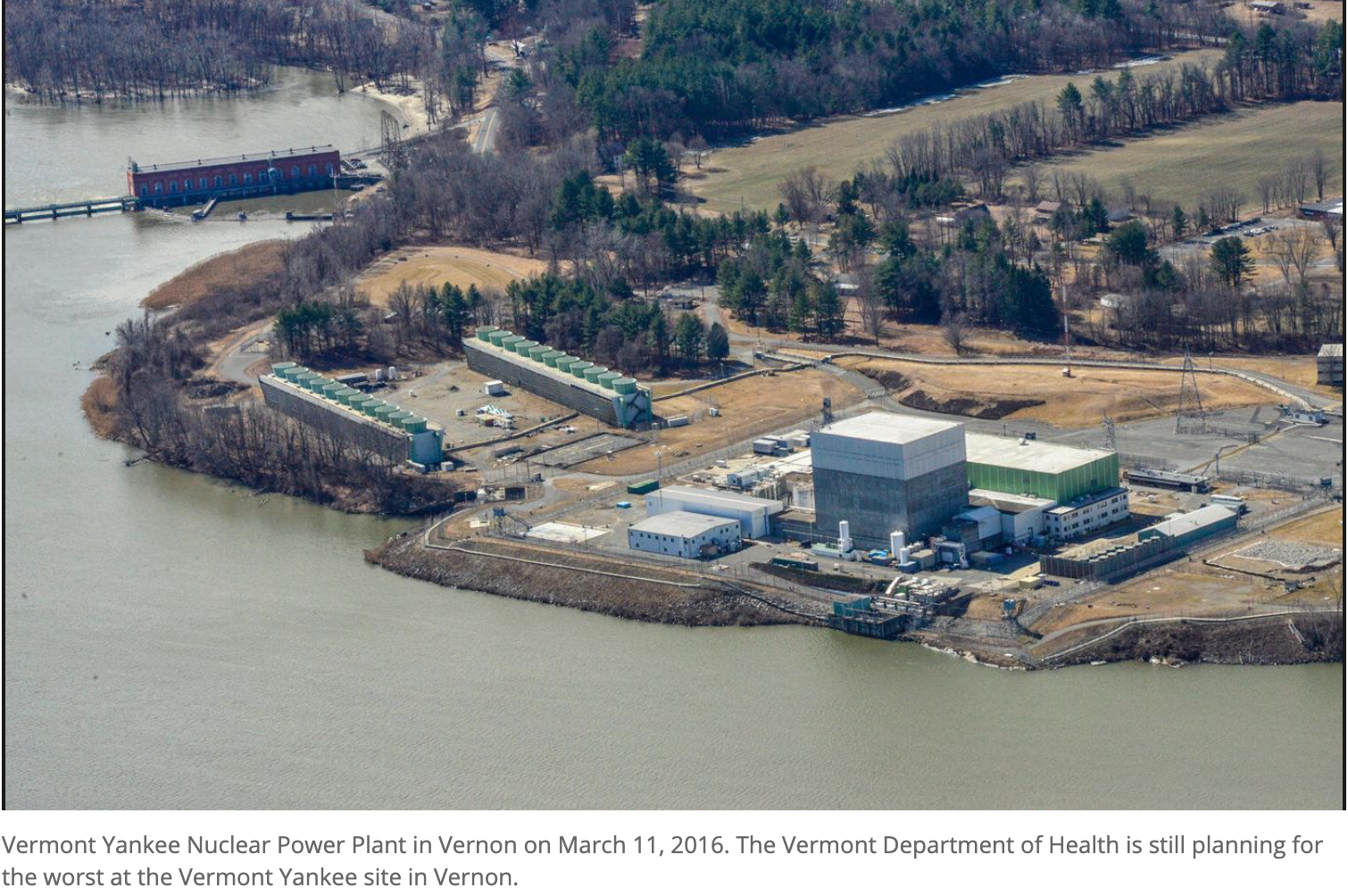
VERNON — The Vermont Department of Health is still planning for the worst at the Vermont Yankee site in Vernon.
But the worst, thanks to the active decommissioning of the Vermont Yankee site currently underway, is not as bad as it could have been six years ago, when Vermont Yankee shut down and its nuclear fuel was moved out of the reactor core and put into storage in giant steel and concrete casks.
“The Health Department’s Radiological and Nuclear Emergency Response Plan originally had a heavy emphasis on releases from Vermont Yankee, which could impact large areas and populations while it operated. Even with the shutdown of Vermont Yankee, we continue to maintain many of our resources for radiological emergency response,” said William Irwin, the state’s radiological health chief.
Texas bans storage of highly radioactive waste, but a West Texas facility may get a license from the feds anyway
The new law may soon be in conflict with federal regulators. A decision from the Nuclear Regulatory Commission on one company’s license could come as early as Monday.
BY ERIN DOUGLAS
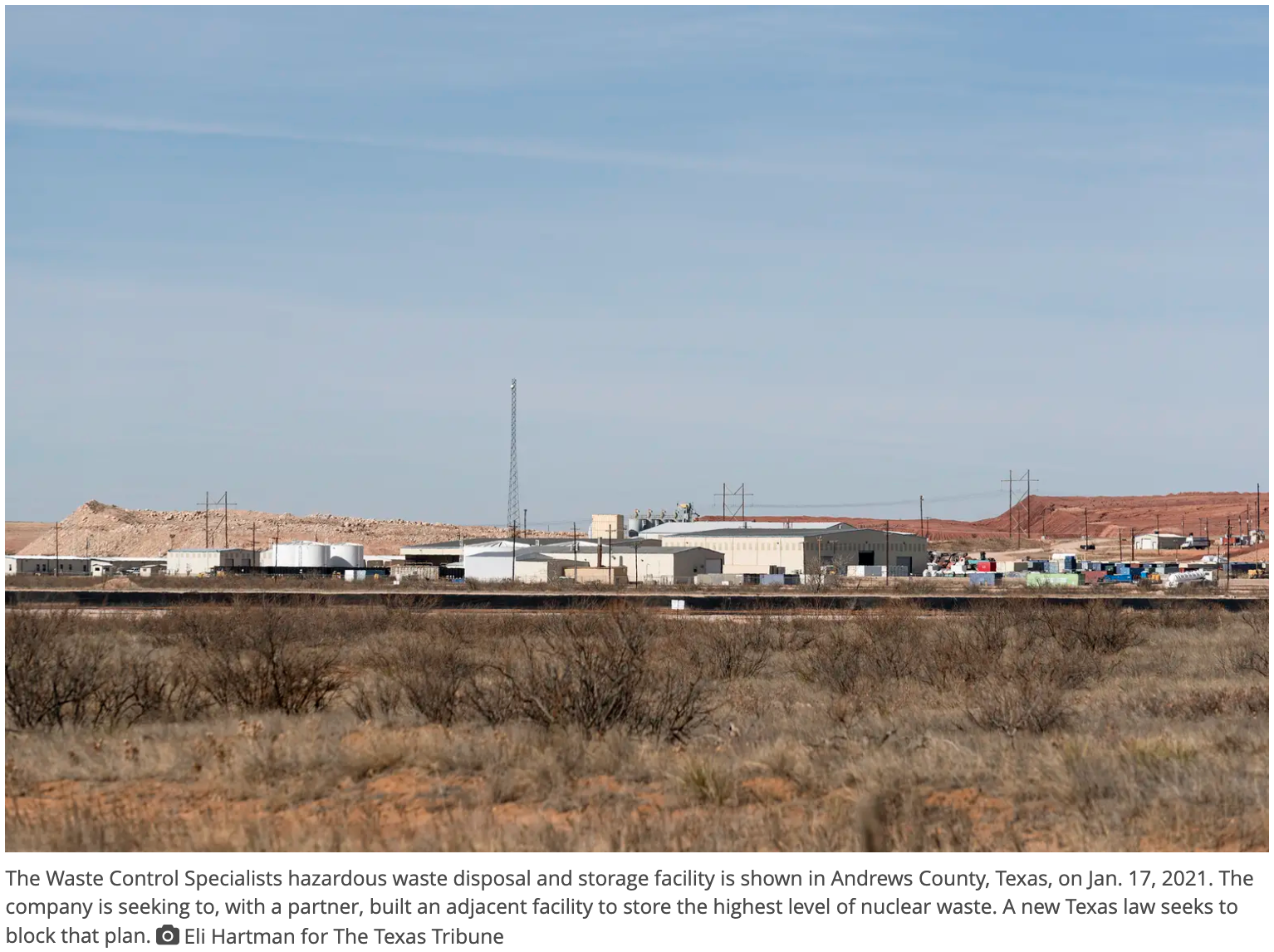
Gov. Greg Abbott on Thursday night signed a bill into law that attempts to block a plan to store highly radioactive nuclear waste at a site in West Texas.
House Bill 7 effectively bans highly radioactive materials from coming to Texas, targeting one company’s plan to build such a facility near the New Mexico border in Andrews County.
But, the new state law may soon be in conflict with federal regulators. The Nuclear Regulatory Commission is advancing the company’s application for a license to allow the high-level nuclear waste to Texas, and a decision from the federal agency could come as early as Monday, a spokesperson with the commission said.
For years, environmental and consumer advocates have protested a proposal by a West Texas company, Waste Control Specialists, to build with a partner an interim storage site for high-level nuclear waste, which is mostly spent fuel rods from nuclear power plants. Waste Control Specialists has been disposing of the nation’s low-level nuclear waste, including tools, building materials and protective clothing exposed to radioactivity, for a decade in Andrews County.
Continue reading
Lawmakers set for battle over next-gen nuclear missile
“For the W87-1, whose plutonium cores, or pits, are to be produced in part by the Savannah River Plutonium Processing Facility in South Carolina, at stake are jobs and billions of federal dollars to upgrade buildings or construct new factories. It’s all intertwined with shaky plans launched by the Trump administration to have Savannah River and Los Alamos National Laboratory in New Mexico produce a combined 80 pits per year by 2030.”
Joe Gould defensenews.com September 9, 2021
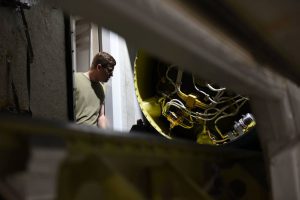
WASHINGTON ― Nuclear modernization opponents and defenders are gearing up to fight again over the next-generation intercontinental ballistic missile and other efforts.
Rep. John Garamendi, D-Calif., and a skeptic of nuclear spending on the House Armed Services Committee, confirmed he plans to offer nuclear-themed amendments when the annual defense bill receives House floor consideration later this month. One aims to pause the Air Force’s nascent Ground Based Strategic Deterrent in favor of maintaining the missile it would replace, the Minuteman III; another would zero out funds for the GBSD’s warhead, the W87-1.
“The bottom line is that we could pause the entire GBSD program and push forward into the future a $100 billion expense,” Garamendi, who chairs the House Armed Services readiness subcommittee, told Defense News.
With the Biden administration’s Nuclear Posture Review due early next year, Garamendi said the amendments are part of his “strategy to raise the issues, to gather the data, test the arguments against the opposition … and create an occasional success.”
More nuclear waste may be heading to WIPP on US 285
[WIPP is the world’s only operating underground nuclear waste dump. It is limited to nuclear weapons waste, but the federal government is trying to expand WIPP and break its promises and social contract with New Mexicans.
Help Us STOP FOREVER WIPP-Waste Isolation Pilot Plant. The nuclear waste dump is permitted to operate until 2024, but the Federal government wants to expand the amount and types of waste allowed with NO end date.
We need your help to protect New Mexico!]
“At a recent Santa Fe County Town Hall, activist Cindy Weehler of 285 ALL said the U.S. Department of Energy made it clear that it’s going to expand its nuclear waste program, she said. She said she’s concerned about the new type of radioactive waste that would be traveling through the county, which would be diluted plutonium, instead of contaminated items.”
BY ISABELLA ALVES / JOURNAL NORTH abqjournal.com Copyright © 2021 Albuquerque Journal
Spanning the length of the state, U.S. Highway 285 is a major thoroughfare for truck transports and other traffic. This busy highway, nicknamed “Death Highway” due to the number of fatal accidents on it, may get busier.
Concerned citizens in Santa Fe County recently called out the U.S. Department of Energy’s Waste Isolation Pilot Plant for expanding its mission in a permit renewal application to include more nuclear waste being shipped along the 285 corridor.
Part of Highway 285 goes along the southern edge of the city of Santa Fe, and local activists are calling on local and federal leaders to halt this increase in nuclear waste transportation.
The permit application is requesting to add two nuclear waste storage panels to WIPP that would increase the waste volume in these areas.
Montco offering potassium iodide tablets in the event of a nuclear emergency
Radioactive iodine, a contaminant that could be released in the event of a nuclear accident, can increase the risk of thyroid cancer. Potassium iodide (KI) can help protect the thyroid gland against radioactive iodine.
By Maria Pulcinella whyy.org September 8, 2021
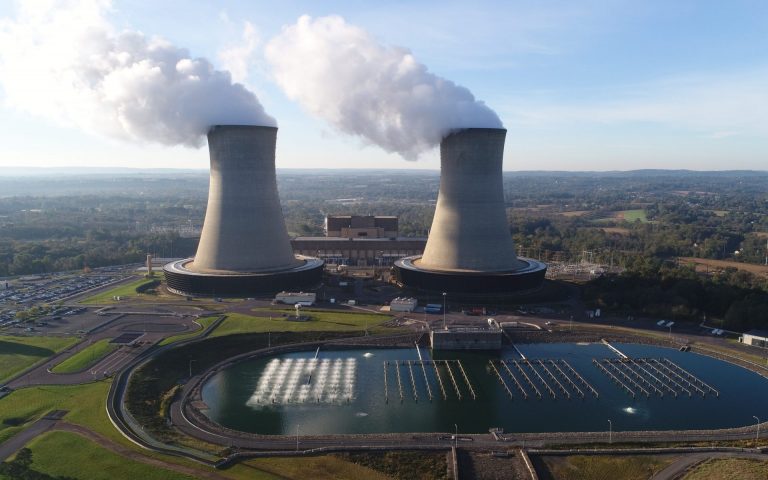
If you live, work, or attend school within a 10-mile radius of the Limerick nuclear power plant, local health officials have a freebie for you — albeit not a sexy one.
Montgomery County’s Office of Public Health will be handing out potassium iodide tablets to those in close proximity to the Limerick Generating Station.
The distribution is part of a statewide emergency preparedness effort — the Limerick site is one of Pennsylvania’s four active nuclear power plants.
General Assembly President calls for halt to nuclear tests
The President of the UN General Assembly, Volkan Bozkir, on Wednesday called for an end to nuclear tests, as ambassadors gathered to commemorate the International Day against Nuclear Tests, observed annually on 29 August.
UN News news.un.org September 8, 2021
Despite recent developments in advancing nuclear disarmament, more remains to be done, said Mr. Bozkir, urging countries which have yet to sign or ratify the Comprehensive Nuclear-Test-Ban Treaty (CTBT) to do so without delay.
Today we mark the International Day against Nuclear Tests, an opportunity to remember the victims of nuclear testing, honor the survivors and examine the legacy impacts of nuclear weapons, including that of nuclear waste. My full remarks here: pic.twitter.com/1onIGt3TJ5
— UN GA President (@UN_PGA) September 8, 2021
“More than 2,000 nuclear tests have been conducted since the advent of nuclear weapons. While the rate of testing has declined, they have not stopped,” he said.
“These tests have long lasting health and environmental consequences. They devastate the communities they impact. They displace families from their homelands.”
Progress on disarmament
Underlining the General Assembly’s commitment to nuclear disarmament, Mr. Bozkir welcomed progress achieved over the past year amid the challenges of the COVID-19 pandemic.
US attorney details illegal acts in construction projects, sealing the fate of the “nuclear renaissance”
“The indictment reveals important new information about how Benjamin and Westinghouse conspired to hide crucial information about reactor completion dates from the owners…It states that the defendant made “false and misleading statements” and “knowingly devised a scheme” to continue the project based on misrepresentations.”
By Tom Clements | thebulletin.org
VC Summer nuclear site in South Carolina, with operating unit 1 in the background and abandoned twin unit Westinghouse AP1000 nuclear reactor construction in the foreground; Tim Mousseau ©2018. Used with permission to the Bulletin of Atomic ScientistsThe ill-fated construction of new nuclear reactors in South Carolina—one of two such troubled Westinghouse reactor construction projects in the United States—was abruptly terminated on July 31, 2017, but the effort to determine legal accountability for the project’s colossal failure is only now hitting its stride.
The South Carolina legislature conducted hearings about the project’s collapse. But it has fallen to the United States Attorney for South Carolina to outline internal decisions that led to project abandonment—via court filings, plea agreements, and indictments. These filings are proving to be the best documentation so far of criminal behavior related to projects that were part of a much-hyped “nuclear renaissance” that began in the early-2000s but has since petered out in the United States.
On August 18, 2021, a second Westinghouse official was charged in a federal grand jury indictment filed with the court in Columbia, South Carolina. The charges outline “the scheme” to cover up key details about the problem-plagued project to construct two 1,100 megawatt (MW) Westinghouse AP1000 light-water reactors at the VC Summer site north of Columbia.
The project was initiated in May 2008 and gained final approval in February 2009.
According to the 18-page indictment, former Senior Vice President of New Plants and Major Projects Jeffrey Benjamin “had first-line responsibility for Westinghouse’s nuclear reactors worldwide.” He was charged, according to a news release, “with sixteen felony counts including conspiracy, wire fraud, securities fraud, and causing a publicly-traded company to keep a false record.” On August 30, the US attorney’s office announced that Benjamin would be arraigned on August 31.
In order for SCANA, parent of utility South Carolina Electric and Gas, to gain a federal production tax credit of $1.4 billion, essential to the financial viability of the project, both units had to be finished by December 31, 2020.
Benjamin and Westinghouse knew that the dates would never be met, but SCANA doggedly stuck with them given production-tax-credit pressure.The indictment reveals important new information about how Benjamin and Westinghouse conspired to hide crucial information about reactor completion dates from the owners, the publicly held utility SCANA, now defunct, and its junior partner, the state-owned South Carolina Public Service Authority (known as Santee Cooper). It states that the defendant made “false and misleading statements” and “knowingly devised a scheme” to continue the project based on misrepresentations via Westinghouse to the owners, state regulators, the Securities and Exchange Commission, investors, and ratepayers. Nervous SCANA officials played along with the inept cover-up efforts and passed on false and inaccurate information to regulators.
Benjamin, the fourth official to be charged, faces 20 years in prison and a $5 million fine. Issuance of the indictment suggests he intends to face trial rather than plead guilty—a risky proposition given the waste of $9 billion on construction of a project that delivered nothing to consumers (and potential jury members) but a series of nine rate hikes. While those hikes were eventually eliminated and further rate hikes were avoided, a small nuclear construction charge in current bills stands as an enduring reminder of the debacle.
On May 21, 2021, Carl Churchman, Westinghouse Electric Corporation vice president and project director, was indicted on the felony charge of making false statements to the FBI about the status of the project. He pleaded guilty on June 10.
In February, Kevin Marsh, former SCANA CEO, also entered a guilty plea in federal court for conspiracy to commit felony fraud. And Stephen Byrne, former SCANA chief operating officer and executive vice president, pleaded guilty in July 2020 to conspiracy to commit mail and wire fraud. Both gave false testimony numerous times to regulators.
The August 18, 2021 news release from the South Carolina US Attorney’s Office made clear that the investigation continues: “`This indictment with its attendant allegations and charges is another step toward justice for all those responsible for the VC Summer nuclear plant fiasco,’ said FBI Special Agent in Charge Susan Ferensic.”The two SCANA officials and Westinghouse’s Churchman are subject to five-year prison sentences and stiff fines but will likely face reduced sentences in exchange for fully cooperating with investigators, something required in their plea agreements.
Both Westinghouse and SCANA were eventually forced into bankruptcy. Westinghouse was acquired by Brookfield Business Partners, and SCANA vanished after an easy takeover by Dominion Energy, approved in December 2018. The fate of the debt-strapped, state-owned partner Santee Cooper rages on in the South Carolina Legislature.
One entity that will likely never be held responsible for the disastrous project that it authorized is the South Carolina Public Service Commission. Members of this body unanimously voted in favor of anything SCANA requested during the entire course of the project and balked at providing oversight as it fell apart. All were replaced by the Legislature at the end of their terms with new members, who have been less accommodating to utility requests.
Public interest intervenors were prescient in their early assessments of the project. Friends of the Earth, which intervened before the Public Service Commission against the project in August 2008, noted SCANA’s disregard for energy efficiency and alternative forms of energy. That organization predicted that the project’s fate would be what the US Attorney’s Office affirmed in the August 18, 2021 indictment: “from the outset, the Project was characterized by cost overruns and significant delays.” Likewise, toward the end of the project in June 2017, just after Westinghouse declared bankruptcy, Friends of the Earth and the Sierra Club filed a formal complaint detailing why the project must be canceled. As money hemorrhaged, the owners made that earth-shaking decision a month later. And the mighty crash still reverberates.
In Georgia, construction of the other AP1000 project, located at Plant Vogtle, stumbles along to massive cost overruns and significant schedule delays. A main difference between the projects: Georgia Power has a large enough customer base to absorb the financial blow of its struggling project. With cost projections for the two Vogtle units nearing a stunning $30 billion, finishing dates presented to the Georgia Public Service Commission remain open to question.
The Carolina and Georgia reactor projects went forward under laws related to “construction work in progress” that allowed financing charges to be billed to the ratepayers from the start of construction, long before the reactors were online. Both the South Carolina law, the Baseload Review Act, and Georgia’s Nuclear Energy Financing Act have been repealed.
The fault for the shocking AP1000 misadventure falls squarely on the shoulders of Westinghouse and the involved utilities. They all fell victim to their own reactor-promotion propaganda but lacked the technical and management competence to pull off the projects as envisaged. With pursuit of large light-water reactors in the United States all but dead, the nuclear industry is now endlessly touting an array of “small modular reactors” and a dizzying menu of so-called “advanced reactors,” all of which exist only on paper. It’s unclear if there’s a path forward for this nuclear renaissance redux, and if there is, whether taxpayers will be put on the hook for financing some of it.
Germany Calls on Iran to Resume Nuclear Talks
Informal negotiations stalled after Iran’s new hardline president was elected in June. Tehran has caused an international outcry in recent months over the broadening scope of its nuclear program.
“US President Joe Biden has signaled his eagerness to resume direct talks, but Iranian officials have yet to do the same.”
The German Foreign Ministry on Wednesday said it “vehemently” urged Iran to restart negotiations aimed at reviving a defunct nuclear deal.
“We are ready to do so, but the time window won’t be open indefinitely,” a ministry spokesman said.
The French foreign ministry made a similar statement later on Wednesday.
In 2015, Iran, the United States, United Kingdom, Germany, France, Russia, China, plus EU representatives, worked out a deal to place curbs on Iran’s nuclear program. The Joint Comprehensive Plan of Action (JCPOA) sought to prevent Iran from making nuclear weapons by restricting the extent to which it could enrich uranium, install nuclear centrifuges, and stockpile radioactive material. In exchange, the other signatories agreed to drop certain sanctions against Tehran.
‘A combination of failures:’ why 3.6m pounds of nuclear waste is buried on a popular California beach
The San Onofre nuclear power plant shut down years ago – but residents and experts worry what will happen with the waste left behind
The defunct San Onofre nuclear power plant near San Clemente, California. Photograph: Lenny Ignelzi/APMore than 2 million visitors flock each year to California’s San Onofre state beach, a dreamy slice of coastline just north of San Diego. The beach is popular with surfers, lies across one of the largest Marine Corps bases in the Unites States and has a 10,000-year-old sacred Native American site nearby. It even landed a shout-out in the Beach Boys’ 1963 classic Surfin’ USA.
But for all the good vibes and stellar sunsets, beneath the surface hides a potential threat: 3.6m lb of nuclear waste from a group of nuclear reactors shut down nearly a decade ago. Decades of political gridlock have left it indefinitely stranded, susceptible to threats including corrosion, earthquakes and sea level rise.
The San Onofre reactors are among dozens across the United States phasing out, but experts say they best represent the uncertain future of nuclear energy.
“It’s a combination of failures, really,” said Gregory Jaczko, who chaired the US Nuclear Regulatory Commission (NRC), the top federal enforcer, between 2009 and 2012, of the situation at San Onofre.
‘Star Wars’ no longer fiction
ABQ at center of research for tomorrow’s weapons
“Albuquerque, New Mexico, is the epicenter of directed energy research in the United States…If the arms race for directed energy indeed takes off, much of the action could take place in Albuquerque.”
BY RYAN BOETEL / JOURNAL STAFF WRITER Copyright © 2021 Albuquerque Journal August 20, 2021 abqjournal.com
Force fields protecting us from drones and missiles.
Guns that shoot lasers instead of firing bullets.
Rock ’em Sock ’em Robots zapping at each other on the battlefield.
A new report by the Air Force Research Laboratory titled Directed Energy Futures 2060 describes the sorts of “directed energy” weapons that may come to exist in the next 40 years. And the expected technology – much of which may be researched and developed in Albuquerque – is like something out of a science fiction movie.
Officials from multiple Department of Defense entities, partners with the North Atlantic Treaty Organization and other experts came together to write the report, which says the world is at a “tipping point.”
MOX failed. But plutonium pit production is different, argues NNSA exec.
“Even with a potential surge in production at Los Alamos, there remains uncertainty about that capability, especially with their history of outages,” U.S. Rep. Joe Wilson
By Colin Demarest cdemarest@aikenstandard.com postandcourier.com August 21, 2021
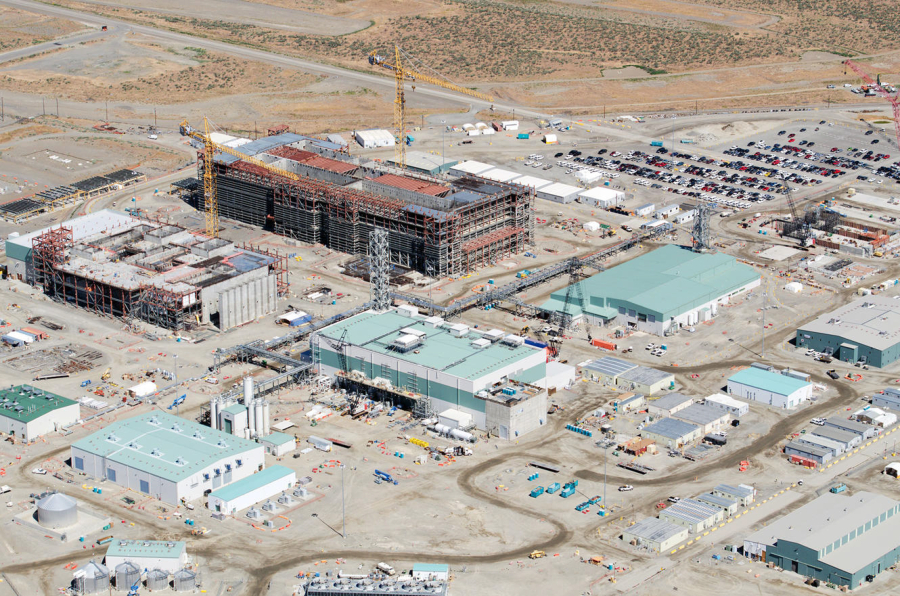
ALEXANDRIA, Va. — In late 2018, a behemoth fuel facility at the Savannah River Site was axed. Its cancellation, enabled by a court ruling and promises of saving billions of dollars, marooned more than a decade of work and vexed a clutch of South Carolina politicians.
What remained was a shell: a Mixed Oxide Fuel Fabrication Facility that was partially built and would eventually be secured and preserved, like an insect suspended in amber.
In the years that followed, the federal government began seriously pursuing a nuclear weapons mission – the crafting of warhead components known as plutonium pits — using the MOX skeleton as a springboard. That effort continues today, and at a clip some have likened to the Cold War or the Manhattan Project, the odyssey that birthed the nuclear age.
But where MOX failed, the Palmetto State pit factory will not, according Michael Thompson, a National Nuclear Security Administration executive. While bilateral friction and “higher-level policy choices” hamstrung the reactor fuel project, it’s a different matter when it comes to the plutonium cores and the Savannah River Plutonium Processing Facility, Thompson argued earlier this month.
Continue reading
We could all learn a lesson on disarmament from Archbishop Hunthausen
By Leonard Eiger nrconline.com
“I am grateful for having been invited to speak to you on disarmament because it forces me to a kind of personal disarmament. This is a subject I have thought about and prayed over for many years. I can recall vividly hearing the news of the atomic bombing of Hiroshima in 1945. I was deeply shocked. I could not then put into words the shock I felt from the news that a city of hundreds of thousands of people had been devastated by a single bomb. Hiroshima challenged my faith as a Christian in a way I am only now beginning to understand. That awful event and its successor at Nagasaki sank into my soul, as they have in fact sunk into the souls of all of us, whether we recognize it or not.”
Those are the opening lines of the “Faith and Disarmament” speech Seattle Archbishop Raymond Hunthausen delivered on June 12, 1981. Hunthausen had become active in resistance to the U.S. stockpiling of nuclear weapons and the new Trident submarine-based nuclear weapons system, which included the Bangor Trident submarine base in Puget Sound just 20 miles west of Seattle.
In that 1981 speech, Hunthausen referred to the Trident submarines based there as “the Auschwitz of Puget Sound.” In context, it was both a profound and prophetic statement of fact.
As Hunthausen said, “Trident is the Auschwitz of Puget Sound because of the massive cooperation required in our area — the enormous sinful complicity that is necessary — for the eventual incineration of millions of our brother and sister human beings.”

